How to Prevent Seasickness on a Cruise: 10 Effective Remedies
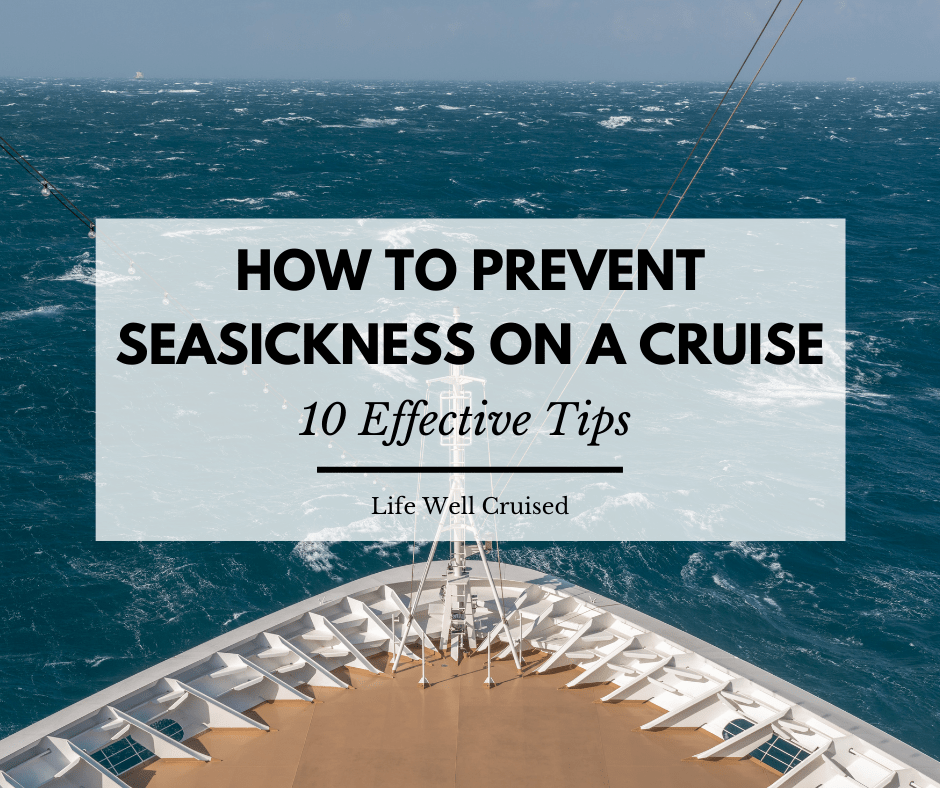
Sharing is caring!
If you’re going on a cruise and concerned that you might get seasick, you’re not alone. Asking “how to prevent seasickness on a cruise” , is one of the most common questions people have when planning a cruise.
After all, getting seasick really could ruin your vacation. While it’s less likely to happen on today’s large, modern cruise ships, I can tell you from personal experience, it does still happen.
The good news is that there are effective remedies for motion sickness, and these work very well on a cruise.
In this post, I share 10 ways to prevent, treat and ideally avoid seasickness altogether while cruising. I’ve included recommendations for seasickness medications, as well as natural remedies that really work.
As well, we’ll go through some frequently asked questions about how to manage seasickness on cruise ships. With these tips, you’ll be prepared to deal with the motion of the ocean, and prevail!

Seasickness on a Cruise
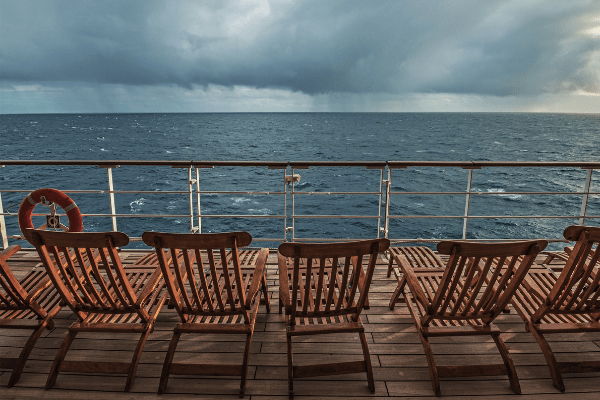
First, let’s go through what to expect if you do get seasick while on a cruise.
What are the symptoms of seasickness?
The symptoms of seasickness on a cruise can include feeling dizzy or having a headache. You may have also feel nauseous, have stomach cramps and even vomit.
For me, early symptoms of motion sickness include lightheadedness and a mild queasy feeling. I try and catch it at this early point, and after more than 20 cruises, this has worked for me.
The tips that I share below will help you to manage any seasickness symptoms.
Why does motion sickness happen on a cruise ship?
How come people get motion sickness on a cruise? Motion sickness happens due to repeated or continuous movement that affects our inner ear and sense of balance. As the cruise ship sails, some people can be affected by this motion.
Seasickness is another way to motion sickness, but on a cruise ship. You may also have heard the expression, “mal de mer”, which is French for sickness of the seas.
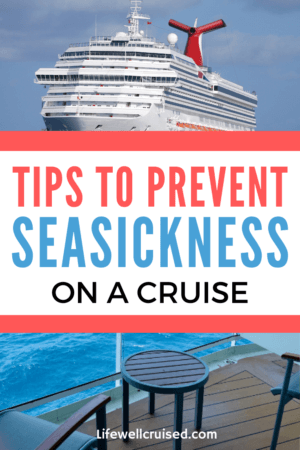
How likely are you to get seasick on a cruise ship?
Even though concerns about getting seasick on a cruise is a very common worry, especially for first time cruisers , most people will be fine. Modern cruise ships are built with stability and comfort in mind, and have stabilizers which are used, especially in rough seas.
However, you may feel some motion or slight vibration while on a cruise. I mention this as we were a bit surprised to find this out on our first cruise.
So many people said “you won’t feel the ship move” . They mean well, but on some cruises you’ll feel more movement then others, so it’s best to be prepared.
In some cases, the ship can hit rougher seas and high winds, and there will be some rocking. However, let me assure you that a large cruise ship will feel nothing like the movement on a small boat or even a ferry.
How to Prevent Motion Sickness on a Cruise
This post contains affiliate links which means if you click and buy that I may make a commission, at no cost to you. Please see my disclosure policy for details.
Life Well Cruised is a participant in the Amazon Services LLC Associates Program, an affiliate program designed to provide a means for sites to earn advertising fees by advertising and linking to Amazon.com.
One of the best ways to deal with seasickness on a cruise, is to prevent and avoid it if at all possible. These 10 seasickness prevention tips are ones that have worked for us, as well as many avid cruisers and crew.
1. Pick the right cruise cabin location
Before we get into what seasickness medications work best and some other tips and tricks, we should talk about cruise cabin locations.
To prevent seasickness, be sure that you choose the best stateroom location possible. If you’re new to cruising and unsure how you’ll feel, choose a mid-ship location.
These are the most desirable cabins because there will be less movement in the middle of the ship. Whether you choose an inside cabin , or a balcony cabin , try and choose a cabin that is as center as possible.
If a mid-ship cabin isn’t available, then opt for an aft cabin or mid-aft stateroom. If at all possible, try to avoid a forward cabin , as many cruise passengers report feeling more motion in this location.
A travel agent can help you to pick the best cabin for you, and look out for any other cabins to avoid .
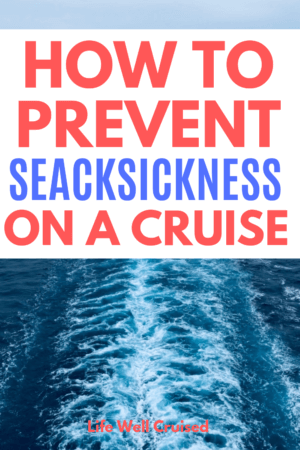
2. Pick a “calm” cruise itinerary
While the seas can be unpredictable, there are some cruise itineraries that generally have calmer seas, than others. If you’re concerned about getting seasick, avoid trans-Atlantic crossings and other itineraries where the seas can be fierce.
Your travel agent will be able to help you navigate the possibilities (pun intended), as a rule of thumb, the Western Caribbean and the Gulf of Mexico tend to have more stable seas.
3. Green Apples

Would you like to know a cruise tip that really works to get over seasickness on a cruise? Eat a granny smith or green apple.
This has long been a favorite crew and passenger tip. In our experience, it really does help.
Often, eating a green apple will settle the stomach if you start to feel nauseous due to seasickness. Apparently, the pectin in green apples helps to neutralize acid in the stomach, and the natural sugar helps settle the stomach
You’ll find green apples in the buffet, so it’s a good idea to take a couple back to your room, in case you need them later on in the cruise.
4. Ginger candies

Another natural remedy for dealing with motion sickness while cruising is ginger. If you don’t want to eat raw ginger, you can buy ginger candies or even dried, sugar coated natural ginger.
Some cruise lines, such as Cunard , even give out ginger in the evening with dinner when the seas are rough.
While I prefer not to eat raw ginger, I always bring some ginger candies and usually find them very effective in preventing seasickness before it starts.
Recommended: Ginger candies – organic and gluten free (Amazon)
5. Bonine or Dramamine

An over the counter medication like Bonine or Dramamine, can be highly effective to deal with symptoms of seasickness, so you can enjoy your cruise.
In our experience, worked very well, alleviating seasickness symptoms without drowsiness.
Make sure to bring a pack or two your toiletry bag or cruise first aid kit . This way, if you need it you won’t have to hope the shop is still open on the cruise ship.
Recommended: Bonine Motion Sickness prevention tablets (see Amazon reviews & price here)
6. Seabands

A favorite cruise essential for many, seabands are wristbands that alleviate motion sickness symptoms. They work with acupressure buttons to prevent symptoms of seasickness and many cruisers have very good results. Seabands are natural and contain no medication, plus, they’re reusable.
If you think that you may be prone to motion sickness, it’s a good idea to take along seabands for both adults and children , in case.
Recommended: Seabands (check on Amazon for variety packs)
7. Motion Sickness Patch/Scopolamine
If you’re prone to motion sickness, scopolamine patches, which are placed behind the ear, are very effective in preventing seasickness.
They are a preventative treatment, and should be used ideally before symptoms begin, and need to be changed every 3 days. They may only be available by prescription, so talk with your doctor to see if they’re right for you.
There are also non-prescription seasickness prevention patches available, that many use and find effective. Check out the information and reviews to learn more.
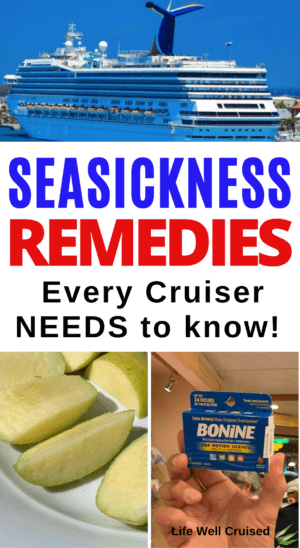
8. Acupuncture
Another preventative treatment for motion sickness on a cruise is acupuncture . An alternative treatment, it’s effectiveness isn’t conclusive. Anecdotal reports suggest many patients have had good results.
My mother-in-law, who also suffers from vertigo periodically, uses acupuncture before she goes on a cruise. I’ve been on cruises with her, and have seen how it definitely worked for her. She was well and unaffected, even while others were swaying and turning green during an evening of very rough seas.
If you already use acupuncture, you may want to ask your practitioner if he or she thinks it will help to prevent seasickness on your cruise. As always, please do check with your physician.
9. Keep hydrated
It may sound simple, but keeping hydrated by drinking a lot of water will help prevent feelings of seasickness. While on a cruise you may be getting too much sun and even drinking too many alcoholic drinks, which can lead to becoming dehydrated.
By keeping hydrated, your body will be at it’s best and less prone to nausea, headaches, dizziness and upset stomach. It’s also helpful to avoid very fatty or spicy food.
Cruise tip – Bring along a refillable water bottle , to stay hydrated on your cruise.
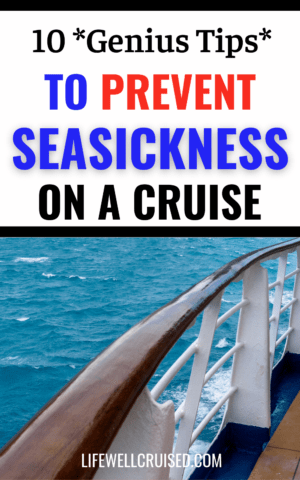
10. Get fresh air
If you suddenly start to feel unwell, with symptoms dizziness and nausea, try and get fresh air as soon as possible. A good place to sit is on the Lido deck, near the mid-ship pool. This location, in the open space and with a sea breeze, is probably the best place to grab a green apple and wait for symptoms to subside.
There is also advice to look at the horizon. This may work for some, however in our experience, if there are large waves, this may do more harm than good.
A word of caution – often taking medication to remedy or even prevent motion sickness symptoms as soon as they start is most effective.
Best Motion Sickness Medication for a Cruise
As a recap, these are the most effective and recommended seasickness medications and natural remedies for a cruise (all Amazon links).
Seabands (for adults)
Seabands (for children)
Dramamine (long lasting nausea relief)
Dramamine for kids (see choices on Amazon)
Ginger candies
Motion sickness patches
Watch our YouTube video below for more tips on preventing seasickness while cruising
Recap: How to Prevent Seasickness on a Cruise
A common concern for new cruisers, is how to avoid and prevent getting seasick on a cruise. In this post, we went over what to expect on a cruise, and how likely it is to feel symptoms of motion sickness on a modern cruise ship.
We also shared 10 effective tips for preventing and dealing with seasickness on a cruise. The remedies include both seasickness medication and natural remedies, that have been shown to be useful and helpful for cruisers.
Don’t forget to pack some seasickness medication or prevention treatments to bring along on your cruise vacation.
Have you ever been seasick on a cruise? What tips, medications or treatments did you find worked best?
Happy cruising!
P.S. If you enjoyed this post and found it helpful, please don’t keep it to yourself ;-). Please share on Facebook or PIN to your favorite Pinterest board (share buttons at the top). Thanks so much!
What to Pack for a Caribbean Cruise
31 Cruise First Aid Kit Essentials You Need to Have
What Toiletries to Pack for a Cruise (packing list)
25 Cruise Essentials Most Popular on Amazon
21 Things People Forget to Pack for a Cruise (and regret)
30 Cruise Cabin Hacks Every Cruiser Needs to Know
Let’s connect:
Follow me on Facebook at Life Well Cruised
Follow me on YouTube at Life Well Cruised (Vlogs and cruise tips)
Follow me on Pinterest at Life Well Cruised
Follow me on Instagram at Life Well Cruised
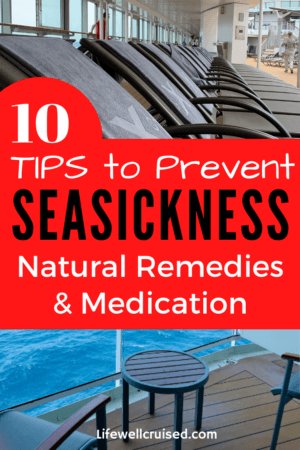
15 Comments
I read this article prior to going on a cruise to the Bahamas and found some of these tips very helpful. When searching for an acupressure band I came across NoMo Nausea at CVS. It is an silicone acupressure wristband that is infused with peppermint essential oils. I have tried sea bands before and while they provided slight nausea relief for me, I found the peppermint scent combined with the acupressure to work more effectively when reducing my sea sickness. Hope this helps for others who also experience seasickness!
Hi Juliette,
Firstly, thanks so much for reading this and then taking the time to come back and add your suggestion. That’s really interesting – I’ll have to keep an eye out for a seaband combined with that scent.
I’m sure your personal suggestion will be helpful to someone.
Hope you enjoyed your cruise!
Hello! Thank you for all the great information.. Another thing that helps with seas sickness is lime. Slicing and smelling the lime really works. I learned this on a snorkeling trip in Mexico. I want feeling well from all the bobbing in the water and was given lime by the locals and in a short time I was feeling myself again. On my last cruise I asked my waiter to bring me lime slices as the dining room was in the front of the ship and soon the entire table was enjoying the lovely sent of lime and feeling great!
Thanks so much for this! Great info!
Glad the info was helpful Becky. Have a great cruise!
- Pingback: What You Need to Know if You're Cruising Out of South Florida - Coastlines to Skylines
I love using Motioneaze oil. You rub it behind your ear and it really works! Expensive on the ship but not too bad on Amazon or at CVS.
Thanks Tricia. I’ve never heard of it or used it, but that sounds great.Great tip to pre-buy rather than get it on the ship.
I appreciate you taking the time to comment 🙂
Ilana and Tricia – I experienced fairly serious motion sickness on our 2nd sea day — I wasn’t the only one, as the ship staff stocked those “special bags” everywhere.. Nevertheless, I was wearing seabands, I took Dramamine; tried all sorts of remedies and preventives; and nothing worked all day until my friend gave me Motioneaze. Within minutes of applying this behind my ears, I felt immensely better. (It’s possible that the seas were finally calming by then!). Thank you for great posts!!!
Thanks for sharing the recommendation!
Tricia,, I have never heard of this, going to check it out. Thanks so much!
My understanding is that it is good to look at horizon so your eyes and ears “agree”. It works for me.
That’s awesome and good advice. That works for me, but my husband will feel more sick. I have a feeling it’s because the wobbly feeling has already set in.
Thanks Patty for the comment – I know it will be helpful to others 🙂
Dramamine now makes a “Non-Drowsy Naturals” version of their motion sickness pills. I have always found that regular Dramamine and Bonine make me feel very sleepy (even the non-drowsy formulas). However, I was able to take the Dramamine Naturals version (made with ginger) and it worked just as quickly on the motion sickness and did not make me drowsy at all.
That’s great to know Melissa. Thanks so much for sharing how well this worked for you. I love ginger so perhaps I’ll try it next cruise 🙂
Leave a Reply Cancel reply
Your email address will not be published. Required fields are marked *
This site uses Akismet to reduce spam. Learn how your comment data is processed .
How to Prevent Seasickness on a Cruise – 12 Best Tips
Aug 12, 2023 | CRUISE TIPS

Introduction
It is hard to understand what causes motion sickness or seasickness on a cruise in some people but not in others. It can be quite debilitating for the unlucky. Some folks just don’t suffer from motion sickness at all and enjoy the roughest of seas while continuing their daily eating and drinking routine. Some people love the gentle movement of a cruise ship in rough seas as they say it has an almost calming effect and actually helps them relax.
Eventually, most people get their sea legs and wonder what the fuss is about. The good news is that there are effective remedies for motion sickness, including seasickness, which work very well on a cruise. So, there is no need to worry or suffer while getting acclimatized to sailing the seven seas when it is so easy to avoid seasickness.
‘Prevention is better than cure’ is often attributed to the Dutch philosopher Desiderius Erasmus in around 1500, but it is still true today.

In this post, we share 12 ways to prevent, treat, and ideally avoid seasickness while cruising. We have also included recommendations for seasickness medications and natural remedies that, from our experience, work well. But first, let’s examine the science behind seasickness or motion sickness and how it may affect you.
Understanding the causes is the first step in preventing seasickness on a cruise, boat, or ship.
What causes seasickness or motion sickness on a cruise ship?
The ancient Greeks and Romans were aware of motion sickness. Even NASA has made a note of it. So if you suffer from motion sickness, you’re not alone and are part of a long tradition.
You get motion sickness or seasickness when there are conflicts with your senses. For example, if you’re on a ride at the fair, and it’s spinning you around, and upside down, your eyes see one thing, your muscles feel another, and your inner ears sense something else.
Your brain can’t cope with all those mixed signals. That’s why you end up feeling dizzy and nauseous.
Your ears play help control your sense of balance. They are part of a network called the vestibular system. This system includes three semicircular canals and two sacs, called the saccule and the utricle. They send information about what’s going on around you to the Brain .
The semicircular canals hold a fluid that moves with the turns of your head. The saccule and utricle are sensitive to gravity. They tell the Brain whether you’re standing up or lying down.
Your Brain takes in all this data, and it usually comes together and makes sense. But sometimes, your Brain gets confusing signals.
For example, if you are flying in a plane, you feel like you’re moving, but your eyes tell your Brain that you don’t appear to be going anywhere. The opposite is true as well. After a long sea voyage, you can stand still on dry land but still feel like you’re moving. The result is the same: motion sickness, aka seasickness.
What are the symptoms of seasickness?
Seasickness on a cruise symptoms vary from person to person, and some people don’t suffer at all. The symptoms on a cruise can strike quickly and make you break out in a cold sweat and feel like you need to throw up. Other common symptoms include:
- Increase in saliva production
- Loss of appetite
In addition, some people get headaches, feel tired, or have shallow breathing.
How likely are you to get seasick on your cruise?
A common concern, particularly for new cruisers, is the likelihood of getting seasick on a cruise. Symptoms usually don’t last long for most people. They often go away once you get used to the situation, whether it’s the rocking of a boat or the movement of a train.
Modern cruise ships are designed with a particular focus on guest comfort and have computer-controlled stabilizers to counteract the ship’s movement. Larger vessels are less prone to movement than smaller ships. However, you may feel some motion while on your cruise, which is normal.
Pre Cruise Advice
Double-check your stateroom location.
Before making the final payment for your cruise, check the ship’s deck plan. Just because you paid for an inexpensive cabin doesn’t mean you are on a low deck, as sometimes the cruises lines upgrade you if space is available. Also, don’t choose a stateroom at the front (bow) or back (stern), even on a low deck. It doesn’t matter how low or high you are; these are the two areas on the ship that moves the most, particularly on high seas. It can get noisy in these locations as well!
TALK TO YOUR DOCTOR
If you are concerned about seasickness, make an appointment to see your doctor. Discuss your concerns and ask him to recommend one of several over-the-counter motion sickness medications or prescribe a motion sickness patch (scopolamine) or similar. Also, ask about natural remedies for seasickness like Ginger. Some cruise lines like Cunard provide ginger candy as you leave the restaurant.
When on board your ship, if you are suffering from seasickness, you can ask the ship’s doctor for a shot which usually works wonders and sorts you out in no time.
How to Avoid Motion Sickness on a Cruise
So we have learnt all about the science behind motion sickness or seasickness, and now we will take a look at our top tips and trick on how to avoid seasickness. Of course one of the best ways to deal with seasickness on a cruise is to prevent and avoid it if at all possible.
So here are our top seasickness prevention tips on how to avoid getting seasick on a cruise so you can go on to get maximum enjoyment whilst at sea.
Use Wrist Bands
If you don’t like the idea of medication, why not try motion sickness Wrist Bands, which are proven to alleviate motion sickness and allow you to enjoy travelling and cruising in particular.
One example of this is Sea-Band, a knitted elasticated wrist band, which operates by applying pressure on the Nei Kuan acupressure point on each wrist by means of a plastic stud. Because the bands do not use drugs, they do not cause any of the side effects associated with anti-nausea drugs and can be worn on each wrist whenever you feel nauseous. They are suitable for adults and children.
Examples of Motion Sickness Wrist Bands for Adults, Mums to be and Children can be found here:

Choose Lower Decks
Interestingly, many cruise lines have their most luxurious (and expensive) staterooms and suites on the highest decks, which is not the best place to be if you are prone to motion sickness, so watch out for this. Book a stateroom or suite on a low deck and in the middle of the ship (Midships).
Try to avoid an inside stateroom, so one with an Oceanview or a balcony is good. It is always a good idea to book early to ensure you get the best choice of staterooms. Avoid Guarantee Fares as you never know where you may end up on the ship. These fares get offered when the best staterooms have gone, and the cruise lines have only a limited choice of space left.
Don’t Lock Yourself in your Stateroom
Get out and walk the promenade or stretch out in a sun lounger with a cup of tea or plain water. While it may be tempting to scale the rock-climbing wall, you may want to reconsider until your seasick “wave” passes. Avoid staying locked up in your stateroom. You may want to avoid any designated smoking areas on ships that allow smoking, which can only make you feel worse.
Get Some Fresh Air
If you’re trying to get by without medication and start to feel a bit queasy, a good solution is to get out on the deck and stare at the horizon.
This age-old technique is a proven technique and easy to do. Despite the movement of the ship, staring at the horizon and focusing on it does wonders to stop you from feeling poorly. The other sure-fire way to fix seasickness is to sit under an Apple Tree!!
Don’t Drink too Much Alcohol
While some people feel better after a drink or two because it may help calm their nervousness about becoming seasick, like anything to excess, it can have adverse reactions, especially if you are taking any motion sickness medication. Stay off the booze for a while…
Keep Eating
Do try to keep your stomach full despite the urge not to eat if you start to feel queasy. Eat simple foods, non-greasy and non-spicy, which will help prevent nausea. Don’t overeat, though. Ginger is good for calming seasickness, and as mentioned, some ships will have this available when you leave the restaurant.
Choose Calmer Waters for Your Cruise
One way to reduce the risk of seasickness on your cruise is to look at itineraries that take in calmer waters. It’s a fact that more intense waters with strong or unpredictable currents will make for much more motion and increase the potential for seasickness while on your cruise. Alaskan cruises and Caribbean cruises are generally better options. Be sure to avoid the Caribbean hurricane season.
While the seas can be unpredictable, some cruise itineraries generally have calmer seas than others. If you’re concerned about getting seasick, avoid the Bay of Biscay, trans-Atlantic crossings and other itineraries where the sea can sometimes be quite rough.
All good travel agents can help and guide you through the various options available and share their own experiences with you.
Try Some Ginger
The top remedy recommended by anyone who works on a cruise ship is Ginger. This natural remedy seems to calm upset stomachs and reduce nausea. Anything with Ginger will do the trick, including non-alcoholic Ginger Beer, raw Ginger, Ginger candy and Ginger tea.
Some cruise lines, such as Cunard , offer Ginger candy in the evening after dinner when the seas are rough.
Recommended Products include the following:

Stay Hydrated
It may sound simple, but keeping maintaining your fluid intake is another big help in avoiding seasickness. Dehydration is recognised as a major trigger for motion sickness.
Seasickness and related medications cause dehydration and headaches. Drink water, low-acidity juices like apple and carrot, or clear soup, and avoid milk and coffee. Stay hydrated by drinking lots of water will help prevent feelings of seasickness and nausea. It is quite often the case, when you are on a cruise you may get too much sun and most likely drink too much alcohol, which can lead to becoming dehydrated.
By keeping your body hydrated, you are less likely to suffer from nausea, headaches, dizziness and upset stomach.
Top Cruise tip – Be sure to take a refillable water bottle, to stay hydrated on your cruise.
Current bestsellers include the following:

Eat a Green Apple
A great little cruise tip that works to help get over seasickness on a cruise is to eat a green apple. A firm favourite with crew and passengers, anecdotal evidence suggests eating green apples can help with seasickness.

Green apples can help prevent seasickness on a cruise
Green apples are incredibly high in pectin , a soluble fibre that turns water into a thick gel in your intestines. This slows down your digestion and settles your stomach. Green apples are also high in fructose, or plant-based sugar, which helps keep your energy levels up.
So humble green apples can be a great way of warding off that queazy feeling of seasickness.
Bonine or Dramamine
Popular over the counter medications like Bonine or Dramamine can be highly effective in dealing with the prevention and symptoms of seasickness, helping to enjoy your cruise.
In our experience, this option worked very well, alleviating seasickness symptoms without causing any drowsiness.
It is always a good idea to take a pack or two as part of your cruise medical kit. Don’t wait to buy them onboard your cruise as you can be sure the shop will be closed just when you need them.

Motion Sickness Patches
If you’re prone to motion sickness, scopolamine patches, which are placed behind the ear, effectively prevent seasickness.
Ideally used before symptoms begin, these patches are a preventative treatment and must be changed every three days. They may only be available by prescription, so talk with your doctor to see if they’re right for you.
There are also non-prescription seasickness prevention patches that many people use and find very effective. Please take time to explore the reviews to learn more HERE
Consider Acupunture
Acupuncture probably isn’t at the top of the list when it comes to treatments for motion sickness, which is odd as it used the same meridian points that respond to acupressure, which is used in Wrist Band/Sea bands. Perhaps it is the thought of the ‘needles’ that puts people off, but who knows.
The National Center for Complementary and Alternative Medicine (NCCAM) provides useful background information on acupuncture as a cure for seasickness.
As always, please do check with your doctor before embarking on any form of acupuncture.

Acupuncture can help prevent seasickness on a cruise
Don’t leave it until it’s too late!
If you ignore the signs and seasickness sets in, it’s a challenge for even the best medication to relieve it quickly. If you are at all concerned, remember better be safe than sorry.
Follow the instructions and take your medication before the ship sets sail. By the time you are out to sea, the chance of feeling seasick will be greatly reduced. You can prevent getting seasick.
Frequently Asked Questions (FAQ’s)
How do you not get seasick on a cruise.
Tips to avoid getting seasick on a cruise ship
- Get a cabin in the middle of the ship and as low as you can go. …
- Drink plenty of water.
- Keep something in your stomach. …
- Get as much fresh air as possible on one of the top decks.
- Look out over the forward part of the ship. …
- Keep an eye fixed on the horizon.
What is the best thing for seasickness on a cruise?
According to many guests, some of the best seasickness tablets for a cruise include Dramamine or Bonine . These medications can be taken before nausea arises to help lessen the severity. They may also be taken to ease the feeling of sickness as it occurs. Be aware that these may cause drowsiness in some guests.
How likely are you to get seasick on a cruise ship?
How Common is it to Get Sick on a Cruise? 15% of people have reported feeling seasick while onboard. In our experience, we can add another 10% of passengers that will suffer from other illnesses, such as colds, flu and hangovers.
What is a trick to avoid seasickness?
Get fresh air . If you are feeling seasick, it is often helpful to go out on an open deck or balcony and look toward the horizon. Doing so helps your eyes “see” the motion, which will then send signals to the brain more in alignment with what the inner ear is “telling” the brain.
Last update on 2024-08-11 / Affiliate links / Images from Amazon Product Advertising API

Welcome all cruise enthusiasts! We’re Mike & Anita, your spirited guides to cruising the high seas (and Rivers), and we’ve clocked in over 600 days at sea.
This blog is dedicated to all you cruise lovers out there. It is a place to dive into the wonderful world of cruising. Join us on this exciting voyage where we share not just tips but insider secrets and money-saving gems about cruising.
Whether you’re a seasoned sailor or a first-time cruiser, get ready to explore, learn, and soak up the joy of our seafaring adventures. Happy Cruising! 🚢✨
Find Out More
BEST SELLING CRUISE BOOKS

You might also like ....

- Regent Seven Seas Cruises
- Seabourn Cruise Line

Subscribe For Updates
We really do hope you enjoy our blog and all that we have to offer. Don't miss out on our latest money-saving tips and tricks by joining our mailing list and becoming a Smart Cruiser!
We promise not to spam you and you can unsubscribe at any time...
You have Successfully Subscribed!

Subscribe To Our Newsletter
Join our mailing list and become a Smart Cruiser!
Pin It on Pinterest
This is the announcement bar for Poornima to test the Close Button. It will expire May 31 2024.
- Pre-Cruise FAQ
- Onboard FAQ
- Post-Cruise FAQ
- Cruisetours FAQ
- Special Offers Sign Up
- Cruise Deals
You have been logged out
Your window will update in 5 secs
Best Motion Sickness Medicine for a Cruise
The best motion sickness medicine for cruises will be different for everyone. All our ships are well-stabilized and bear plenty of weight so most guests don’t even feel like they’re moving. That said, certain guests may be more prone to feeling motion than others — like they would in a car or plane. While some find relief with devices like patches and wristbands, others prefer drinking water and getting fresh air. Here are some of the best remedies for tackling motion sickness on a cruise.
Bring Nausea Relief
If you’re more sensitive to motion sickness on cruises, stay prepared with store-bought solutions. Some of the most popular products include skin patches and wristbands. Patches are typically placed behind your ear where the medication can more easily absorb into your skin. Since the patches are hidden, you don’t have to worry about them distracting from your dinnerware wardrobe or photos from your shore excursions. Similarly, the bands are worn on the wrist and target pressure points to help stabilize your body. These products are usually waterproof so no need to remove them before enjoying the pools on board.
According to many of our guests, some of the best seasickness tablets for a cruise include Dramamine or Bonine. These medications can be taken before nausea arises to help lessen the severity. They may also be taken to ease the feeling of sickness as it occurs. Be aware that these may cause drowsiness in some guests. Please consult a medical professional to determine whether this is the best solution for you. Whether you want to prevent nausea or help alleviate it in the moment, considering adding all of these therapies to your cruise packing list and stay prepared for any situation.
Step Outside for Fresh Air
One of the easiest ways to relieve nausea while on board is stepping outside to get fresh air. That’s why we recommend booking a room with a balcony to guests who are more prone to feeling motion sickness. Slip outside at any time of the day from the comfort of your stateroom. Or, lie down on your lounge chair undisturbed by other guests. Focus on the refreshing breeze and before you know it you’ll be ready to dive back into onboard activities.
Drink Plenty of Water
Sometimes, a glass of water is the only relief you need. Many guests have shared that regularly drinking H2O during the day helped keep nausea at bay. Whether you’re relaxing poolside or grabbing a slice of the best pizza at sea, there are always refreshments nearby. If you don’t know where to go, just find one of our friendly crew members who will be happy to assist you.
Visit the Lotus Spa®
For the ultimate remedy, retreat to the Lotus Spa® , where skilled therapists can relieve any maladies. Upon visiting the spa, let our staff know what symptoms you’re experiencing and they can recommend the best treatment for you. Experience the healing powers of acupuncture which can precisely target pressure points. Indulge in a relaxing massage to help soothe areas of tension. Or, treat yourself to a hydrating facial and let the feelings of nausea wash away.
All our ships were designed to deliver seamless voyages to every destination. If you’re prone to feeling motion sickness on a cruise, don’t let that get in the way of your world travels. Stay prepared with the best medication for seasickness on a cruise and set sail with Princess.

- Food & Drink
- How to Plan
- Shore Excursions
- Onboard Activities
- What to Expect
How to Avoid Getting Seasick on a Cruise
By Carnival Cruise Line
Pack Your Medicine
- Get a Good Night’s Sleep
Remember to Eat
Get Some Air
Watch the Horizon
Avoid Books and Screens
Head to the Middle
Try Acupressure
Look Into Alternative Medicine
There is little better in life than sitting back and enjoying a cruise on the open sea. From the fun onboard activities to the amazing exotic locations, there’s a lot to love about traveling with Carnival cruises . However, the last thing you want is for your wonderful trip to be ruined by something you can’t control. If you are inclined to motion sickness but want to ensure an enjoyable cruise, take the following steps to avoid seasickness.
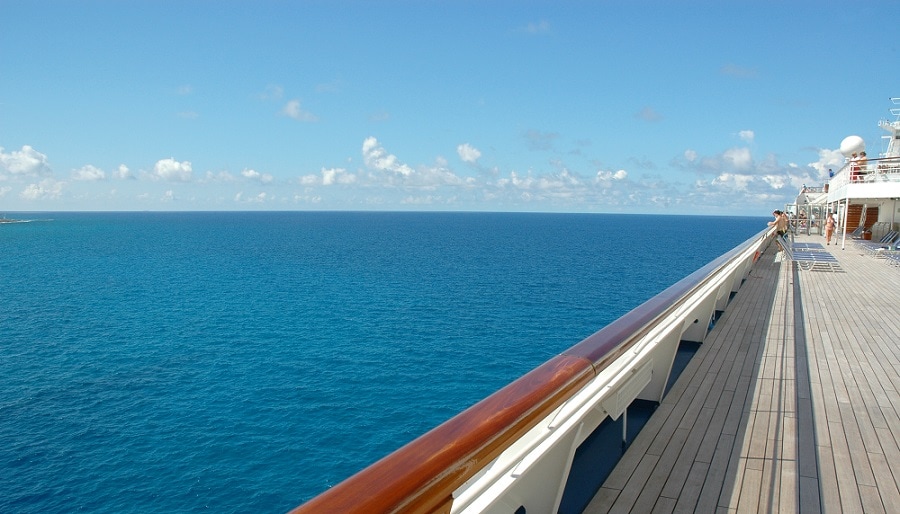
If you know the rocking of the waves might upset your stomach, plan ahead by packing some medication for seasickness. Antiemetic drugs, or medicine that keeps one from feeling nauseous, are readily available over the counter in drug stores nationwide. Your doctor can prescribe stronger scopolamine medicine in patch or pill form as needed. Either way, be sure you remember to pack these medications to keep you from feeling sick as you cruise to your destination.
Get a Good Night’s Sleep
You might find it difficult to rest the night before your cruise – who wouldn’t be excited before a trip like this? However, exhaustion can exacerbate the effects of motion sickness and make you more susceptible to feeling ill. Be sure to get a good night’s sleep before setting sail, so your body is rested and ready to fight seasickness if it rears its ugly head.

It may feel counter-intuitive, but traveling on an empty stomach is more likely to make you feel ill than traveling after a light meal. To help settle your stomach, have a simple snack about one hour before you depart, and remember to continue snacking every few hours throughout the cruise. However, avoid fatty, acidic or spicy foods to keep from getting nauseated. You may want to avoid alcohol if you feel like you may become ill, since the dehydration it causes can lower your resistance to sickness.

If you start to feel the telltale signs of nausea, head out onto the deck for some fresh air. This change of environment will alleviate the rise in your body temperature (save that for a day on the beach in the Caribbean ), and the wind in your face will help reduce uncomfortable sweating. While there, focus on your breath to bring yourself back down to a calm and relaxed state.
Most seasickness is attributed to a disconnect between your senses and your physical movement. Watching the water speed past can be disorienting, and trying to keep your balance as the ship moves might only result in motion sickness. However, mariners have been advising this tip forever: simply look out at the horizon – a stable focal point – to reorient yourself. This will help to reset your equilibrium. To make your life a bit easier, request a room with a window so you can keep your eyes on the prize whenever you need to!
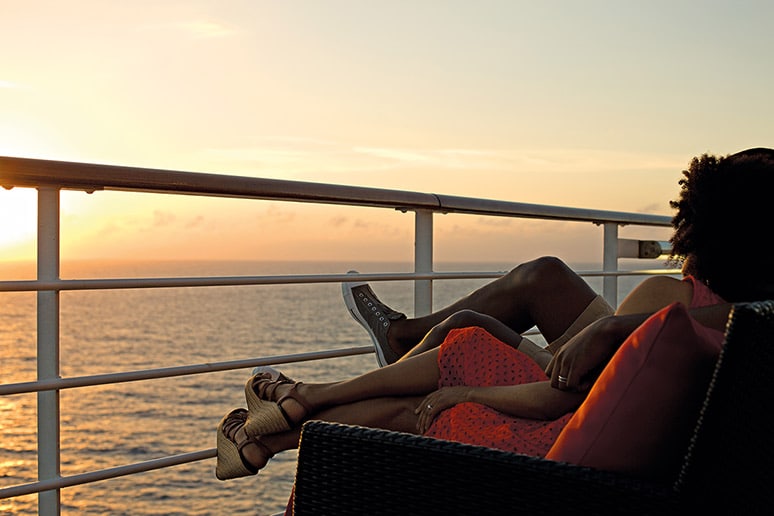
While kicking back with a novel or laptop on the way to The Bahamas may sound like a dream, there’s also a good chance it will trigger motion sickness. Watching a stationary object like a book can convince your middle ear it’s wrong, making you feel nauseated. Instead, focus on the horizon or rest with your eyes closed to avoid confusing your body.
The swaying and seesawing of the boat will be most extreme on the outside edges, so head to the middle of the ship to alleviate some of the effect. You may even want to book a room in this area of the cruise ship so your nights are less rocked by the motion of the ocean.
Another popular method for decreasing seasickness is through wearing a wristband that will apply pressure to a spot on your wrist. Whether real or placebo, many people swear by this trick. If you don’t have a wristband on you – or you left it at home when you set sail for Mexico – you can try pressing your wrist with your opposite thumb for relief.
Looking for something to try before you travel to your destination ? Some studies have shown a correlation between getting proactive acupuncture treatment and minimized seasickness. This method focuses on the same area as acupressure wristbands, but it could be useful if you want to try preventing seasickness before you even set sail.
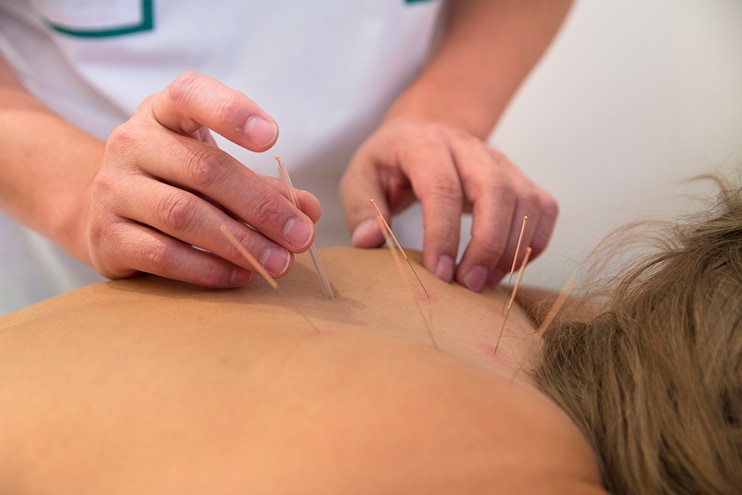
If you aren’t keen on taking pills, rest assured there are plenty of ways to combat seasickness using natural substances. Chewing on ginger or sipping ginger ale is a common approach, but you could also try some classic aromatherapy. Scents like peppermint and lavender can calm your senses and encourage important deep breathing when feeling nauseated.
Of course, if you still find yourself feeling seasick, know that Carnival is happy to get you back on your feet. Head to the Medical Center or call room service for motion sickness pills that will help you feel healthier and ready to greet the day again.
Note: Onboard activities, shore excursions, and dining options may vary by ship and destination.
Related articles
Plan for fun.
https://www.carnival.com/cruise-from.aspx
Celebrity Blog
- Special Occasions
- Choosing a Cruise
- Planning / Booking A Cruise
- Preparing For Your Cruise
- What To Expect On A Cruise
- Australia, New Zealand & the Pacific
- Central America
- East Coast & Bermuda
- Mexican Riviera
- South America & Antarctica
- Destinations
How to Prevent Seasickness on a Cruise
Last updated: June 5th, 2024
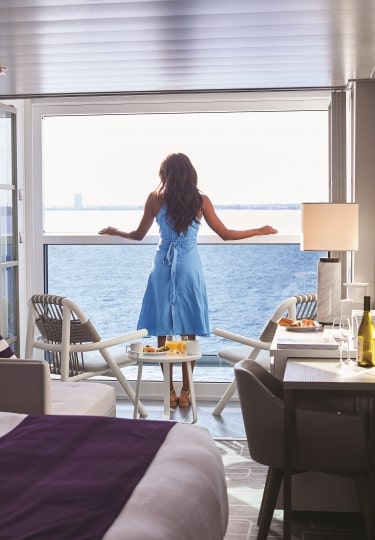
- Find a Cruise
If the only thing standing between you and an unforgettable cruise vacation on one of Celebrity Cruises’ premium ships is worrying about whether or not you’ll get seasick on a cruise, these tips about dealing with motion sickness will ease your mind and body so you can happily book your cruise.
What causes seasickness?

Seasickness is a form of motion sickness that results when what your eye sees is out of balance with what your inner ear senses. If your body feels motion but your eye doesn’t see it, your senses become confused and can cause symptoms like dizziness, nausea, headaches, and tiredness.
Motion sickness can happen in almost any mode of travel, such as cars, trains, or even on a roller coaster.
How long does seasickness last on a cruise?
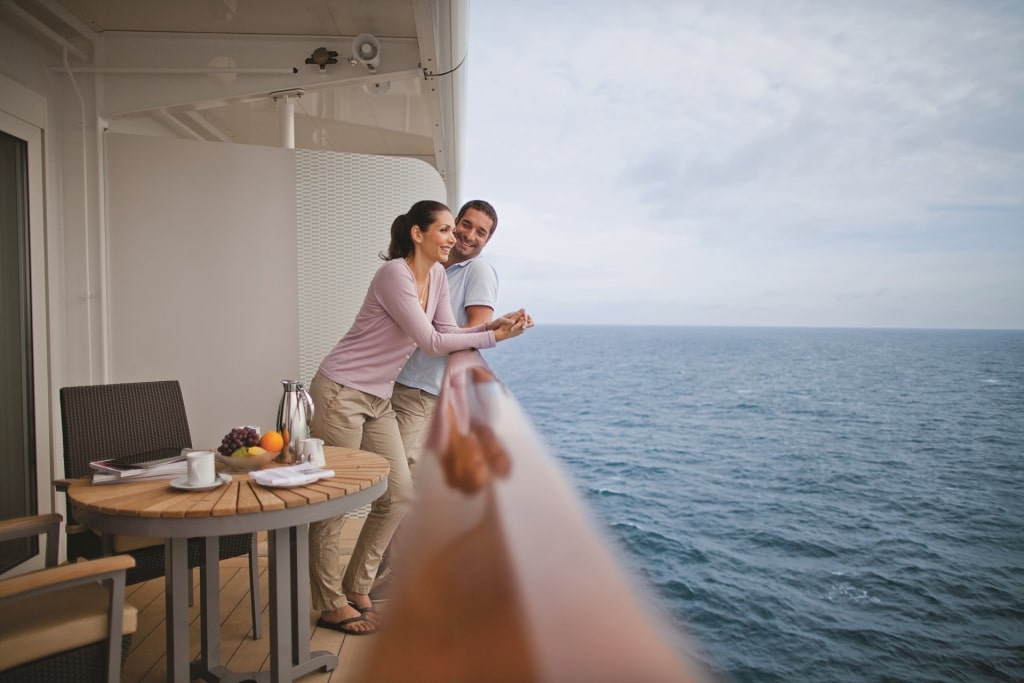
If you feel seasick at the start of a cruise, the good news is that for the great majority of passengers, seasickness usually subsides once you get your “sea legs,” which means your senses adjust and your equilibrium returns.
For most passengers who feel seasick at the start of a cruise, taking over-the-counter remedies and using the techniques recommended in this article will help you feel better in a few hours to a day or two. In some cases, particularly in rougher sea weather, seasickness may last longer.
Can you feel the ship move on a cruise?
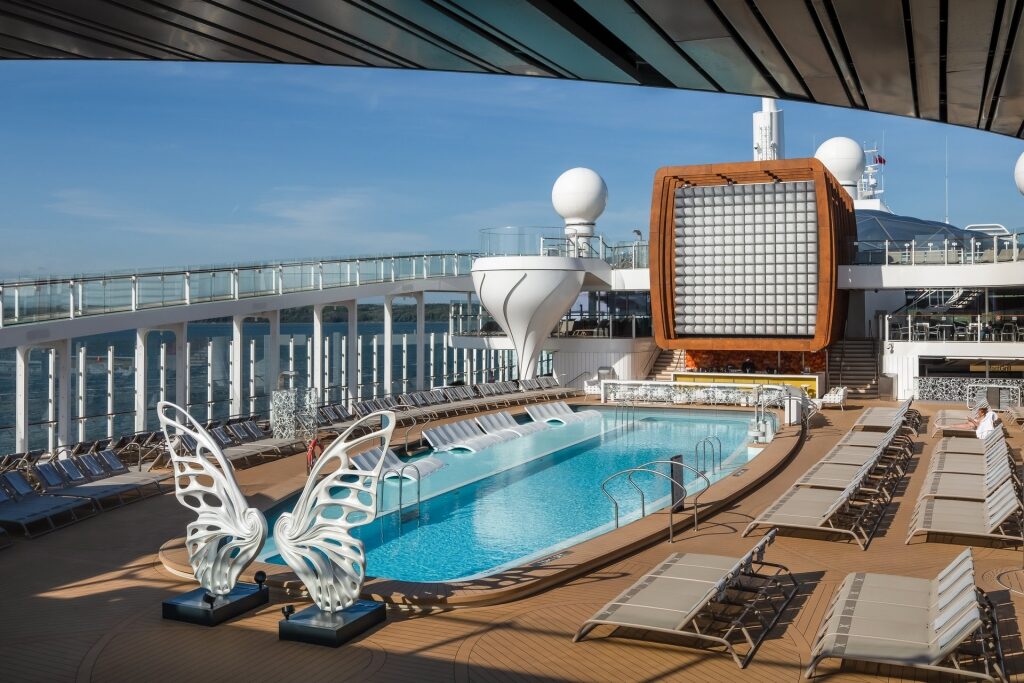
Celebrity Cruises’ fleet of innovative cruise ships are so well designed and engineered that most of the time you won’t even feel the ship moving. Each ship is designed to give you as smooth a ride as possible without compromising the multiple activities available onboard and the spectacular on-deck views.
Our ships have stabilizers to keep the boat from rocking. Even a tilting of 1% is considered unacceptable, and Celebrity Cruises uses advanced technology to make sure your ship stays stable and calm.
What kind of cruise ships are best to avoid seasickness?
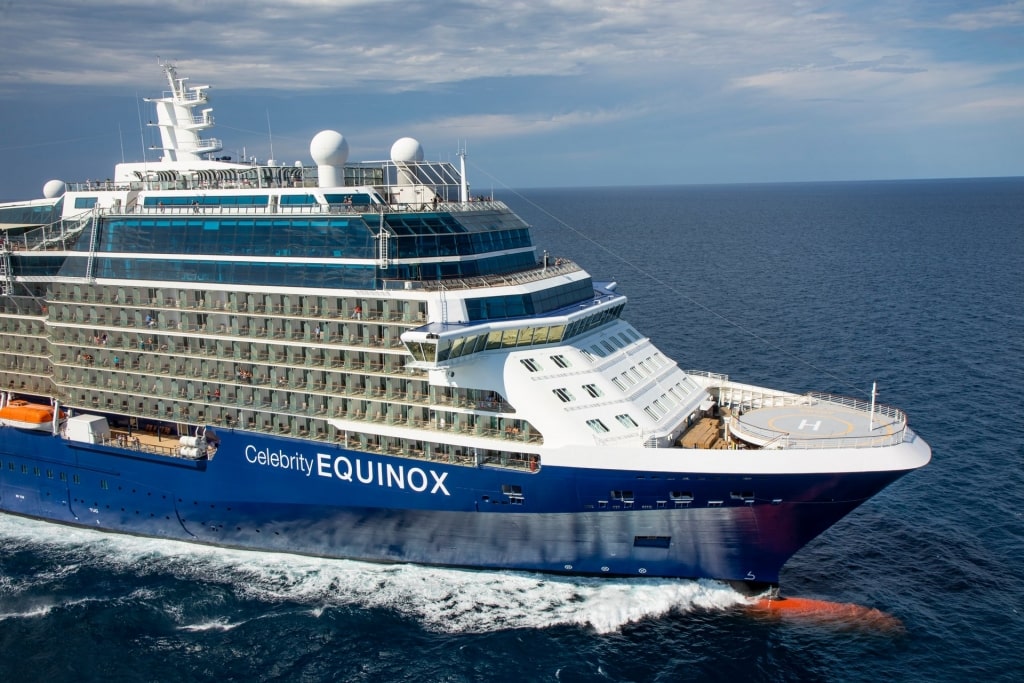
If you’re concerned about being seasick on a cruise, it’s good to know that Celebrity’s Solstice-class ships , which include Celebrity Solstice, Celebrity Silhouette, Celebrity Equinox, Celebrity Eclipse, and Celebrity Reflection, are built for smooth sailing, with fin-like stabilizers mounted beneath the ship’s waterline to ensure smooth sailing.
To give you an idea of the size and heft of these ships, each is built in post-Panamax dimensions, meaning they are too large to sail through the locks of the Panama Canal. At 122,000 to 126,000 tonnes, they glide through the water at a comfortable average speed of 24 knots, or about 27 miles per hour. They are steel-hull constructed and built with the safety and comfort of passengers in mind.
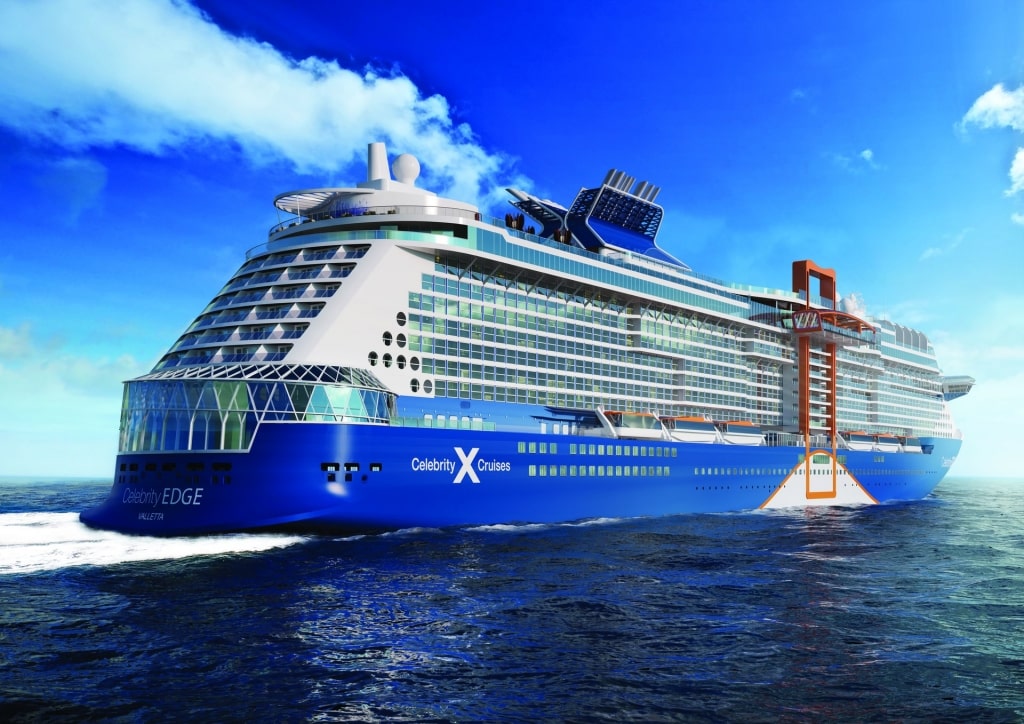
Celebrity’s newest class of ships, the Edge class, which includes Celebrity Edge and sister ship, Celebrity Apex , are the largest ships in our fleet. At 129,500 tonnes and reaching average cruising speeds of 22 knots, or about 25 miles per hour, they, too, are steel-hull constructed with stabilizers to ensure the safety and comfort of the passengers they carry.
Where is the best place to sail to avoid getting seasick on a cruise?

If you know you’re especially susceptible to seasickness, avoid itineraries that spend a lot of time sailing in open water. Cruise itineraries that stay within a sea, such as European cruises that sail along the Mediterranean Sea or Caribbean cruises that depart from San Juan, Puerto Rico are often good bets for having relatively calm waters during cruises.
One way to test the waters if you’re concerned about getting seasick on a cruise is to book a short cruise on a large ship that sails in calm water. We offer 2-night cruises from Florida to the Bahamas on our Millennium-class ship, Celebrity Infinity, and our newly revolutionized Solstice-class ship, Celebrity Equinox.

You’ll have one day at sea in each direction in the usually calm waters between Fort Lauderdale or Miami and the Bahamas. When in port, you’ll have a day to relax and play in the warm sunshine, clear blue water, and white-sand beaches of Nassau .
Another way to minimize your chances of becoming seasick on a cruise is to book a cruise that sails on one of our largest ships, like Celebrity Edge or Celebrity Apex, with 10- or 11-night itineraries that sail within the generally calm waters of the Mediterranean Sea.

Cruise from Rome on a 10-night itinerary visiting some of the most beautiful destinations in the Mediterranean, like Sicily, Naples, and the gorgeous Greek Islands. Or, sail an 11-night itinerary departing from Rome to Naples and Messina, Corfu, Greece, and up the Dalmatian Coast to Dubrovnik and Split, Croatia, and Trieste in Northern Italy.
On each of these sailings, you’ll only have two nights at sea, with the remaining time spent in port enjoying the glorious sights and pleasure of the Mediterranean.
When choosing an itinerary to avoid seasickness, consider the time of year as well. For instance, the best time to cruise the Caribbean is outside the hurricane season—the months of June through November—as they can increase the wave height and the ship movement you might feel while at sea.
Read: Cruising During Hurricane Season
What’s the best stateroom location to avoid motion sickness on a cruise?
To reduce motion sickness, choose a stateroom in the middle of the ship on a lower deck. You will feel any sway of the ship less in this section.
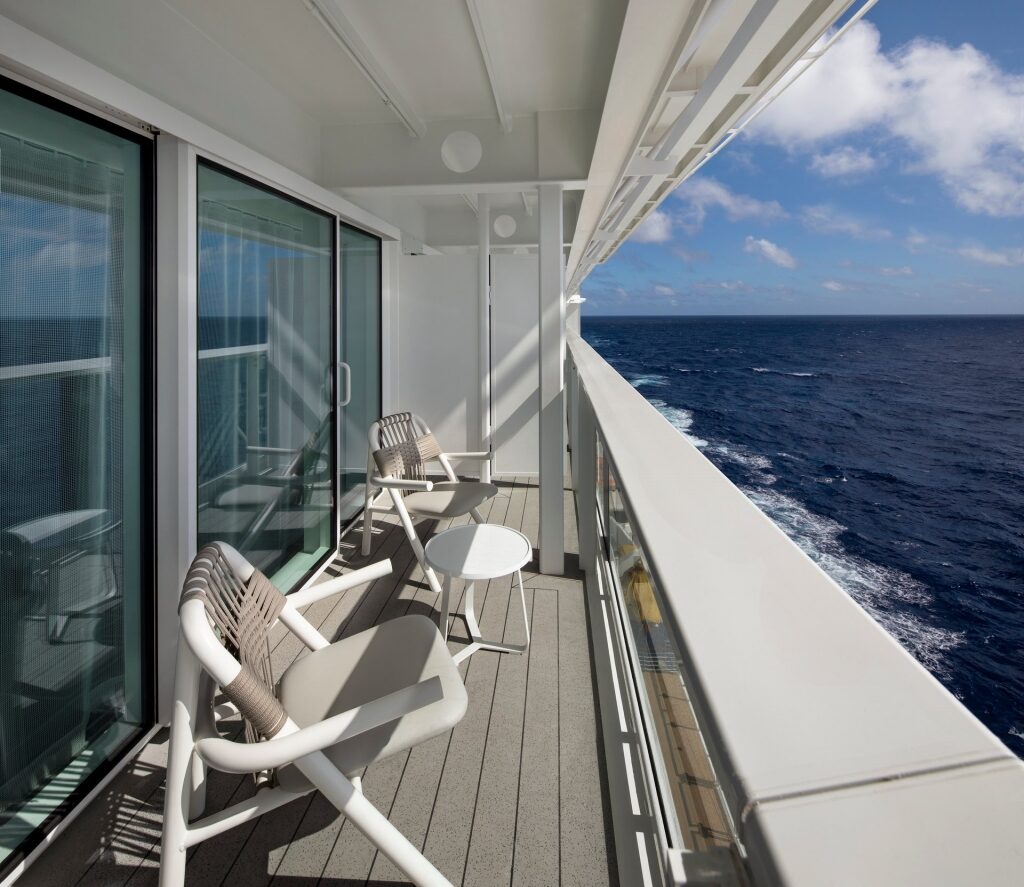
Although it may seem counterintuitive, if you’re worried about seasickness on a cruise, book a stateroom with a window or a veranda. Fresh air access and a horizon view will help alleviate seasickness symptoms.
If lower levels are already booked or you’d like to be on a higher deck for an elevated view or to be closer to the activities on the top decks, book a stateroom in the middle of the ship and avoid staterooms near the front or back (bow or aft) of the ship.
The ships’ deck plans will help you pinpoint the best stateroom location for your needs.
Read: Cruising While Pregnant
What remedies are available to alleviate seasickness on a cruise?
One way to avoid seasickness on a cruise is to get enough rest. Lack of sleep and exhaustion can make you more susceptible to motion sickness.
Motion sickness medication and natural remedies

If you think you might experience motion sickness on a cruise, it’s best to be prepared. There are several over-the-counter, natural, and doctor-prescribed remedies that can help. Be sure to pack whatever seasickness remedy you choose in your carry-on bag, and take as directed, which may mean a few hours prior to boarding your ship.
If you have a doctor-prescribed transdermal patch (scopolamine), apply it as directed at least four hours before boarding your ship. The patch is active for three days, so if you’re traveling on a longer cruise, you should pack replacements.
Don’t panic if you forget to pack motion sickness medication. At the guest relations desk onboard, you’ll find tablets that will help combat seasickness.

There are also some tried and true natural remedies to alleviate the symptoms of seasickness. Ginger, whether in pill form or as a candy, is easy to keep handy as you cruise. Sucking on peppermint candy or smelling peppermint oil is also helpful.
Acupressure & acupuncture
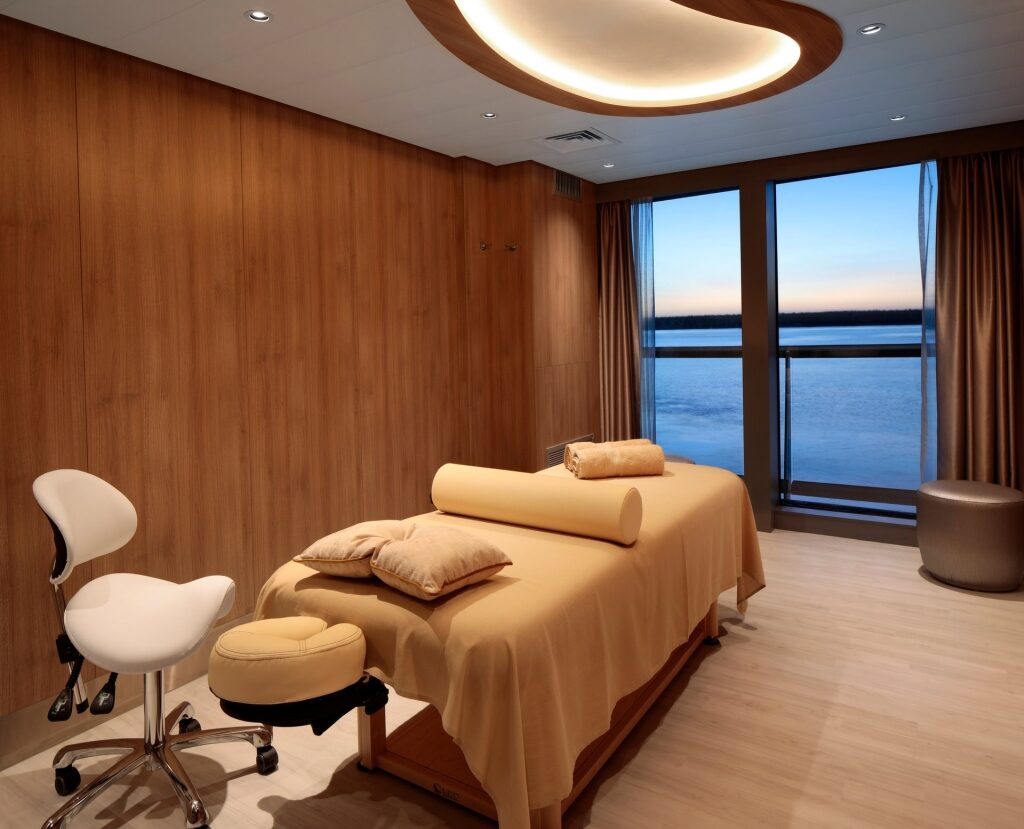
Wearing an acupressure band around your wrist is another natural way to alleviate sea sickness. If you want to take pressure-point therapy one step further, forego the band and seek out an acupuncture specialist. Our onboard spas have acupuncture technicians who will help you relieve your motion sickness.
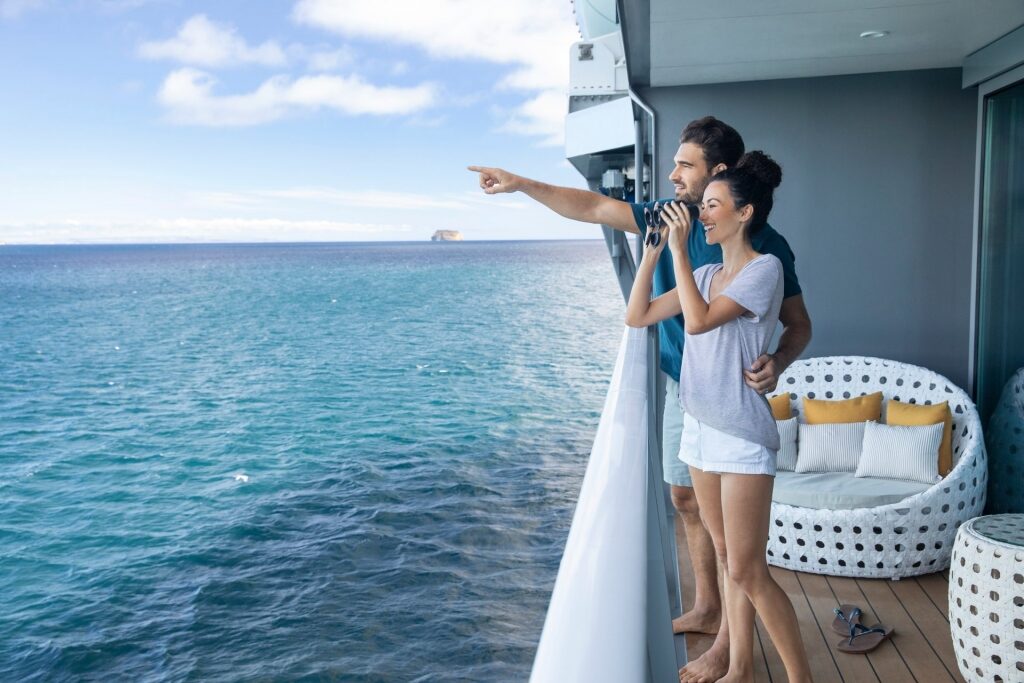
Though being seasick on a cruise may make you want to curl up in your stateroom and stay there, you’ll be amazed at how dramatically better you’ll feel if you get out and breathe in some fresh air. At the very least, step out on your veranda, take a breath of fresh air, find a spot on the horizon, and keep your eyes on it.
Make an effort to get up to the top deck and do the same. Breathing in fresh air while keeping your eyes on the horizon helps your mind and body get back in sync and may alleviate your symptoms.
What should I eat and drink to avoid motion sickness on a cruise ship?
It may sound like the last thing you want to do, but keeping your stomach full by eating small meals and snacks throughout the day can help ward off nausea from seasickness. At the very least, regularly sipping ginger ale and eating crackers may do the trick for the first 24 hours.
If you’re prone to seasickness, be cautious of your alcohol intake as alcohol can increase dehydration and exacerbate the effects of motion sickness.
Staying hydrated during your cruise is vital, as dehydration can make you feel more seasick. Our Zero Proof drink package includes unlimited bottles of sparkling and still water, such as San Pellegrino, Acqua Panna, and Evian.
Now that you know how to combat seasickness, browse our cruise itineraries , view cruise accommodations, fights, and activities all in one place or speak to one of our cruise vacation specialists at 1-800-852-8086.
Related Itineraries
Key West & Perfect Day
- 4 nights ON CELEBRITY REFLECTION
- DEPARTING FROM FORT LAUDERDALE, FLORIDA
Key West & Bahamas
Bahamas & Perfect Day
- 3 nights ON CELEBRITY REFLECTION
Bahamas, Mexico & Cayman
- 6 nights ON CELEBRITY BEYOND
Aruba, Bonaire & Curacao
- 8 nights ON CELEBRITY BEYOND
Related Articles
17 Invaluable Cruise Tips From a 20-Year Cruise Veteran
19 Things Not to Do on a Cruise
17 Cruise Tips for First-Timers
Accessible Travel Guide
What to Wear on a Cruise: The Ultimate Guide
The Only Cruise Packing List You’ll Ever Need
Cruises vs Resorts: Which Is Best?
Why Cruises Are the Best Family Vacation
Overnight Cruises: Where to Go, What to See
When’s the Best Time to Go on a Cruise?
11 Ways to Enhance Your Cruise With the Celebrity Cruises App
What’s the Best Way to Book a Cruise?
Free Vacation Planning Services

CALL US 888-751-7804
Sign Up for Special Offers
I would like to receive electronic Promotional messages from Celebrity Cruises Inc. You can unsubscribe at anytime. Please view our Privacy Policy .
- First Name *
- Last Name *
- Email Address *
- Country * Country Afghanistan Albania Algeria American Samoa Andorra Angola Antigua and Barbuda Argentina Armenia Australia Austria Azerbaijan Bahamas Bahrain Bangladesh Barbados Belarus Belgium Belize Benin Bermuda Bhutan Bolivia Bosnia and Herzegovina Botswana Brazil Brunei Bulgaria Burkina Faso Burundi Cambodia Cameroon Canada Cape Verde Cayman Islands Central African Republic Chad Chile China Colombia Comoros Congo, Democratic Republic of the Congo, Republic of the Costa Rica Côte d'Ivoire Croatia Cuba Curaçao Cyprus Czech Republic Denmark Djibouti Dominica Dominican Republic East Timor Ecuador Egypt El Salvador Equatorial Guinea Eritrea Estonia Ethiopia Faroe Islands Fiji Finland France French Polynesia Gabon Gambia Georgia Germany Ghana Greece Greenland Grenada Guam Guatemala Guinea Guinea-Bissau Guyana Haiti Honduras Hong Kong Hungary Iceland India Indonesia Iran Iraq Ireland Israel Italy Jamaica Japan Jordan Kazakhstan Kenya Kiribati North Korea South Korea Kosovo Kuwait Kyrgyzstan Laos Latvia Lebanon Lesotho Liberia Libya Liechtenstein Lithuania Luxembourg Macedonia Madagascar Malawi Malaysia Maldives Mali Malta Marshall Islands Mauritania Mauritius Mexico Micronesia Moldova Monaco Mongolia Montenegro Morocco Mozambique Myanmar Namibia Nauru Nepal Netherlands New Zealand Nicaragua Niger Nigeria Northern Mariana Islands Norway Oman Pakistan Palau Palestine, State of Panama Papua New Guinea Paraguay Peru Philippines Poland Portugal Puerto Rico Qatar Romania Russia Rwanda Saint Kitts and Nevis Saint Lucia Saint Vincent and the Grenadines Samoa San Marino Sao Tome and Principe Saudi Arabia Senegal Serbia Seychelles Sierra Leone Singapore Sint Maarten Slovakia Slovenia Solomon Islands Somalia South Africa Spain Sri Lanka Sudan Sudan, South Suriname Swaziland Sweden Switzerland Syria Taiwan Tajikistan Tanzania Thailand Togo Tonga Trinidad and Tobago Tunisia Turkey Turkmenistan Tuvalu Uganda Ukraine United Arab Emirates United Kingdom United States Uruguay Uzbekistan Vanuatu Vatican City Venezuela Vietnam Virgin Islands, British Virgin Islands, U.S. Yemen Zambia Zimbabwe

STAY IN THE KNOW
Thank you for subscribing.
See you on board soon.
The Truth About Seasickness
Our chief medical consultant gives us his best tips on preventing seasickness..

One of the most common questions first-time cruisers have is “What if I get seasick?” We understand where the concern comes from, and we have answers. We’ve enlisted Dr. Benjamin Shore, Chief Medical Consultant at Royal Caribbean, to break down the basics and whether it’s actually common for guests to experience seasickness while vacationing at sea.
“Considering the large size of today’s cruise ships , seasickness is rarely a problem,” says Dr. Benjamin Shore. He adds that with innovative design and engineering, ships can also safely navigate around inclement weather , and use stabilizers—fins built off a ship’s port and starboard sides along the water line—to reduce side-to-side motion so most guests never experience any motion sickness.
Before we get to the specifics, here are the basics: Motion sickness occurs when what you see conflicts with what your inner ear senses. In other words, if you’re sitting in a car (not moving) but your inner ear detects movement (the car just hit 70 mph on the highway), the two signals being sent to your brain don’t match. Those mixed signals confuse the brain, and the sensations and symptoms (dizziness, nausea) are the result.
In the event that seasickness does develop, Dr. Shore assures that it’s unlikely to really interrupt your adventure, since all Royal Caribbean ships have motion sickness medications, like meclizine, readily available at the dedicated Medical Center on each of our ships, free of charge.
“Additionally, for more troublesome seasickness, our Medical Centers also carry promethazine and metoclopramide,” Dr. Shore says.
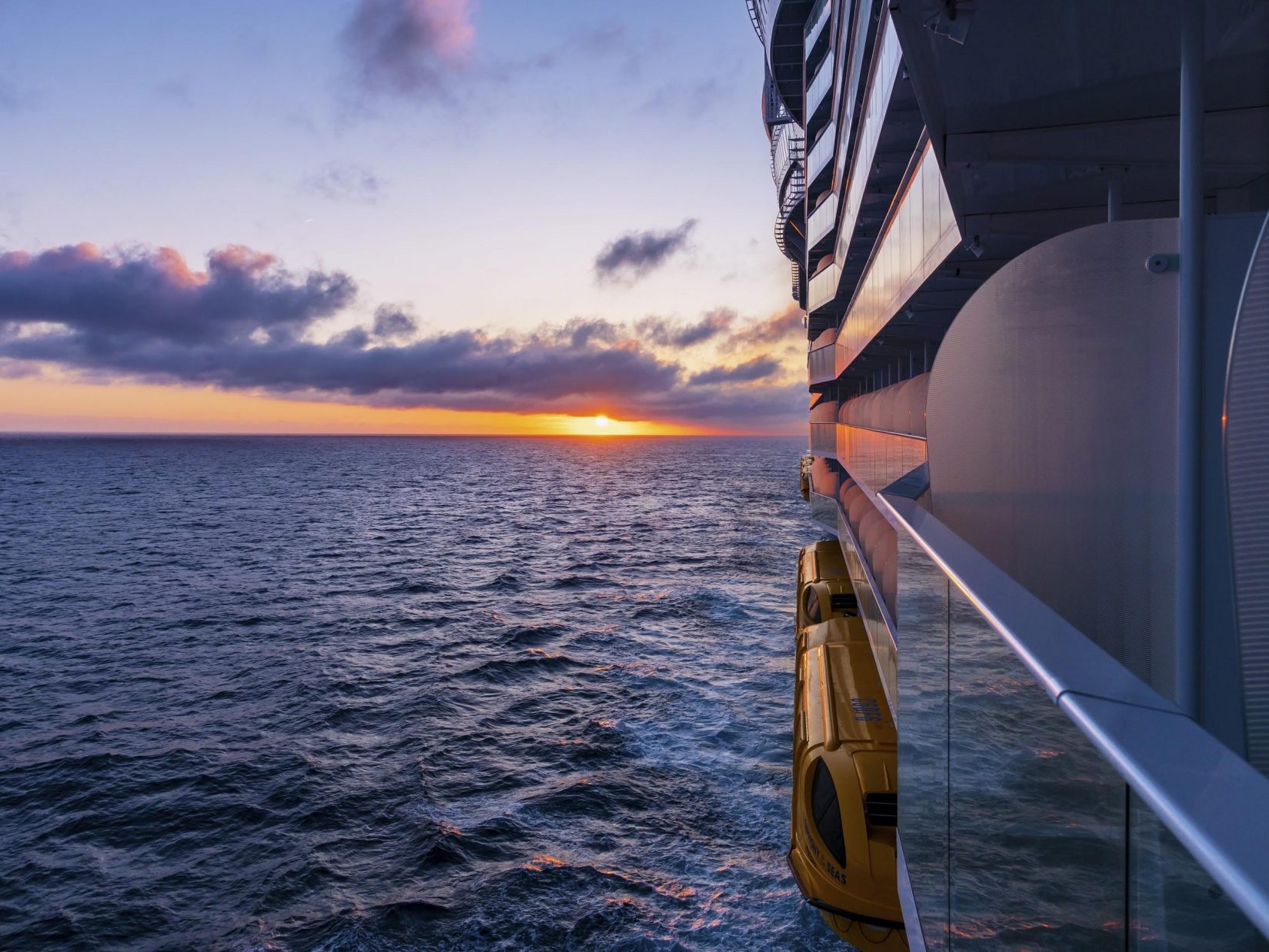
Sometimes the best treatment is prevention. “It’s best that guests who know they are prone to seasickness consult their doctor prior to departure,” Dr. Shore says. If your personal physician thinks it’s appropriate, he or she can prescribe a patch that you can wear to prevent the onset of seasickness. “For prescription patches like Transderm Scop, it’s important for it to be applied prior to boarding to be effective,” he adds.
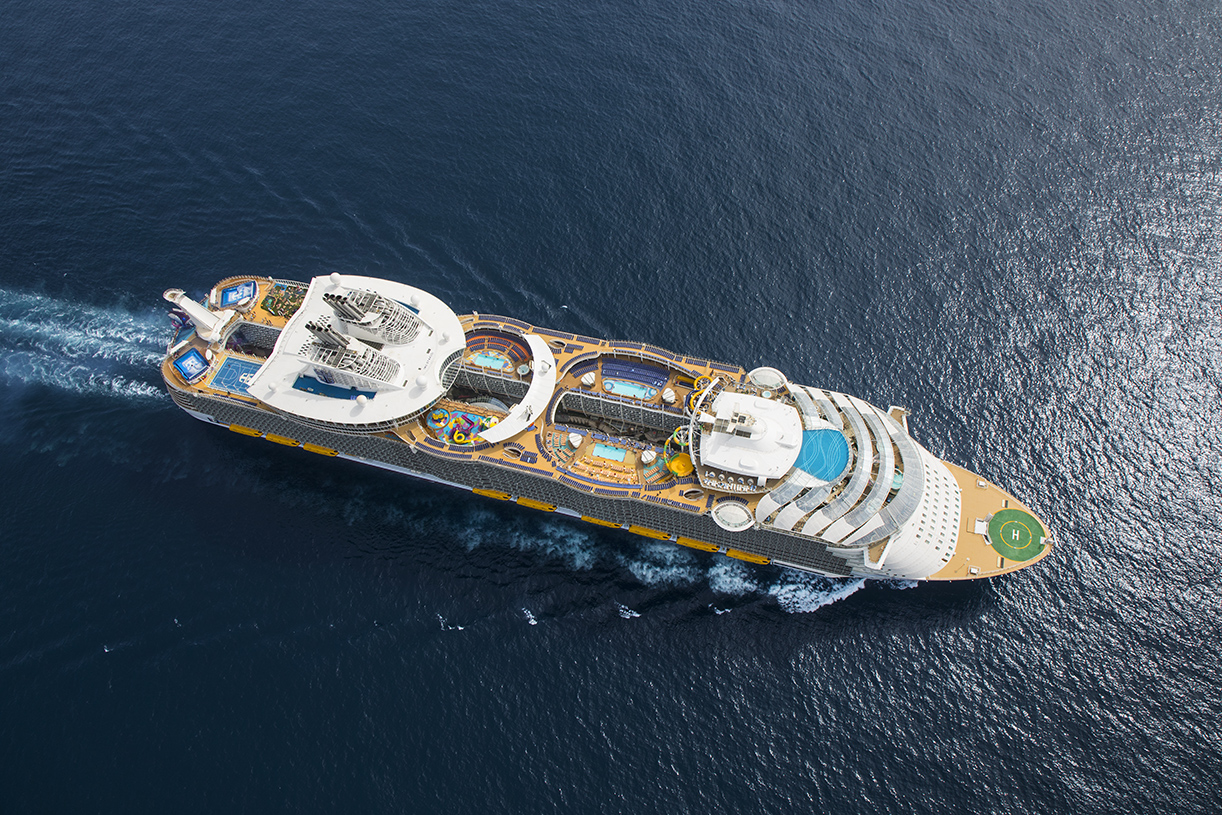
Dr. Shore notes that there are also lots of natural remedies that can help alleviate motion sickness. “Anecdotally, ginger seems to be helpful, and some people find various aromas (like anise, basil, chamomile and peppermint) or eating dry crackers, even after the onset, of seasickness can help.” If a few sips of ginger ale or chewing fresh ginger doesn’t do the trick, he also suggests going for a short walk to the center of the ship, the most balanced area on board and therefore least likely to produce seasickness symptoms.
An unexpected solution Dr. Shore suggests is “the smelling of newspaper print!” He says, “science has no idea why this works so well, but it actually seems to diminish the sensation of nausea.”
With Dr. Shore’s advice and Royal Caribbean’s staff of medical professionals, it’s only smooth sailing for our guests!
If you’re ready to explore Royal Caribbean’s many destinations (more than 260 ports around the world), click here to set sail on your next vacation.
Related Articles

Teaming Up With Actress & Adventurer Shay Mitchell

What Clothing To Pack For Your First Cruise

Holiday Gift Guide: Top Travel Gadgets

Curious Cruise Jobs: Introducing Anthem of the Seas’ Cruise Director

Best Motion Sickness Meds for Cruise: Remedies, Medications & Tips
Are you tired of missing out on the fun of cruising due to motion sickness? Picture this: You’re on a beautiful cruise ship, the ocean breeze in your hair, but the constant swaying leaves you feeling queasy. What if there was a solution that could make your next cruise a breeze?
In this article, you’ll discover the best motion sickness meds for cruises, ensuring you can enjoy every moment of your voyage without feeling seasick. Say goodbye to those uncomfortable moments and hello to smooth sailing ahead. Get ready to make the most of your next cruise with these effective remedies at your fingertips.
Key Takeaways
- Motion sickness on cruises is caused by conflicting signals to the brain, leading to discomfort and nausea.
- Common symptoms of motion sickness include dizziness, nausea, cold sweats, headaches, vomiting, and a general feeling of unease.
- Over-the-counter medications like Dramamine and Bonine can provide quick relief from motion sickness during a cruise.
- Prescription treatments such as Scopolamine Patch and Promethazine are recommended for severe or persistent motion sickness symptoms.
- Natural remedies like ginger and acupressure wristbands offer alternative options to manage motion sickness with fewer side effects.
- Behavioral techniques, dietary tips, and gentle movements can aid in reducing motion sickness symptoms onboard, allowing for a more enjoyable cruise experience.
Understanding Motion Sickness on Cruises
The causes of motion sickness.
Motion sickness on cruises is primarily triggered by conflicting signals sent to your brain. When your inner ear senses motion while your eyes and sensory nerves do not, it can lead to discomfort and nausea. This sensory mismatch confuses your brain, causing symptoms of motion sickness to arise.
Symptoms to Recognize
Recognizing motion sickness symptoms early can help you take proactive measures to alleviate discomfort. Common signs include dizziness, nausea, cold sweats, and headaches. Additionally, vomiting and a general feeling of unease are prevalent indicators of motion sickness. Being familiar with these symptoms can assist you in identifying and addressing motion sickness promptly.
Types of Motion Sickness Medications
Over-the-counter options.
When dealing with motion sickness during a cruise, over-the-counter medicines can be a convenient and effective solution. These medications are readily available without needing a prescription. They work by calming the signals between your inner ear and brain that are causing the symptoms of motion sickness. Common over-the-counter options include:
- Dramamine : A popular choice for preventing and treating motion sickness. It’s available in various forms such as tablets, chewable tablets, and less drowsy formulas.
- Bonine : This medication is known for causing less drowsiness compared to other options. It can help alleviate symptoms like nausea and dizziness.
Consider packing these over-the-counter medications in your cruise essentials kit for quick relief whenever motion sickness strikes.
Prescription Treatments
For severe or persistent motion sickness, prescription medications prescribed by a healthcare provider may be necessary. These medications are usually more potent and can effectively manage intense symptoms. Some common prescription treatments for motion sickness include:
- Scopolamine Patch : A medicated patch worn behind the ear that continuously delivers medication to alleviate symptoms over several days.
- Promethazine : Available in oral or rectal forms, this medication helps with nausea and vomiting associated with motion sickness.
Be sure to consult with a healthcare professional before embarking on your cruise to discuss prescription options if you anticipate severe motion sickness symptoms.
Natural and Alternative Remedies
In addition to traditional medications, natural and alternative remedies can also be beneficial in managing motion sickness. These remedies focus on using natural ingredients to alleviate symptoms without the side effects of conventional medications. Some natural approaches to consider include:
- Ginger : Known for its anti-nausea properties, ginger in various forms such as capsules, teas, or chews can help settle your stomach.
- Acupressure Wristbands : These wristbands apply pressure to specific points on your wrists believed to alleviate nausea and vomiting.
When exploring natural and alternative remedies, remember that individual responses may vary, so it’s essential to test these options before your cruise to determine their effectiveness for you.
Top Rated Over-the-Counter Motion Sickness Meds
Meclizine: an antihistamine approach.
Managing motion sickness can be easier with Meclizine. This antihistamine has a calming effect, helping to reduce nausea and vomiting while preventing dizziness. Meclizine is commonly found in brands like Bonine. Remember to take it before your cruise to allow it to kick in and provide you with relief throughout your journey.
Dimenhydrinate: Tried and True Relief
For a reliable solution, consider Dimenhydrinate. This medication, often found in Dramamine, works by calming the inner ear, reducing the conflicting signals that cause motion sickness. It’s best to take Dimenhydrinate about 30 minutes before setting sail to ensure it’s effective when you need it the most during your cruise.
Scopolamine Patch: A Longer-Term Solution
If you’re looking for a longer-lasting option, the Scopolamine Patch might be the right choice. This transdermal patch delivers medication continuously over several days, offering extended relief from motion sickness symptoms. Apply the patch behind your ear at least four hours before departure to benefit from its effectiveness throughout your entire cruise.
Remember always to follow the recommended dosages and instructions provided with these medications for optimal results. Consult with a healthcare professional to determine the most suitable over-the-counter motion sickness medication based on your needs.
Prescription Motion Sickness Medications for Cruises
Promethazine: prescription-strength relief.
If you’re dealing with severe motion sickness symptoms during your cruise, Promethazine could be the prescription medication that provides the relief you need. This medication acts as an antihistamine and antiemetic, helping to alleviate nausea and vomiting associated with motion sickness. It works by blocking histamine, a chemical in the body that contributes to these symptoms.
Promethazine is commonly available in various forms such as tablets, suppositories, and injections. Your healthcare provider will determine the most suitable form and dosage based on the severity of your symptoms. It’s essential to take this medication as directed and adhere to the recommended dosage to maximize its effectiveness in managing your motion sickness during the cruise.
Ondansetron: For Severe Cases
In cases where traditional motion sickness medications may not provide adequate relief, Ondansetron can be a viable option for addressing severe symptoms. Ondansetron, often marketed under the brand name Zofran, belongs to a class of medications known as serotonin 5-HT3 receptor antagonists. It works by blocking the actions of serotonin, a neurotransmitter that can trigger vomiting reflexes.
Typically prescribed in the form of tablets, Ondansetron is well-suited for managing intense nausea and vomiting related to motion sickness. Your healthcare provider will determine the appropriate dosage based on your individual needs, considering factors like the severity of symptoms and your medical history. By following your healthcare provider’s guidance and using Ondansetron as prescribed, you can experience relief from severe motion sickness symptoms during your cruise.
Natural Remedies and Preventive Measures
When it comes to managing motion sickness on cruises, natural remedies and preventive measures can offer a gentler alternative to traditional medications. Here are some options you can consider:
Ginger Supplements and Teas
Ginger has long been recognized for its anti-nausea properties. You can try ginger supplements or ginger teas to help alleviate symptoms of motion sickness. Ginger works by settling the stomach and easing feelings of queasiness. It’s a popular choice for those looking for a natural solution to seasickness.
Acupressure and Acupuncture Wristbands
Acupressure wristbands are designed to apply pressure to specific points on your wrists, believed to relieve nausea and vomiting. These bands are thought to work by triggering the release of endorphins, the body’s natural painkillers. Acupuncture wristbands function similarly to acupressure bands but stimulate acupressure points through small electrical pulses. Both methods are non-invasive and can be used as a preventive measure or when symptoms arise.
By considering these natural remedies and preventive measures, you can explore alternative options to manage motion sickness on your next cruise. Be sure to test these methods before your trip to see what works best for you.
Tips for Managing Motion Sickness Onboard
Behavioral techniques to reduce symptoms.
When combating motion sickness on a cruise, there are several behavioral techniques you can employ to mitigate symptoms effectively.
- Situate yourself strategically: Opt for a central location on the ship where motion is felt the least—it’s usually midship on lower decks.
- Fix your gaze: Look at the horizon or a distant stable object, as it helps your body orient itself better in space.
- Stay cool: Avoid strong odors, stay in well-ventilated areas, and focus on fresh air to alleviate nausea.
- Gentle movements: Slow and steady movements, like swaying with the ship’s motion, can aid in reducing queasiness.
- Distractions: Engage in activities that occupy your mind, such as listening to music, watching the scenery, or socializing.
Dietary Tips and Tricks
Your diet can play a significant role in managing motion sickness while cruising. Here are some dietary tips and tricks to help you combat the nausea:
- Hydration is key: Drink plenty of water to stay hydrated and aid in digestion, which can alleviate feelings of queasiness.
- Avoid heavy meals: Opt for light and easily digestible foods like crackers, fruits, or plain carbs to prevent stomach discomfort.
- Ginger power: Ginger has natural anti-nausea properties, so consider ginger ale, ginger tea, or ginger candies as remedies.
- Steer clear of triggers: Stay away from heavy, greasy, spicy foods, or excessive alcohol consumption to minimize the risk of aggravating symptoms.
- Snack smart: Keep snacks like pretzels, nuts, or dry cereal on hand to nibble on and help settle your stomach.
By incorporating these behavioral techniques and dietary adjustments into your cruise routine, you can effectively manage motion sickness and make the most of your seafaring adventure.
You now have a comprehensive understanding of various motion sickness medications and remedies for your next cruise adventure. Remember to explore options like Dramamine, Bonine, ginger supplements, and acupressure wristbands to find what works best for you. Testing these methods beforehand and seeking advice from healthcare professionals are key steps. Implement behavioral techniques and dietary tips onboard to manage motion sickness effectively. By incorporating these strategies, you can make the most of your cruise experience without letting motion sickness dampen your journey. Safe travels!
Frequently Asked Questions
What are common medications for motion sickness on cruises.
Over-the-counter and prescription medications such as Dramamine, Bonine, Meclizine, Dimenhydrinate, Scopolamine Patch, Promethazine, and Ondansetron are commonly used to manage motion sickness on cruises.
What natural remedies can help with motion sickness on cruises?
Natural remedies such as ginger supplements, teas, acupressure bands, and acupuncture wristbands are gentler alternatives to traditional medications for combating motion sickness on cruises.
What tips can help manage motion sickness onboard a cruise?
Behavioral techniques like strategic seating, focusing on stable objects, staying cool, gentle movements, and distractions, along with dietary tips like hydration, light meals, ginger consumption, avoiding triggers, and smart snacking can help combat nausea effectively during a cruise.

Hi, I'm Richard, a passionate traveler and cruise enthusiast. With over a decade of experience exploring the world's oceans, I've developed a deep love for all things related to cruising. Whether it's luxury liners or intimate river cruises, I enjoy sharing my insights and tips to help others plan their perfect getaway. When I'm not sailing the seas, you can find me writing about my adventures or planning my next voyage
Related Posts
Best beach bag for cruise essentials: functional & stylish picks, discover the best cruise ship for singles: tailored amenities, exciting activities & solo-friendly cabins, dance away on the best cruises: your ultimate guide to dancing at sea.
Save my name, email, and website in this browser for the next time I comment.
Type above and press Enter to search. Press Esc to cancel.

How to Deal With Seasickness on a Cruise
Afar’s special cruise correspondent has been on dozens of cruises in her life. despite being prone to seasickness, she has mostly avoided it with these remedies..
- Copy Link copied

Don’t let rough waters ruin your cruise vacation.
Photo by Caleb George/Unsplash
I am a cruise writer who suffers from seasickness. But of the approximately 170 cruises I have been on in my life, I have only actually been sick twice, once in particularly strong waves off the coast of Corsica and once when the Pacific was misbehaving off Baja.
I’ve avoided motion sickness on a cruise by bringing the best motion sickness medicines for cruising and by being familiar with factors that contribute to not feeling great—and how to avoid them. For those who don’t know what seasickness is, it starts with your brain getting conflicting information from your inner ear and eyes.
“Inside the cabin of a rocking boat, for example, the inner ear detects changes in both up-and-down and side-to-side acceleration as one’s body bobs along with the boat,” according to the National Oceanic and Atmospheric Administration . “But, since the cabin moves with the passenger, one’s eyes register a relatively stable scene. Agitated by this perceptual incongruity, the brain responds with a cascade of stress-related hormones that can ultimately lead to nausea, vomiting, and vertigo.”
Here are some tried-and-true tips and advice for how to avoid motion sickness on a cruise.
Carefully pick your ship and destination
The medications currently available for motion sickness are strong enough that I recently felt only slightly off while crossing the notoriously rough Drake Passage (sometimes referred to as the Drake “shake”) between Cape Horn and Antarctica , albeit while the seas were mostly cooperating.
Still, you can ensure a smoother ride by sticking to destinations with relatively calm waters. Popular cruise itineraries tend to be on routes that are less prone to rockiness, such as in the Caribbean, Bahamas, and Alaska’s Inside Passage . Once you venture deep into the Atlantic and Pacific, you never know what you’ll get. You may want to keep this in mind if you are a first-time cruiser testing your sea legs.
You’ll experience virtually no seasickness on most river cruises . A great option for those who fear getting seasick are the mostly calm inland waters traversed by river ships.
Modern cruise ships have stabilizers, for a relatively smooth ride wherever you cruise. On big ships with thousands of passengers, you’ll typically feel little movement. Smaller ships may be more of a challenge, but here too you’re likely to find stabilizers. A new generation of expedition ships from brands such as Lindblad Expeditions and Aurora Expeditions are designed with an inverted bow, known as an X-Bow, for a smoother ride.
Choose the right cabin
If you are worried about getting seasick, don’t book a cabin or suite at the very front (or forward end) of the ship, at the very back (aka the aft) of the vessel, or on the upper deck of a ship. These staterooms often feel the most movement. You are better off finding a cabin dead center in the middle of the ship, the most stable area. Also, you might want to make sure you book a cabin with windows so that you can look at the horizon when the ship starts rocking—while it doesn’t work for everyone, keeping your eyes on the horizon can offer a stabilizing effect for some.
The best motion sickness medicines for cruises
If you are worried about being seasick, pack some seasickness medication—options include Dramamine (dimenhydrinate) and Bonine (meclizine). There is a downside to these medications, in that they may cause drowsiness. (There are some nondrowsy options available as well.)
My rule of thumb is to take a half a pill when I first get onboard and until I feel my body has adjusted to the movement of the sea (which may or may not occur after a couple of days on the water). If you have kids who have a tendency to get carsick, you may want to ask your pediatrician about Dramamine for kids that you can give them when they board and as you figure out how they are responding to the movement of the water.
I also listen carefully to the captain’s daily announcements, which usually include a weather forecast for the day ahead. If waves are predicted to be high (more than 15 feet by my standards), I will make sure to take motion sickness medicine—because the reality of the meds is that they don’t really help once you feel sick, so plan accordingly.
If you forgot to pack medication and are feeling ill, ask at the guest services desk or the medical center—they will likely have medicine and the pills are often free.
What if it gets very choppy?
If I am on a route known for rough weather, such as in the Antarctic, I switch out the over-the-counter pills for a prescription Transderm Scop (scopolamine) patch, which goes behind your ear and steadily delivers medication for up to three days. It’s strong and not for everyone, so ask your doctor whether it’s right for you. A downside to the patch is it can make you very thirsty. The patches are also expensive and may not be covered by your health insurance.
In a worst-case scenario, if you are suffering in very rough seas, the ship’s medical team may be able to give you a shot, which can help keep you from getting sick (aka vomiting) but not necessarily from feeling bad.
Homeopathic remedies
Acupressure wristbands , ginger pills , and candied ginger are among the nonmedication ways to deal with seasickness, and some people swear by them. It sounds completely counterintuitive, but you’ll also feel better if you aren’t hungry, according to the U.S. Centers for Disease Control and Prevention (CDC), which recommends eating small amounts of food frequently to help prevent motion sickness. Fortunately, finding food is not a problem on most cruise ships. The CDC also recommends staying hydrated, while limiting both alcoholic and caffeinated beverages.
AFAR’s senior travel news editor Michelle Baran, a fellow sufferer of seasickness, says the wristbands work for her to help avoid getting seasick on a cruise; she also chews mint-flavored gum to help ward off stomach problems when sailing. Similar to seasickness medications, the wristbands will often only work if they are slipped on before the water actually gets choppy (she just puts them on and keeps them on for the duration of the cruise). She will also drink a bubbly soda such as ginger ale or cola and will make sure to look at the horizon to stabilize if she gets motion sickness on a cruise—though, like me, she has mostly managed to avoid seasickness by being prepared with medications such as Dramamine and using the above preventative measures and remedies.
Being out on deck in open air sometimes helps, but my own fail-safe remedy if I am feeling ill and all else fails is to lie down and shut my eyes, and either sleep or listen to music or the TV in my cabin.
Why am I still dizzy after a cruise?
Some people feel like they are still moving when they get off a cruise ship, as their body adjusts to being back on dry land. According to the Cleveland Clinic , this is totally normal, and the symptoms in most cases disappear within a day or two. If they don’t, you may have a rare syndrome known as Mal de Debarquement (MDD) that is still under study. The Clinic recommends you consult with your doctor if the symptoms persist.
>> Next: The Essential Cruise Packing List


- Cruise Advice
Seasickness on a Cruise: 7 Tips to Avoid It

Doug Parker
- June 23, 2023
Those who struggle with motion or seasickness don’t have to stop going on cruises! With our 7 helpful tips, you’ll get to enjoy a weekend out at sea all you want.

Before we get into it, let’s start by defining the term motion sickness – just what causes it?
Seasickness happens when your brain gets conflicting messages from your inner ears, eyes, and sensory nerves. Your inner ears help with balance by detecting motion while your eyes don’t see that movement. It’s that inconsistency that confuses and agitates your brain.
And while some people are more prone to seasickness than others, it’s still something that could ruin your boat trip. So, check out how you can stop that from happening.
1. Choose the Right Cabin

Picking the right cabin to stay at goes a long way in balancing out your seasickness. We’ve found that the best cabins to book from are those present on the middle or lower deck.
Mid-Ship Cabins
Book a mid-ship cabin to experience the least amount of motion on board. Cabins near the front or back of the ship are more prone to movement, making it harder for travelers prone to seasickness.
To avoid this, consider the mid-ship cabins, which provide a smoother ride since they are in the center of gravity on board. You may also upgrade to a balcony room. Those provide fresh air and natural light that can help reduce nausea while giving stunning sea views.
Lower Decks
Choosing a room on the lower decks can significantly reduce the rocking sensation and help prevent seasickness. If your motion sickness is particularly horrible, pick a cabin in the middle of the lower deck. Such cabins experience the least movement and are as stable as it gets.
Read more: Motion Sickness: Picking the right cabin, itinerary, and cruise ship
2. Take Motion Sickness Medication

When it comes to meds, you have the choice to pick from the following:
- OTC medication
- Prescription meds
- Acupressure wrist brands
Below, we cover each point in further detail to help you figure out the best course of action for your seasickness.
Over-the-Counter Medication
Ginger supplements are a popular natural remedy for motion sickness. They can be capsules or chewable tablets, which you can buy in most drugstores and health food stores. Ginger helps alleviate nausea and vomiting, making it a practical option for those prone to seasickness.
Consider antihistamines, such as Dramamine and Bonine, as well. They block messages between the inner ear and brain that cause nausea and vomiting.
They’re even considered among the best motion sickness medicine for cruises. However, they may cause drowsiness or other side effects .
So, it’s important to follow the recommended dosage instructions carefully – taking more than what’s prescribed won’t increase effectiveness and can only lead to unwanted side effects.
Bonine vs Dramamine

The formula composition of both Bonine and Dramamine is the main difference between either drug. While the two are effective in reducing your motion sickness, Dramamine can make you more drowsy than Bonine.
That’s because Dramamine contains dimenhydrinate – which, while it works more quickly, will cause more drowsiness. On the other hand, Bonine contains meclizine, which provides long-lasting effects and is associated with less drowsiness.
Additionally, meclizine stays in your body for up to 24 hours so you can enjoy the cruise to its fullest. Dimenhydrinate lasts in the body for no more than 4 to 6 hours, though.
When to Take Dramamine Before Cruise?

If you insist on taking Dramamine, know that the medication takes at least 30 minutes to 1 hour to kick in.
As such, it’s recommended that you take it an hour or so before boarding the ship or taking on an activity that triggers your motion sickness. Once you feel your symptoms alleviating, you can proceed to take Dramamine as directed on the packaging.
And if you were to take Dramamine after your motion sickness has taken effect, it’ll still take 30 minutes to an hour before you feel any relief.
Prescription Medication

If over-the-counter medication isn’t working for your motion sickness, then prescription medication may be the answer.
Scopolamine patches , for instance, worn behind the ear, can help prevent nausea and vomiting caused by motion sicknesses. Discuss all options with your doctor before deciding on prescription medication for seasickness relief during your cruise vacation.
Keep in mind also that seasickness medication can be pricey depending on what brand and type you go with. So before travelling, check discount vouchers at Boots and get the best travel sickness medicines.
Use Acupressure Bands

Acupressure bands are a great way to combat seasickness on a cruise ship. These bands use pressure points on the wrist to alleviate nausea and dizziness caused by motion sickness.
They stimulate the body’s natural healing processes, making them a practical, drug-free solution for seasick people.
While there is limited scientific evidence of their effectiveness, many people find them helpful as a non-invasive alternative to medication.
Look for acupressure bands at drugstores or online retailers. They fit comfortably around your wrist and have adjustable pressure settings. It’s essential to wear them before you begin feeling symptoms of seasickness though, so be sure to put them on before setting sail.
Where to Buy Acupressure Bands?
You can buy acupressure bands at Amazon or Walmart, which offer competitive pricing options, and at pharmacies, such as CVS or Walgreens. Specialty stores like REI or outdoor supply shops may also sell acupressure bands.
It’s important to note that not all acupressure bands are the same, so do your research before purchasing. Double-check reviews and ratings from customers who have used the product before.
4. Stay Hydrated

Drinking plenty of water throughout the day can help prevent dehydration, which can worsen motion sickness symptoms.
So, be sure to carry a refillable water bottle and take frequent sips—especially if you’re spending too much time in the sun or participating in activities that make you sweat.
Additionally, limit your intake of alcoholic beverages to avoid seasickness on a cruise. Alcohol can dehydrate you and amplify the effects of motion sickness, making it more likely for you to feel unwell.
Avoid energy drinks that contain high levels of caffeine as well. These glasses can raise heart rate and blood pressure, triggering symptoms such as nausea, dizziness, etc., making it difficult to enjoy your time at sea.
Opting for plain water with electrolytes added – like coconut water – will keep your hydration balanced without causing unwanted side effects.
5. Eat the Right Food

Eating the right foods is one of the best ways to avoid seasickness on a cruise ship .
Stay clear of heavy, greasy meals that can upset your stomach and make you more susceptible to motion sickness. Instead, stick to lighter fare, like fruits, vegetables, and lean proteins.
Don’t stop there; keep eating small meals throughout the day. Doing so will help keep your blood sugar levels stable and prevent feelings of nausea or dizziness.
Consider snacking on crackers or hard ginger candy for extra stomach-soothing goodness between larger meals.
6. Get Regular Fresh Air
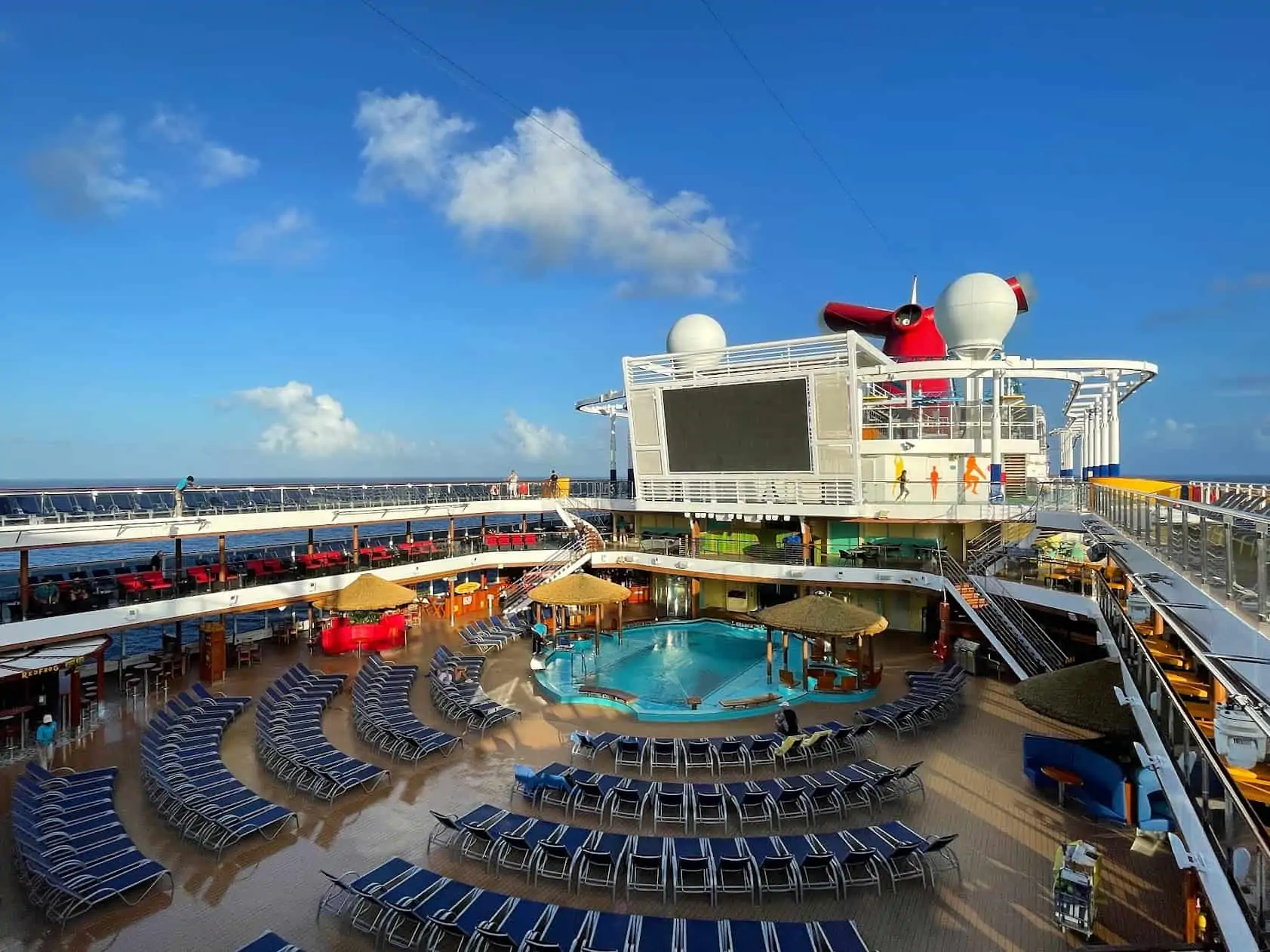
Take a break and head up to the deck for some fresh air. Breathing in the salty sea breeze can help alleviate seasickness symptoms and provide a calming effect.
If it’s too windy, try finding a sheltered spot where you can feel the breeze without being exposed to strong gusts.
7. Consider Natural Seasickness Remedies

Remember that old saying about an apple a day can keep the doctor away? While that might not be true, eating apples can alleviate seasickness—but not just any apple, though.
Look for green Granny Smith apples; their pectin combined with natural sugars reduces acid and settles topsy-turvy stomachs.
Peppermint is also known to have the same effects against seasickness. If you’re lucky, you might find some cruise line sundry shops selling peppermint oil.
At the end of the day, cruisers have little to lose by trying out some of these natural solutions for seasickness before taking medication. Their low cost and ease of access are appealing.
Final Thoughts

Don’t let motion sickness keep you from experiencing what the cruise ships offer!
Just remember to stay hydrated, avoid heavy meals, and take preventative medication if necessary to avoid seasickness on a cruise.
The U.S. Centers for Disease Control also lists more tips and remedies to help avoid motion and seasickness .
Medical Disclaimer: This article is not a substitute for professional medical advice, diagnosis, or treatment. Always seek the advice of your physician or other qualified health providers with any questions you may have regarding a medical condition.
Pin it for later!

Related Posts
- Norwegian Gem Set to Launch Cruises from Jacksonville in 2025
- Tender Issues Cause NCL Cruise Ships to Skip Venice
- The First Cruise Line in History Will Homeport in Washington, D.C.
- Carnival Expects Revenue Hit by Scraping Red Sea Transits on 12 Ships
- Cruise Ship Trash Was Slashed 92% in Juneau Last Year
Recent Posts
- MSC Cruises Joins 2025 Brad Pitt Film
- Princess Cruises Launches Faster Premium Wi-Fi Tier, MedallionNet Max
- Royal Caribbean’s Ship Set for $100 Million Makeover with New Pools, Bars, and Suites
- Ocean Liner Could Become Artificial Reef

Share this post

Bringing you 15 years of cruise industry experience. Cruise Radio prioritizes well-balanced cruise news coverage and accurate reporting, paired with ship reviews and tips.
Quick links
Cruise Radio, LLC © Copyright 2009-2024 | Website Designed By Insider Perks, Inc
How to Prevent Seasickness on a Cruise
Here are a few tips on how to prevent seasickness on your next cruise and how to manage it if you get seasick! First, it’s important to know that while it’s frequently discussed, most people don’t have an issue with motion sickness or seasickness. So don’t let it scare you from taking a cruise. Severe seasickness is uncommon but not unusual for some new cruisers to get a bit nauseous on their first cruise (usually only the first day).
We’ve compiled a list of some of the best-known remedies to deal with mild seasickness as well as tips for preventing it.
- Seasickness is common among new cruisers but can be managed.
- Causes of seasickness include visual disorientation due to the ship’s motion.
- Tips for preventing seasickness include choosing the right cabin location and going outside for fresh air.
- Remedies for seasickness range from natural options like ginger and pressure bands to over-the-counter medications like Dramamine and prescription patches like Scopolamine.
What causes seasickness?
Seasickness, also known as motion sickness is thought to be caused by the visual disorientation resulting from being on an object in motion (the cruise ship) competing against our body’s natural tendency for balance. Studies have shown that some people become seasick by suggestion. They simply convince themselves that being on a ship will make them feel sick. On the other hand, for those who can dismiss the idea of seasickness, it’s often no problem. Mind over matter! Seasickness is more prevalent in children and women, though children under two seem to be unaffected by motion sickness.
Tips on how to prevent seasickness on your next cruise
Choosing the right cabin location will mitigate any feeling of seasickness while you’re in for the night. Cabins on lower decks and more central to the ship tend to feel less movement than higher cabins in the front or rear. Additionally, the smaller the ship, the more movement people usually feel. Larger cruise ships are better stabilized, making the motion on the cruise ship significantly less noticeable.
If you’re already underway and starting to feel a bit nauseous, here’s some basic advice to treat your seasickness: Most people begin to feel seasick while inside the ship as it gets underway because the movement sensation doesn’t match what they are seeing (stationary objects). So if you’re worried about feeling a little seasick when the ship departs, try to go outside and see the departure from the pool deck. Fresh air and a better perspective on what’s in motion will help tremendously!
What Helps With Seasickness On A Cruise?
We’ve compiled a list of the most frequently used remedies for motion sickness / seasickness.
Natural remedies for seasickness that may work for cruisers
If you’re feeling nauseous on your cruise and do not have any typical seasickness medications handy, there are a few things that could help you feel better quickly.
Try eating green apples and crackers. This is such a common remedy for nausea that ships often have green apples and crackers on their room service menus or put them out in the buffet regularly.
Other edibles that can help nausea are ginger candy or ginger tea. Experienced cruisers swear by the benefits of ginger edible products to help soothe seasickness and motion sickness. Plan ahead and pack a couple forms of ginger if you’re afraid you may have an issue with being a little seasick. Edibles come in many forms including chewy candy, pills, tea, extracts, powders, etc.
Get the best-rated ginger chews by Dramamine on Amazon
Not feeling so well? Step outside for some fresh air and drink a lot of water. This often will correct a mild case of nausea when you’re on your cruise.
Medication and over-the-counter products to help with seasickness & motion sickness.
Dramamine or Meclizine (common name Bonine) are the most common over-the-counter medications to treat motion sickness & seasickness. Most cruisers prefer traditional Dramamine, but be aware that the original formula can cause drowsy side effects. There is now a “less-drowsy” and a non-drowsy version of Dramamine. The non-drowsy Dramamine is largely made of ginger root.
TIP: If it’s the first time you’ll be using Dramamine, take one before your cruise so you understand how drowsy it will make you and any other side effects.
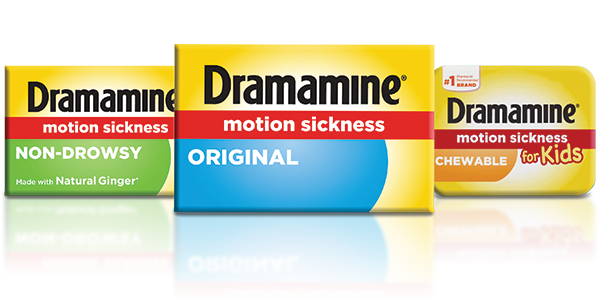
Prescription remedies to treat seasickness and nausea :
Scopolamine (Transderm Scop) is the most commonly prescribed seasickness medication. It’s an adhesive patch you put behind your ear a few hours before you think you’ll need it. Scopolamine is not available over the counter due to possible side effects, so you’ll need to speak to your doctor to get these prescribed. These patches are generally used for travelers who are known to experience severe motion sickness.
Other Seasickness Remedies – Bands
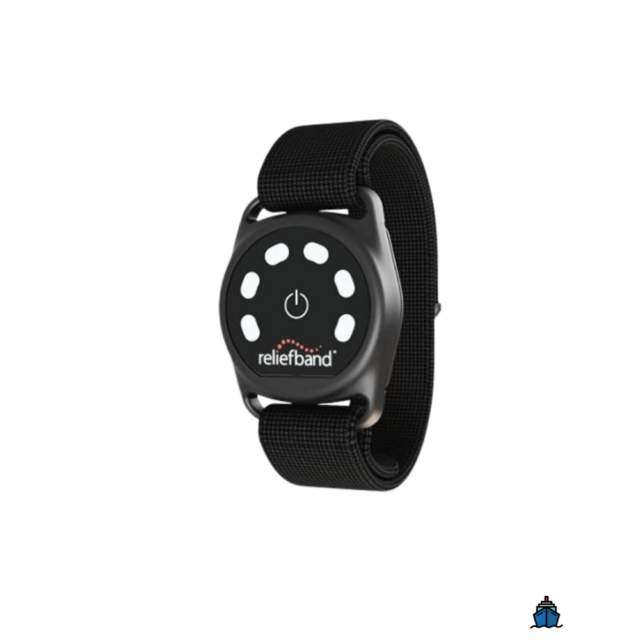
There are a few types of seasickness bands you’ll find on the market. Some are simple elastic bands with a little piece of plastic that applies pressure on the wrist sending the brain signals to suppress the feeling of nausea. Other more technical devices like the Relief Band are medical devices that when worn emit a slight electroshock to the wrist area to accomplish the same suppression of nausea.
We’ve traveled with friends who swear by these types of bands to relieve seasickness, but how effective bands are will depend on the person. It’s a great option for people who don’t want to ingest pills or wear patches!
Cruise Gear Editor
I'm a global nomad at heart, and the dedicated editor behind CruiseGear. For the past two decades, I've experienced exciting voyages across the world, discovering countless ports from the decks of dozens of ships, visiting 40+ countries (and living in some of them for years). It's been an exhilarating journey to say the least! I want to share everything I've learned and hope to make your next cruise vacation as enjoyable as possible.
Leave a Reply Cancel reply
Your email address will not be published. Required fields are marked *
Subscribe to our Monthly Cruise Digest?
Review Cart
No products in the cart.
- Search Please fill out this field.
- Manage Your Subscription
- Give a Gift Subscription
- Newsletters
- Sweepstakes
We independently evaluate all of our recommendations. If you click on links we provide, we may receive compensation.
- Travel Products
- Travel Accessories
The Best Motion Sickness Remedies, According to a Travel Writer with Chronic Nausea
From ginger gum to peppermint oil, here’s how I prevent motion sickness from ruining a trip.
:max_bytes(150000):strip_icc():format(webp)/Anna-Popp-Bio-Photo-e2a2cfe2bcfd44b7a393b9b2d08c102c.jpg)
In This Article
- Our Top Picks
- Tips for Buying
Frequently Asked Questions
- Why Trust T+L
Travel + Leisure / Anna Popp
As an avid traveler that gets queasy even in elevator rides, I’ve developed quite the toolbelt for combating nausea, vomiting, and dizziness caused by motion sickness. A recent run-in with choppy seas and a tiny catamaran boat in Greece reminded me how important it is to embark on a trip prepared for anything, so I’m providing you with all the remedies I keep in a pouch when I leave home — or as a like to call it, my anti-barf bag.
From over-the-counter medication to natural remedies, I like to keep a variety of options on hand depending on the type of sickness I’m feeling. Of course, it varies by person, but it never hurts to have multiple methods of relief packed in your travel pouch . While I’ll spare you the graphic details from my experiences with motion sickness, keep reading to see all my favorite remedies to help decide which ones are best for you.
Best for Flying
Sea-band anti-nausea ginger gum.
Chewing gum and ginger both can relieve nausea, so this two-in-one remedy really does the trick.
The ginger flavor can wear off quickly.
T+L senior commerce writer — and fellow motion sickness sufferer — Merrell Readman turned me on to this pack of ginger gum for when I need fast nausea relief during a flight. Since chewing gum and consuming ginger settles the stomach, this motion sickness remedy works faster than other remedies in my opinion, which is important when resources and options to lie down are limited on a flight. I also love that I can keep a pack of this Sea-Band ginger gum in my personal item so I can access it easily underneath the airplane seat.
Best Motion Sickness Glasses
Hion motion sickness glasses.
The liquid inside the glasses acts as a fake horizon, which equalizes the brain, eyes, and inner ear to prevent motion sickness.
They look a little goofy to wear.
Another gadget I swear by: these motion sickness glasses are super handy for road trips and train rides alike. One of the best remedies to motion sickness is keeping your eyes on the horizon, and if you can’t do that, the four circular “lenses” in these glasses have a blue liquid on the inside that creates a fake horizon. This tricks the brain into equilibrium with the eyes and inner ears, which can prevent motion sickness when every part of the party is in agreement. Sure, they look a little silly, but it’s worth it to be able to enjoy a car, train, or boat ride without getting sick.
Travel + Leisure / Anna Popp
Best for Seasickness
Dramamine all day less drowsy motion sickness relief.
The pills are anti-emetic, which help prevent vomiting from motion sickness.
It needs to be taken before seasickness hits to be most effective.
I’m going to spare you the graphic details, but let’s just say my recent catamaran tour in Santorini didn’t go as planned. The only thing that saved me from additional trauma was this little travel-size pack of Dramamine. Thankfully, the anti-emetic pills did an excellent job of keeping things down after they started working about 30 minutes to an hour after I took them. Word to the wise: if you know you get seasick, you should pack these tabs whether you're heading on a long cruise or day tour and be sure to take them ahead of time for the most effective use. It's also always a good idea to keep your eyes on the horizon if you start getting seasick.
Best Wristband
Sea-band comforting acupressure bands.
With a plastic ball on the interior, these wristbands apply pressure to the P-6 pressure point to relieve nausea and vomiting.
The wristbands are made with fabric that can get sweaty or dirty easily.
Along with severe motion sickness, I also feel the effects of altitude change — lucky me. Whenever I travel to a mountain town for skiing or just exploring, I always bring these acupressure wristbands. The pressure point 6 (sometimes called Neiguan) can alleviate the feeling of nausea and vomiting when pressing down on the spot in the forearm. I found that the little plastic ball on the inside of the wristband applies the perfect amount of pressure that was hardly noticeable when I wore the band all day every day. I wore both wristbands when I was feeling sick on a trip to Utah and they worked quickly at relieving my altitude sickness.
MQ Motion Sickness Patch
One patch can last up to three days.
They have a strong herbal scent that can be bothersome.
These patches offer a quick and discreet solution to nausea and dizziness. The medicinal patches can be placed behind the ear or below the belly button, and they can last up to 72 hours before you’ll want to replace it with a fresh patch. I like that the patches can be worn in the shower or in a pool without losing the effectiveness of the medicinal properties. Because the patches are made with herbs like ginger and safflower, they have an earthy scent that might irritate some people — though I didn’t mind it.
Best Essential Oil
Doterra peppermint essential oil.
Peppermint is a soothing scent for combating nausea.
It can leave a burning sensation when it comes in contact with skin.
Just when you thought having chronic nausea and motion sickness was bad enough, I also suffer from hereditary migraines (thanks, Mom). While I have prescription medication for migraines, I always keep a bottle of peppermint or lavender essential oil on hand as well since migraines can also cause nausea. Both lavender and peppermint scents offer a relaxing aroma for calming the mind , which can be hard to do when you’re tense from nausea. I also dab a bit of peppermint oil on my temples to relieve headaches and I find that to be extremely helpful, too.
Yogi Tea Stomach Ease
This ginger-flavored tea is designed to calm and soothe the stomach.
It may not be as easy to find hot water while you're traveling.
It can be helpful to sip on a liquid when you’re nauseous, especially a tea made with herbs and roots like ginger that are known for medicinal properties. Aside from ginger, this tea is also made with licorice root, cardamom, fennel seed, peppermint, and more natural ingredients to soothe the stomach. I like the herbal and earthy flavor of the tea, but it might not be for everyone since it is relatively strong. The box comes with wrapped tea bags that make it easy to toss a few in a purse so all you have to do is get some hot water on an airplane to make a soothing cup of tea.
Tips for Buying Motion Sickness Remedies
Think about your itinerary.
Some motion sickness remedies are better than others for airplanes, cars, or boats, so consider the type of trip before investing in certain products. If you know you’ll be swimming a lot, consider a remedy like patches or wristbands that can be worn in the water. For trips with activities that involve rigorous activities or operating equipment, steer clear of using medications that could make you drowsy like Dramamine.
Test your remedy before big trips
Motion sickness remedies can have different side effects and results in each person, so it’s important to try the product before you go on a trip. The first thing you should do is consult your doctor before starting a motion sickness remedy, especially medication. Depending on your medical history, certain products might not be best for you and the only way to ensure safely using any product is to check with a licensed medical professional.
Have a backup
If you’re like me and you know you get motion sick, then it’s crucial to have a variety of remedies on hand. I never leave the house without multiple forms of relief from medication to natural products. Also, make sure you check with a doctor before doubling up on motion sickness medication and products to make sure it’s safe.
When you’re walking down the street, your body and brain are in sync with the motion and surroundings. However, when you head off on a road trip , get in a moving boat, or airplane, your eyes, inner-ear, body, and brain, can get out of sync, causing side effects like nausea, vomiting, and dizziness. This is why it’s important to keep your eyes on the horizon when you can to try to minimize the confusing signals sent to the brain from the eyes and inner-ear.
The P-6 pressure point is located in the middle of the forearm a few inches down from the wrist. Applying pressure to this area with your fingers, or with the Sea-band wristband, might help alleviate nausea caused by motion sickness.
While it depends on the person, chewing gum can be an effective way to combat nausea caused by motion sickness. When I was on a boat in Greece, the deckhands gave me a minty gum that immensely helped with my severe motion sickness.
Why Trust Travel + Leisure
Anna Popp is an associate commerce editor at Travel + Leisure , where she covers all of the best travel products from carry-ons to comfy shoes. As a frequent traveler who also suffers from severe motion sickness, Anna has tried dozens of remedies to alleviate side effects from motion sickness. Although every traveler is different, Anna pulled from her own experiences and research to recommend her favorite motion sickness remedies that are worth trying.
Love a great deal? Sign up for our T+L Recommends newsletter and we'll send you our favorite travel products each week.
:max_bytes(150000):strip_icc():format(webp)/TaylorFoxHeadshot-7375be27aedf4b0ea0e0189a4befe7d0.jpeg)
Related Articles
Cruisebound
Best motion sickness medicine for cruises.

Seasickness is one of the most common (and worst) ways to spoil a vacation. Constant nausea, headaches, and discomfort are the last feelings anyone wants, especially while traveling or enjoying a getaway. Motion sickness on a cruise can affect anyone, even people with little to no prior history of it. Thankfully, there are a variety of steps you can take to prevent and stop sea sickness in its tracks during your cruise.
Note that every person is different, so popular options that work for some may not be the best choice for others. For first-time cruisers, it’s worth trying a few remedies to find the best motion sickness medication that works for you.
What Causes Motion Sickness on Cruises?
Best over-the-counter nausea medicine for cruises: dramamine and bonine (mild to moderate), prescription scopolamine patch for cruises (moderate to severe), prochlorperazine suppositories: when all else fails (severe), natural and holistic treatments for motion sickness (mild).
- Practical Tips on Preventing Seasickness on a Cruise
To fix motion sickness, knowing what causes it is important. When you’re inside a moving cruise ship, your eyes perceive everything as still. Meanwhile, your inner ear, which works to keep your body balanced, senses movement and sends contrasting signals to your brain. This mixed messaging can cause unpleasant effects ranging from slight discomfort to strong nausea and vomiting.
What is the Best Medicine for Cruise Motion Sickness?
While prevention is the best defense, there's a wide range of options to find the best medicine to take on a cruise. Between over-the-counter, like Dramamine and Bonine, to prescription-strength, such as Scopolamine patches and suppositories, and various alternatives like acupressure bands and natural remedies, you’ll be well-equipped for smooth sailing.
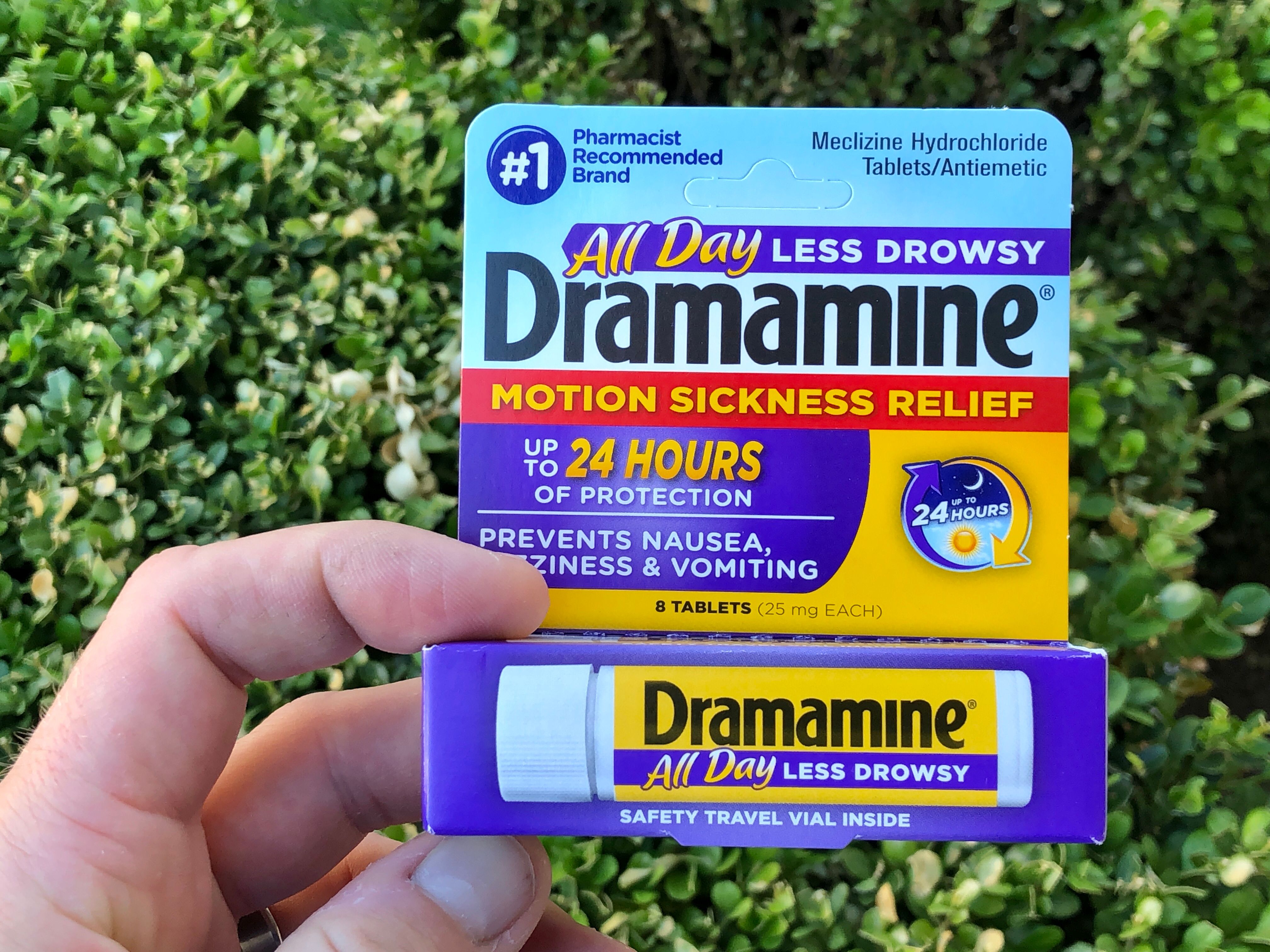
Over-the-counter antiemetic drugs like Dimenhydrinate (Dramamine) and Meclizine (Bonine) are both effective and easily accessible, making them some of the best seasickness medication for cruises.
Dramamine medication for seasickness on cruises works by blocking the signals to the brain that trigger nausea and vomiting. It’s effective for 4-6 hours and should be taken as needed (not exceeding the maximum daily dosage recommended on the package).
While it’s widely recognized as the best medication for motion sickness on a cruise, a common side effect of taking Dramamine for cruises is drowsiness, which may temporarily sideline you from vacation activities. A non-drowsy option is available but isn’t considered to be as effective as the standard formula.
Bonine is another great medicine for cruisers facing motion sickness, hailed for its long-lasting effects ranging up to 24 hours for a once-daily dose. Bonine’s fast-acting relief properties also make it one of the best nausea medicine for cruises that may hit rough, choppy waters unexpectedly.
Like Dramamine, Bonine may cause drowsiness, with additional side effects like dry mouth and headaches. If you’re planning to enjoy alcohol during your cruise, consider other anti nausea for cruise options. Mixing alcohol with Dramamine or Bonine can intensify their side effects significantly.
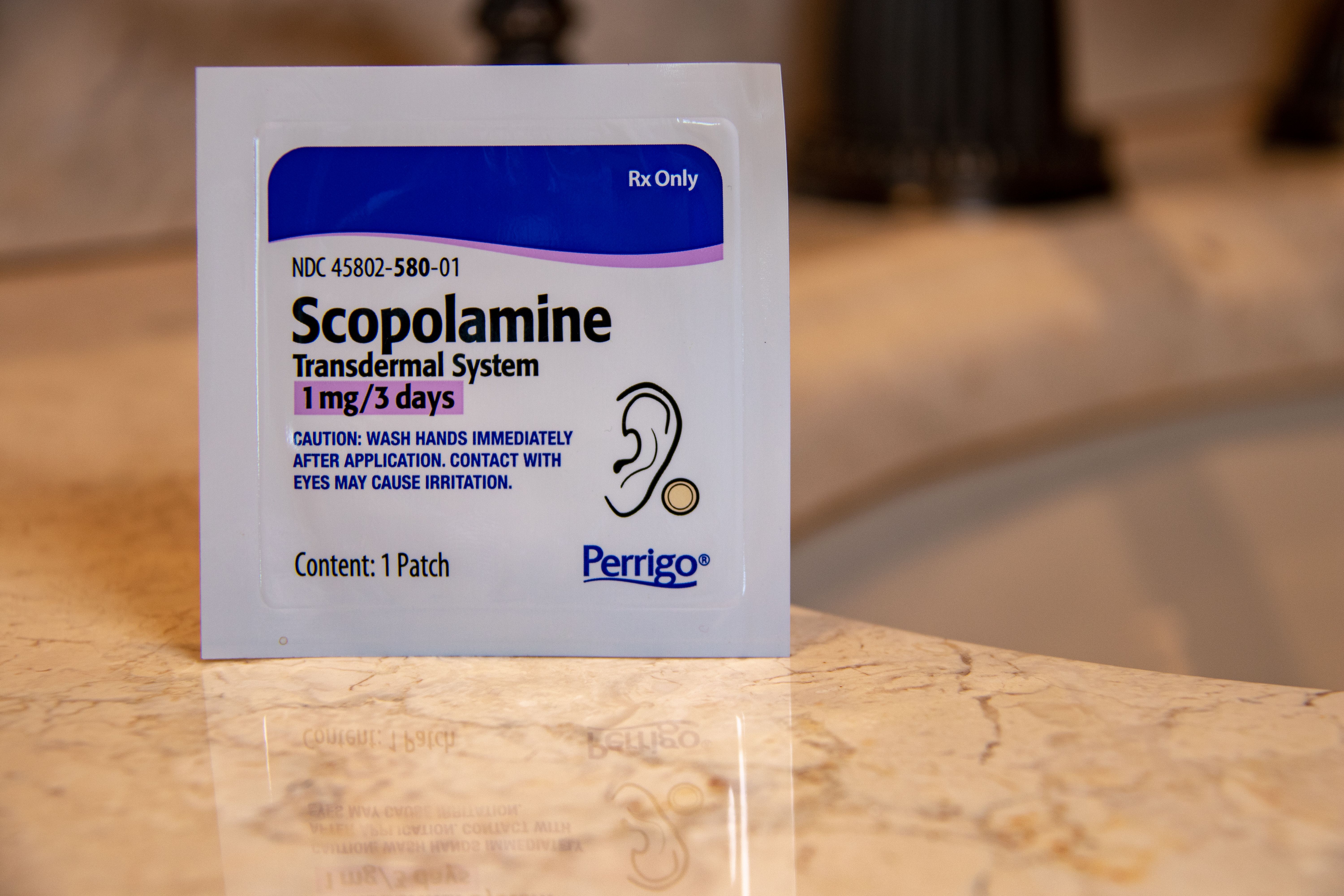
If you’re looking for a more potent medicine for seasickness, cruise patches are an excellent choice. Among patches for motion sickness, cruisers tend to choose Scopolamine over others. This transdermal patch delivers long-lasting relief to your central nervous system and gut when placed behind your ear, working for up to three days after application.
The Scopolamine patch is recommended as the best motion sickness patch for cruisers who’ve experienced moderate to severe seasickness in the past.
Known as the best seasickness patch for cruises for its ease of administration and consistent effectiveness, it’s important to be prepared for possible side effects like dry mouth and dizziness. Consult with your doctor first if you have a history of respiratory, cardiovascular, gastrointestinal, neurological, urological, psychiatric, renal, hepatic, or muscular disorders. Avoid alcohol while using Scopolamine as the combination can heighten side effects.
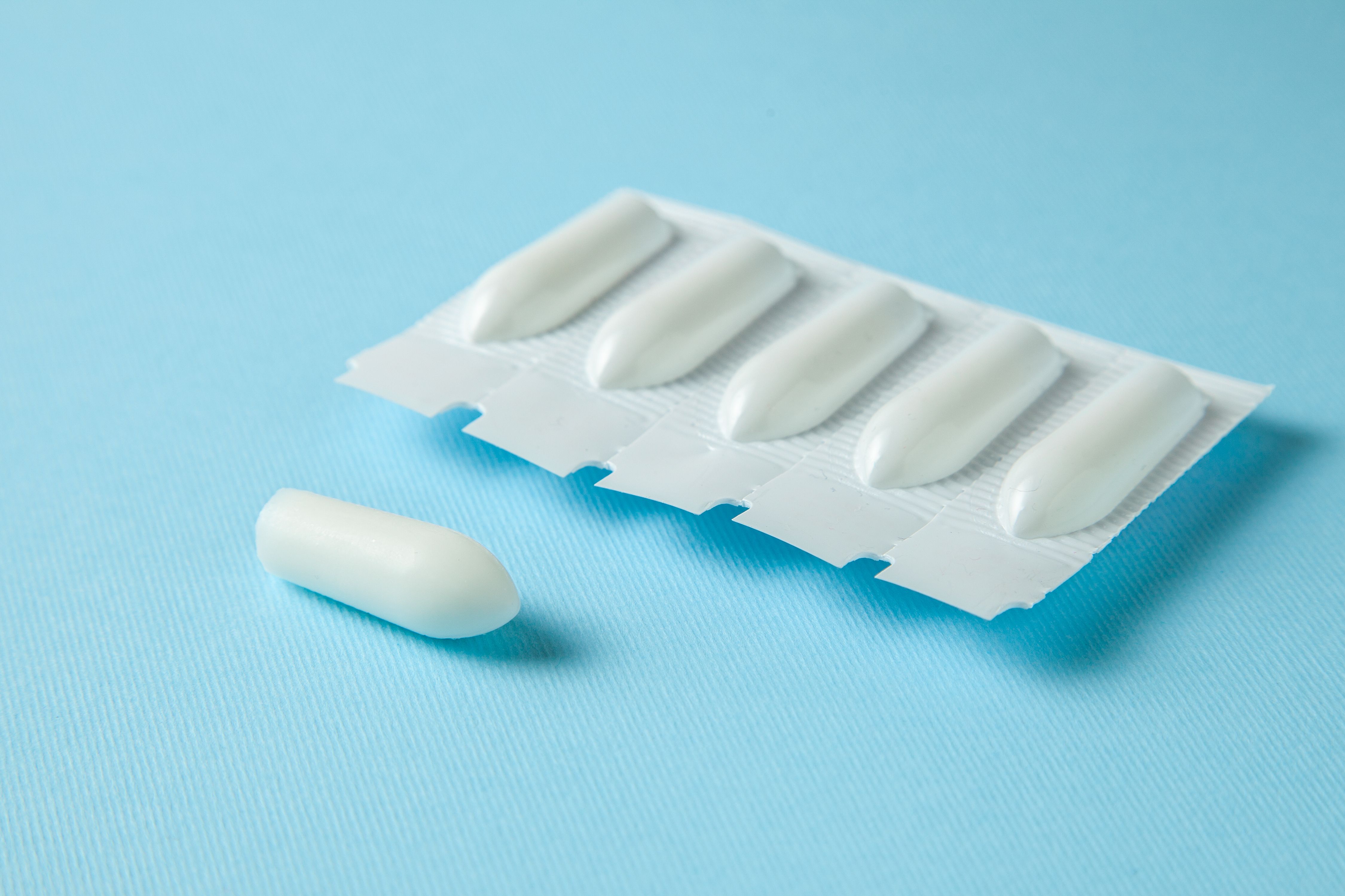
One less commonly prescribed, but arguably the most effective medicine for cruise motion sickness, is physician-administered Prochlorperazine (Compro or Compazine). This suppository is typically available onboard, especially for guests facing severe symptoms such as cold sweats, pallor, and constant vomiting. Your cruise physician can assist with administration up to twice a day.
Prochlorperazine works by quickly targeting and neutralizing substances in your body that cause nausea and vomiting. Its effects usually last about 3 to 4 hours before having to be re-administered. Prochlorperazine is the best seasick medicine for cruisers who can’t hold down food during their cruise, especially children older than 2 years.
Common side effects of Prochlorperazine include dry mouth, drowsiness, headaches, blurred vision, and stuffy nose; however, they are usually mild and go away on their own Prochlorperazine is not recommended if you have a history of blood clots, bowel blockage, or epilepsy. Talk to your cruise physician if you begin to experience nausea or vomiting at sea.
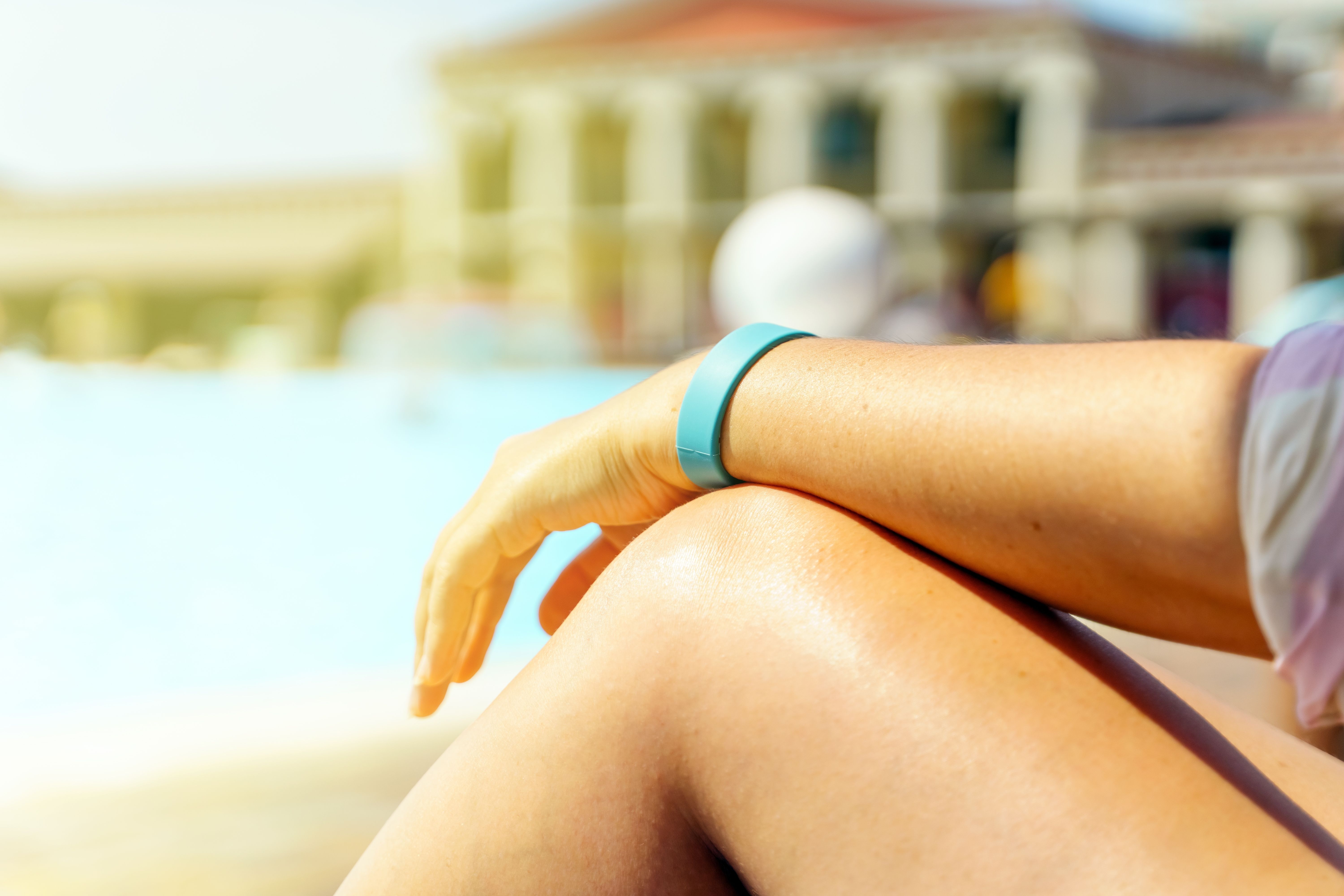
Apart from medicines, motion sickness bands, or acupressure sea-bands, are one of the more gentle seasickness remedies cruisers tend to opt for. Sea Bands for cruises work by pressing a plastic bead against the Nei-Kuan pressure point on your wrist. By hitting that pressure point, the median nerve is stimulated, which disrupts nausea signals from being sent to the brain.
A frequently asked question is “can you wear sea bands overnight”? While the answer is yes, the effectiveness may differ from one person to another.

For some people, natural methods are the best remedies for seasickness on a cruise, with ginger being a popular choice. Ginger works to ease nausea by clearing out your stomach and can be taken in many forms, like candies, teas, or pills.
Essential oils, like peppermint and lavender, complement your natural arsenal by soothing stomach discomfort and promoting overall well-being. Try inhaling these oils through a diffuser to relax the gastric muscles, reduce anxiety, and improve sleep quality.
Many travelers swear by a combination of holistic treatments as the best motion sickness remedy for cruises. Mix and match these remedies to naturally prevent nausea and vomiting without medicine.
Practical Tips on How to Prevent Seasickness on a Cruise
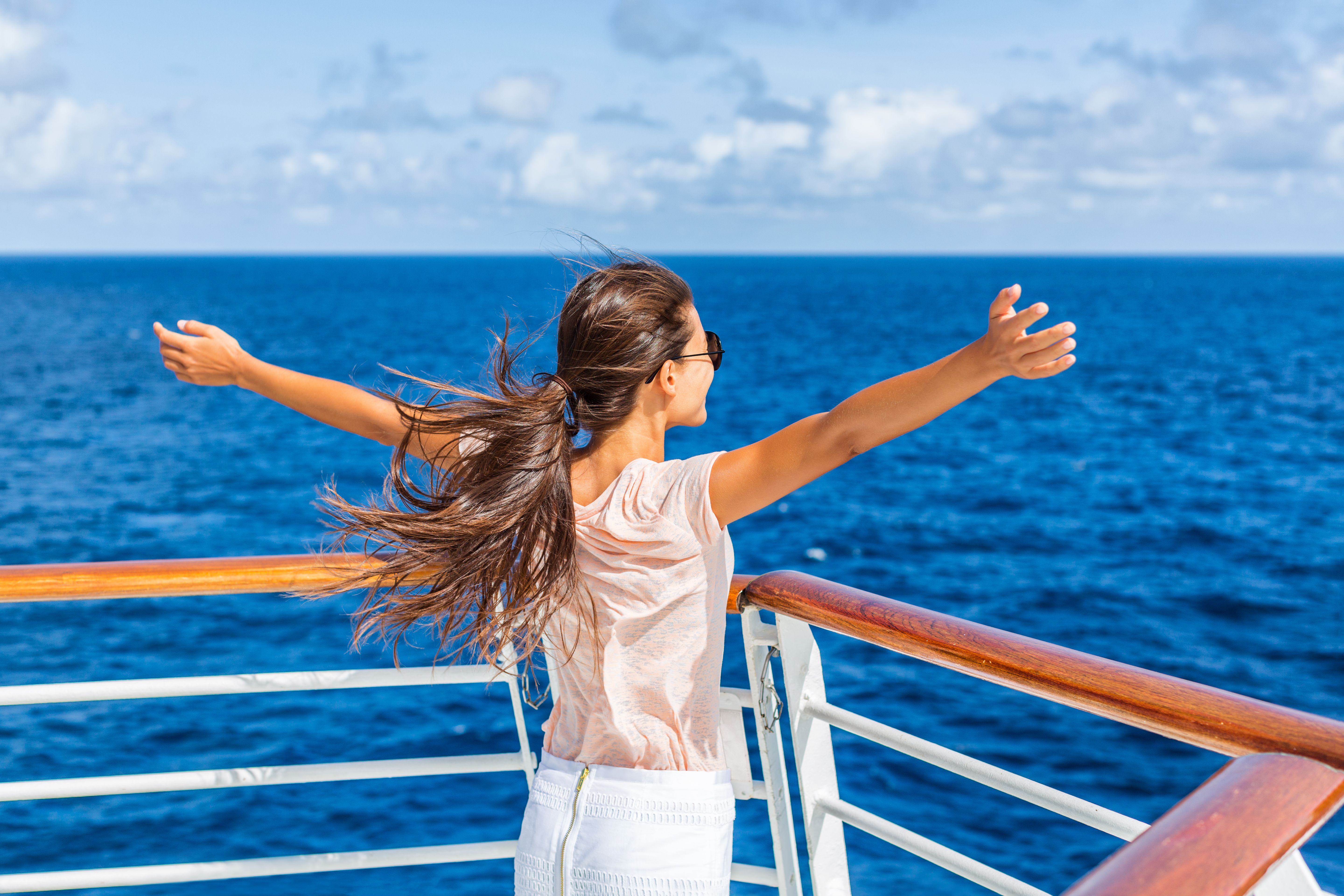
One of the best motion sickness prevention for cruises is to care for your health and well-being while on board, making it easier to have fun and explore. Here's a brief checklist of how to prepare effectively:
- Room Selection : The best cruise rooms for motion sickness are in the middle of the ship and on a lower deck.
- Cruise Cabins to Avoid : Do not book a room at the front or back of the ship, since that is where motion is felt the most.
- Stay Refreshed : Avoid big, rich meals and alcohol. Eat lighter foods in smaller portions, while drinking plenty of fluids. Drink water or drinks with electrolytes, and avoid heavily caffeinated or sugary drinks.
- Eat Green Apples : The pectin in green apples neutralizes stomach acid, and the natural sugars can settle a queasy stomach. Tossing a couple into your diet can make green apples seasickness solutions that are both effective and delicious.
- Get Enough Sleep : Make sure to stay well rested during your cruise. Sleep deprivation can worsen motion sickness symptoms.
- Limit Technology Use : Looking at a screen can worsen motion sickness symptoms. Try to spend as little time on screens as possible well on the ship.
- Avoid Smoking : Smoking can enhance motion sickness symptoms.
Sail Beyond Seasickness
With the best cruise motion sickness medicines on hand, visit Cruisebound to find your next cruise. Whether you opt for a cruise medicine or a non-pharmaceutical remedy for nausea, the world's wonders are yours to explore without the worry of motion sickness.

After Cruise Motion Sickness: Causes, Symptoms, and Treatment Options

Do you ever feel like you’re still on a cruise ship even after you’ve returned home? Do you experience symptoms such as dizziness, nausea, and a rocking sensation that just won’t go away?
If so, you may be suffering from a condition known as mal de debarquement syndrome (MdDS).
MdDS is a rare motion disorder that affects some people after they disembark from a boat or ship. Symptoms can persist for days, weeks, or even months after the cruise has ended, making it difficult for sufferers to resume their daily activities.
While the exact cause of MdDS is not fully understood, it is believed to be related to a mismatch between the brain’s perception of motion and the body’s actual movement.
Fortunately, there are ways to manage the symptoms of MdDS and get your land legs back. From medication to natural remedies, there are various options available to help alleviate the discomfort associated with this condition.
In this article, we will explore the causes and MdDS symptoms, as well as the most effective treatments for after-cruise motion sickness.
Understanding Motion Sickness

The inner ear, also known as the vestibular system, is responsible for maintaining your body’s sense of balance and orientation. When you are in motion, the vestibular system sends signals to your brain to help it understand your body’s position and movement.
However, if your eyes see something different from what your inner ear is sensing, it can cause a conflict in your brain, leading to motion sickness.
After cruise motion sickness (aka land sickness) can affect anyone, but some people are more susceptible to it than others. Women, children under 12, and people with a history of migraines or inner ear problems are more likely to experience this balance disorder.
Symptoms include nausea, vomiting, dizziness, sweating, and fatigue. These symptoms can be mild or severe and can last for minutes or hours, depending on the severity of the motion sickness.
To prevent land sickness, it is important to avoid activities that can trigger it, such as reading while in motion or sitting in the backseat of a car. It is also helpful to keep your eyes fixed on a stable object, such as the horizon, and to avoid looking at moving objects.
If you do experience such symptoms, there are several remedies that can help alleviate the nausea. These include taking over-the-counter medications, such as antihistamines or ginger supplements, and practicing deep breathing and relaxation techniques.
Specifics of After Cruise Motion Sickness
After a cruise, it’s common to feel like you’re still on the ship for a short period of time. This feeling is known as “sea legs” and is caused by your brain still adjusting to being back on land.
However, for some people, the symptoms of motion sickness can persist for days or even weeks after the cruise has ended. This is known as after cruise motion sickness or mal de debarquement syndrome (MDDS) .
MDDS is a rare condition that affects a small percentage of people who have been on a cruise. The symptoms of MDDS can include a persistent feeling of rocking or swaying, dizziness, nausea, and fatigue. These symptoms can be mild or severe and can last for days, weeks, or even months.
The exact cause of MDDS is unknown, but it is believed to be caused by a mismatch between the signals that your brain receives from your inner ear and your eyes. This mismatch can cause your brain to continue to perceive motion even when you are stationary, leading to the symptoms of MDDS.
If you are experiencing symptoms of MDDS after a cruise, it’s important to seek medical attention. Your doctor may be able to recommend treatments such as medication or physical therapy to help alleviate your symptoms.
It’s also important to take steps to prevent MDDS before and during your cruise. This can include taking medication to prevent motion sickness, staying hydrated, and avoiding alcohol and caffeine. Additionally, during the cruise, you can try to stay in the middle of the ship, where there is less motion, and avoid looking at the ocean or other moving objects.
Symptoms of Land Sickness
If you have ever experienced motion or land sickness, you know how uncomfortable it can be. The symptoms can vary from person to person, but some common symptoms include:
These symptoms can last for hours or even days, depending on the severity of your motion sickness. In some cases, you may experience migraines or headaches as well.
One of the most common symptoms is imbalance. You may feel like you are swaying or rocking, even when you are standing still. This can make it difficult to maintain your balance and can lead to falls.
In addition to imbalance, you may also experience tiredness and fatigue. This can make it difficult to focus and can affect your overall mood. Some people even experience depression as a result of their motion sickness.
If you are experiencing any of these symptoms, it is important to take steps to manage your motion sickness. This may include taking medication, avoiding certain foods or activities, or using relaxation techniques to reduce anxiety.
How to Prevent Land Sickness After Your Cruise

While there is no foolproof method to prevent land sickness, you can take certain steps to help minimize its effects:
- Gradual Adjustment: Give your body time to readjust to the stable ground. Avoid making sudden movements and take it easy during the first few days after disembarking from the cruise ship.
- Stay Hydrated: Drink plenty of water to stay hydrated, as dehydration can worsen the symptoms of land sickness.
- Get Adequate Rest: Allow your body to recover from the physical and sensory changes experienced during the cruise. Get enough sleep to aid in the readjustment process.
- Avoid Stimulants: Limit the intake of caffeine, alcohol, and other stimulants that can disrupt your body’s natural equilibrium.
- Focus on the Horizon: When walking or standing, try to focus on the horizon or a stable object in the distance. This can help your brain reorient itself and reduce the sensation of movement.
- Avoid Prolonged Screen Time: Minimize excessive screen time, such as watching TV or using a computer, as this can exacerbate symptoms.
- Motion Exercises: Gentle motion exercises, like rocking or swaying slowly while sitting or standing, might help your body adapt to the changes.
- Balance Training: Engage in simple balance exercises, like standing on one leg or walking in a straight line, to improve your body’s balance mechanisms.
- Deep Breathing and Relaxation Techniques: Practicing deep breathing and relaxation exercises can help reduce stress and alleviate symptoms.
- Consult a Healthcare Professional: If the symptoms persist or become severe, consult a healthcare professional experienced in treating motion-related issues or vestibular disorders.
It’s important to remember that land sickness usually resolves on its own within a few days to a few weeks. However, if the symptoms persist for an extended period or interfere with your daily life, it’s best to seek medical advice.
As with any medical condition, individual responses may vary, and the effectiveness of preventive measures can differ from person to person.
If you are concerned about land sickness or have any underlying health conditions, consult a healthcare professional for personalized advice and guidance
Preventing Motion Sickness on Your Cruise
If you’re planning a cruise, you may be worried about getting motion sickness. Fortunately, there are several ways to prevent it.
Choose Your Cabin Wisely
When booking your cabin, try to choose one in the middle of the ship. This is the most stable area of the ship and will experience the least amount of movement. Additionally, cabins that are located on lower decks tend to experience less motion than those on higher decks.
Take Advantage of Stabilizers and Hull Design
Modern cruise ships are equipped with stabilizers that help reduce the amount of rolling and pitching. Additionally, the hull design of newer ships is optimized to reduce motion. When booking your cruise, try to choose a newer ship that has these features.
Look at the Horizon
When you’re on the ship, try to focus on the horizon. This can help reduce the feeling of motion sickness. Avoid looking at anything that is moving, such as the waves or other passengers.
Avoid Reading
Reading while on a moving ship can make motion sickness worse. If you’re prone to motion sickness, try to avoid reading while on the ship.
Get Fresh Air
If you’re feeling queasy, try to get some fresh air. Go outside on the deck and take deep breaths. This can help you feel better.
Avoid Windy Areas
Windy areas of the ship can exacerbate motion sickness. Try to avoid areas where there is a lot of wind.
Medications
If you’re prone to motion sickness, talk to your doctor about medications that can help prevent it. There are several over-the-counter and prescription medications that can be effective. However, be aware that some medications can cause drowsiness.
Motion Sickness Medications

Meclizine is an over-the-counter medication that come as motion sickness pills. It is an antihistamine that works by blocking the effects of histamine, a chemical in the body that can cause nausea and vomiting. Meclizine is available in tablet form and should be taken at least one hour before traveling.
Scopolamine is a prescription medication that is available in patch form. It is a type of anticholinergic medication that works by blocking the effects of acetylcholine, a chemical in the body that can cause nausea and vomiting. The patch should be applied behind the ear at least four hours before traveling and can be effective for up to three days.
Dramamine is an over-the-counter medication that can be used to treat motion sickness. It contains the active ingredient dimenhydrinate, which is an antihistamine that can help alleviate nausea and vomiting. Dramamine is available in tablet or liquid form and should be taken at least 30 minutes before traveling.
It is important to note that these medications can cause drowsiness as a side effect, so it is recommended that you avoid driving or operating heavy machinery while taking them.
Additionally, some medications may interact with other medications you are taking, so it is important to speak with your healthcare provider before taking any new medication.
Natural Remedies for Motion Sickness
If you’re looking for natural remedies to help ease your motion sickness after a cruise, there are several options to consider. These remedies can help alleviate symptoms like nausea, dizziness, and vomiting.
One of the most popular natural remedies for motion sickness is ginger. Ginger has been used for centuries to treat nausea and vomiting, and studies have shown that it can be effective in reducing symptoms of motion sickness as well. You can try drinking ginger tea or taking ginger supplements to help alleviate your symptoms.
2. Fresh Air
Another natural remedy is fresh air. When you’re feeling nauseous or dizzy, getting some fresh air can help provide relief. If possible, step outside onto the deck of the ship or open a window in your cabin to get some fresh air.
3. Acupressure Bands
You may also want to try using acupressure bands. These bands apply pressure to certain points on your wrist that are believed to help alleviate nausea and vomiting. They are safe, easy to use, and can be found at most drugstores.
4. Peppermint
Peppermint is another natural remedy that can be effective in reducing symptoms of motion sickness. Peppermint has a calming effect on the stomach and can help alleviate nausea. You can try drinking peppermint tea or using peppermint essential oil to help ease your symptoms.
5. Green Apples
Green apples are believed to help with motion sickness due to their natural acidity and fresh aroma. Green apples have a slightly higher level of acidity than other apple varieties. Some people claim that the acidity can help neutralize stomach acids, reducing feelings of nausea and discomfort associated with motion sickness. (I got ill on a cruise one time from large waves and I ate half a green apple with some sprite and within 20 min I was feeling much, MUCH better).
6. Alcohol Pads
Smelling alcohol pads for nausea is a home remedy that some people use to try and alleviate feelings of nausea. The idea behind this practice is that the strong scent of the alcohol might help to distract from or mask the sensation of nausea. Additionally, some believe that the alcohol’s volatile compounds could have a calming effect on the stomach.
If you’re looking for a medication that is considered natural, you may want to consider Bonine. Bonine is an over-the-counter medication that contains meclizine, an antihistamine that can help alleviate symptoms of motion sickness. It is considered safe and effective for most people.
8. Acupuncture
Finally, acupuncture is an alternative therapy that can be effective in reducing symptoms of motion sickness. Acupuncture involves the insertion of thin needles into specific points on the body, and it is believed to help promote balance and alleviate nausea and vomiting.
Tips for Traveling with Motion Sickness
Motion sickness can be a real bummer when you’re traveling, especially after a cruise vacation. But don’t let it hold you back from exploring the world. Here are some tips to help you manage motion sickness while traveling:
Choose the Right Mode of Transportation
Some modes of transportation can trigger motion sickness more than others. If you know you’re prone to motion sickness, try to avoid cars, buses, and trains that have a lot of sudden stops and starts. Instead, opt for a cruise ship or plane, which tend to have smoother rides. If you’re traveling by car, try to sit in the front seat and focus on the road ahead.
Choose the Right Seat
When traveling by plane or cruise ship, try to choose a seat near a window or with access to fresh air. Being able to see the horizon can help with motion sickness, and fresh air can help alleviate symptoms. If you’re on a cruise ship, consider booking a stateroom with a balcony so you can step outside whenever you need to.
Pack the Right Supplies
There are several over-the-counter medications and natural remedies that can help with motion sickness. Ginger, for example, has been shown to be effective in reducing nausea and vomiting. You can take ginger supplements or bring ginger tea or candies with you on your trip. Other options include acupressure wristbands, which apply pressure to a specific point on your wrist to help alleviate symptoms, and over-the-counter medications like Dramamine.
Take Breaks
If you’re on a long trip, make sure to take breaks and get some fresh air whenever possible. Take a walk around the plane or cruise ship, or step outside for a few minutes if you’re traveling by car. Taking breaks can help reset your senses and alleviate motion sickness symptoms.
By following these tips, you can manage motion sickness and enjoy your travels without feeling sick. Remember, everyone’s experience with motion sickness is different, so it’s important to find what works best for you.
Specific Groups Affected by Motion Sickness
Motion sickness can affect anyone, regardless of age or gender. However, some groups may be more prone to motion sickness than others. Here are some specific groups that may be affected by motion sickness:
Studies have shown that women are more likely to experience motion sickness than men. This may be due to hormonal differences, as women’s levels of estrogen and progesterone fluctuate throughout their menstrual cycle. These hormones can affect the vestibular system, which is responsible for maintaining balance and spatial orientation.
Middle-aged Women
Middle-aged women are particularly susceptible to motion sickness, especially during the perimenopausal and menopausal periods. This is because hormonal changes during this time can disrupt the vestibular system, making it more sensitive to motion.
Pregnant Women
Pregnant women may experience motion sickness due to hormonal changes, increased sensitivity to sensory stimuli, and changes in balance and coordination. Additionally, many anti-motion sickness medications are not safe for pregnant women to take, so it’s important to talk to your doctor before taking any medication.
Children are also prone to motion sickness, especially those between the ages of 2 and 12. This is because their vestibular system is still developing, and they may not have fully developed their ability to suppress conflicting sensory information.
In general, anyone can experience motion sickness, but some groups may be more susceptible to it than others. If you fall into one of these groups, it’s important to take preventative measures to avoid motion sickness, such as sitting in the front of a car or boat, focusing on a fixed point in the distance, and avoiding reading or looking at screens while in motion.
Diagnosing Land Sickness
If you are experiencing symptoms of land sickness after a cruise, it is important to seek medical attention from a doctor or medical professional. Your doctor will begin by taking your medical history and performing a physical exam to check for any underlying conditions that may be contributing to your symptoms.
In some cases, your doctor may refer you to a neurologist, who specializes in disorders of the nervous system. They may also order blood tests or a hearing exam to rule out other possible causes of your symptoms.
One way that doctors diagnose motion sickness is by evaluating your internal models. These are the mental representations that your brain uses to predict how your body will move and react to different stimuli. When your internal models are disrupted, such as when you are on a moving ship, it can lead to symptoms of motion sickness.
Your doctor may also use a variety of other diagnostic tools to help diagnose your condition. For example, they may use a computerized dynamic posturography (CDP) test to evaluate your balance and stability. This test involves standing on a platform that moves in different directions while sensors measure your body’s response.
Dealing with Severe Motion Sickness

One effective treatment is vestibular rehabilitation. This therapy involves exercises that help you retrain your brain to process the signals it receives from your inner ear, which can help reduce your symptoms.
Your doctor may refer you to a physical therapist who specializes in vestibular rehabilitation to help you develop a personalized treatment plan.
Another condition that can cause persistent motion sickness is Mal de Debarquement Syndrome (MDDS). If you have been diagnosed with MDDS, your doctor may recommend medication to help manage your symptoms. Antidepressants and anti-anxiety medications can be effective in reducing the severity of your symptoms.
In addition to medication and therapy, there are other steps you can take to manage your motion sickness.
Here are a few tips that may help:
- Avoid reading or looking at screens while in motion
- Focus on a fixed point in the distance to help stabilize your vision
- Stay hydrated and avoid alcohol and caffeine
- Get plenty of rest and avoid overexertion
By taking these steps and working with your doctor to develop a treatment plan, you can manage your severe motion sickness and improve your quality of life.
Lifestyle and Motion Sickness
Motion or land sickness can be a frustrating and debilitating condition that can impact your daily life, especially after a cruise. While there is no guaranteed cure, there are several lifestyle changes and remedies that can help alleviate symptoms.
Regular exercise can help reduce the severity of motion sickness symptoms. Exercise increases blood flow and can help improve balance and coordination. However, it is important to avoid exercising immediately before or after a cruise, as this can exacerbate symptoms.
Getting enough rest before and after a cruise can help reduce the likelihood and severity of motion sickness. Lack of sleep can make symptoms worse, so it is important to prioritize rest and relaxation.
Dehydration
Dehydration can worsen motion sickness symptoms, so it is important to stay hydrated before, during, and after a cruise. Drinking plenty of water and avoiding alcohol and caffeine can help prevent dehydration and reduce symptoms.
Alcohol can worsen motion sickness symptoms, so it is important to avoid drinking alcohol before and during a cruise. If you do choose to drink, it is important to do so in moderation and to stay hydrated.
Hormonal changes can impact the severity of motion sickness symptoms, especially in women. If you experience motion sickness during your menstrual cycle, consider talking to your doctor about hormonal birth control options.
Overall, making small lifestyle changes and taking preventative measures can help reduce the severity and frequency of motion sickness symptoms after a cruise.
Devices for Motion Sickness Relief
When it comes to motion sickness relief, there are various devices you can use to prevent or alleviate symptoms. Here are some of the most popular options:
Wristbands are a common choice for motion sickness relief. They work by applying pressure to the Nei-Kuan acupressure point on your wrist, which is believed to help reduce nausea. There are two types of wristbands: elastic bands with a plastic stud and battery-powered bands that use electrical stimulation. Both types are designed to be worn on both wrists and can be adjusted for a comfortable fit.
Anti-Nausea Medication
If you’re prone to motion sickness, you may want to consider taking anti-nausea medication before your cruise. There are several over-the-counter and prescription medications available, including Dramamine, Bonine, and Scopolamine patches. These medications work by blocking the signals that cause nausea in your brain. It’s important to talk to your doctor before taking any medication to ensure it’s safe for you.
Sea-Bands are similar to wristbands but are worn on your ankles instead. They work by applying pressure to the Pericardium 6 (P6) acupressure point, which is believed to help relieve nausea and vomiting. Sea-Bands are a good option if you prefer not to wear something on your wrists or if you find wristbands uncomfortable.
The ReliefBand is a battery-powered wristband that uses electrical stimulation to prevent nausea and vomiting. It works by sending gentle pulses to the median nerve on your wrist, which helps to rebalance your body’s natural electrical signals. The ReliefBand is FDA-approved and has been clinically proven to be effective for motion sickness relief.
Ginger is a natural remedy that has been used for centuries to treat nausea and vomiting. You can take ginger supplements, drink ginger tea, or eat ginger candy to help prevent motion sickness. Some people find that nibbling on plain crackers and sipping cold water or a carbonated drink without caffeine also helps.
Overall, there are several devices and remedies available to help prevent or alleviate motion sickness symptoms. It’s important to find the option that works best for you and to talk to your doctor before taking any medication.
Side Effects of Motion Sickness Medications
When you experience motion sickness, you may want to take medication to alleviate the symptoms. However, like any medication, motion sickness drugs can have side effects. Here are some of the most common side effects you may experience when taking medication for motion sickness:
- Drowsiness : One of the most common side effects of motion sickness medication is drowsiness. This can be particularly problematic if you are driving or operating heavy machinery. If you experience drowsiness after taking medication, avoid driving or operating machinery until the drowsiness wears off.
- Dry mouth : Some motion sickness medications can cause dry mouth. This can be uncomfortable, but it is usually not a serious side effect. Drinking plenty of water can help alleviate dry mouth.
- Blurred vision : Some motion sickness medications can cause blurred vision. If you experience this side effect, avoid activities that require good vision, such as driving or reading.
- Dizziness : Dizziness is another possible side effect of motion sickness medication. If you experience dizziness, avoid activities that require balance, such as walking on uneven ground or climbing stairs.
- Nausea : Ironically, some motion sickness medications can cause nausea as a side effect. If you experience nausea after taking medication, try taking it with food or a full glass of water.
It’s important to note that not everyone will experience these side effects, and some people may experience side effects that are not listed here. If you have concerns about the side effects of a particular medication, talk to your doctor or pharmacist.
In some cases, the benefits of taking motion sickness medication may outweigh the potential side effects. However, it’s important to be aware of the possible side effects so you can make an informed decision about whether to take medication for your motion sickness symptoms.
The Role of the Inner Ear in Motion Sickness
Motion sickness is a common phenomenon that affects many people, especially after a cruise. The inner ear plays a crucial role in motion sickness. The inner ear is responsible for detecting movement and changes in the body’s position, which helps the brain maintain balance.
The inner ear consists of three semicircular canals filled with fluid and tiny hair-like sensors. These sensors detect the movement of fluid as the head moves. The information is then sent to the brain, which processes the signals and sends messages to the muscles to maintain balance.
When you are on a cruise, the movement of the ship can cause the fluid in the inner ear to move in a way that is different from the movement of the body. This can cause a conflict in the signals being sent to the brain, leading to motion sickness.
The inner ear is not the only factor that contributes to motion sickness. Other factors, such as visual cues and the body’s position, also play a role. For example, if you are reading a book or looking at your phone while on a moving ship, your eyes may send signals to the brain that conflict with the signals from the inner ear, leading to motion sickness.
In conclusion, the inner ear plays a crucial role in motion sickness. It detects movement and changes in the body’s position, which helps the brain maintain balance. When the signals from the inner ear conflict with other signals, such as visual cues, it can lead to motion sickness.
The Influence of the Ocean on Motion Sickness
If you experience motion sickness after a cruise, you may wonder why the ocean has such a strong effect on your body. The truth is that the ocean’s movement and the resulting motion sickness are closely related. Here are a few factors that influence motion sickness when you’re on a cruise:
- Wave frequency and amplitude : The ocean’s waves can have different frequencies and amplitudes, depending on the weather and other factors. When the waves are high and frequent, your body may have a harder time adapting to the motion, which can lead to motion sickness.
- Visual cues : When you’re on a cruise, your eyes may see the ship moving, but your body may not feel it. This mixed signal can confuse your brain and trigger motion sickness.
- Inner ear balance : Your inner ear is responsible for maintaining your body’s balance. When you’re on a cruise, the constant motion of the ship can affect your inner ear and make you feel dizzy or nauseous.
- Stress and anxiety : Feeling stressed or anxious can make motion sickness worse. If you’re worried about getting sick or have other concerns about your cruise, it can amplify the symptoms of motion sickness.
Overall, the ocean’s movement can have a significant impact on your body and trigger motion sickness. However, there are ways to prevent and manage motion sickness when you’re on a cruise.
The Role of Timothy C. Hain in Motion Sickness Research
Timothy C. Hain is a neurologist and researcher at Northwestern University who has made significant contributions to the study of motion sickness. His work has focused on understanding the underlying causes of motion sickness and developing effective treatments for this common condition.
Hain has conducted extensive research on various types of motion sickness, including seasickness, car sickness, and air sickness. He has also studied the role of the vestibular system in motion sickness and the use of medication and other interventions to prevent or alleviate symptoms.
One of Hain’s most significant contributions to the field of motion sickness research is his work on Mal de Debarquement Syndrome (MdDS). This condition is characterized by a persistent feeling of motion or rocking, even after a person has returned to solid ground after a cruise or other extended period at sea. Hain’s research has helped to shed light on the underlying causes of MdDS and identify effective treatment options for those who suffer from this debilitating condition.
Hain’s research has also focused on the use of virtual reality and other technologies to simulate motion and help people overcome motion sickness. He has worked with a team of researchers to develop a virtual reality system that can be used to treat motion sickness in a clinical setting.
Overall, Timothy C. Hain’s research has helped to advance our understanding of motion sickness and improve treatment options for those who suffer from this condition. His work has been instrumental in developing new treatments and interventions that can help people overcome the symptoms of motion sickness and enjoy travel and other activities without discomfort.
The Cleveland Clinic and Motion Sickness

The Cleveland Clinic explains that motion sickness occurs when your brain can’t make sense of information sent from your eyes, ears, and body.
Lots of motion, whether on a car, airplane, boat, or even an amusement park ride, can make you feel queasy, clammy, or sick to your stomach. Some people may even vomit. Being carsick, seasick, or airsick is motion sickness.
The Cleveland Clinic offers several recommendations to help prevent motion sickness.
These include:
- Focusing on a fixed point in the distance
- Avoiding alcohol and greasy or spicy foods
- Getting fresh air
- Taking breaks to walk around
- Using over-the-counter medications, such as Dramamine or Bonine
If you’re still experiencing motion sickness symptoms after your cruise, the Cleveland Clinic recommends seeing a healthcare provider. They can help determine if you’re experiencing mal de debarquement syndrome, a rare condition that causes a feeling of motion sickness even after you’re no longer in motion.
Walking and Motion Sickness
Walking is a great way to alleviate motion sickness after a cruise. It helps your body adjust to being on land again and can reduce the feeling of dizziness and nausea.
Here are some tips to make walking more effective in reducing motion sickness:
- Start slow: Begin with a gentle stroll and gradually increase your pace as you feel more comfortable. Don’t push yourself too hard too soon.
- Focus on your surroundings: Look at the scenery around you, the trees, buildings, people, and animals. This will help your brain adjust to the new environment and reduce the feeling of disorientation.
- Take deep breaths: Inhale deeply through your nose and exhale slowly through your mouth. This can help calm your nerves and reduce anxiety, which can exacerbate motion sickness.
- Stay hydrated: Drink plenty of water before and during your walk. Dehydration can worsen motion sickness symptoms.
- Avoid heavy meals: Don’t eat a large meal before walking or during the walk. Stick to light snacks like fruits or nuts.
- Wear comfortable shoes: Choose comfortable shoes with good support. This will help you maintain your balance and prevent falls.
Walking after a cruise can be an effective way to reduce motion sickness symptoms. It helps your body adjust to being on land again and can reduce the feeling of dizziness and nausea. By following these tips, you can make the most of your walk and start feeling better sooner.
Frequently Asked Questions
Q: how do you get rid of motion sickness after a cruise.
A: Land sickness after a cruise can be uncomfortable, but it usually goes away on its own within a few days. However, there are some things you can do to alleviate the symptoms. Drinking plenty of fluids and staying hydrated can help reduce nausea and dizziness.
Ginger, either in the form of ginger ale or ginger supplements, is a natural remedy that may help ease motion sickness. Over-the-counter medications, such as meclizine or dimenhydrinate, can also be effective in treating motion sickness.
Q: How long does it take for motion sickness to go away after a cruise?
A: Motion sickness after a cruise can last for a few days to a few weeks, depending on the severity of the symptoms. Most people start to feel better within a few days of returning home, but some may experience lingering symptoms for a few weeks after the cruise.
Q: How long does post cruise vertigo last?
A: Post-cruise vertigo, also known as disembarkation syndrome, can last for a few days to a few weeks. The symptoms usually go away on their own, but in some cases, they may last for several months. If you are experiencing severe vertigo, you should consult a doctor.
Q: What are the symptoms of disembarkation sickness?
A: Disembarkation sickness, also known as mal de debarquement syndrome, can cause a range of symptoms, including dizziness, vertigo, nausea, headache, and fatigue. Some people may also experience difficulty with balance and coordination.
Q: What is the treatment for disembarkation sickness?
A: There is no specific treatment for disembarkation sickness, but symptoms can be managed with medications such as benzodiazepines and antihistamines.
Vestibular rehabilitation therapy, which involves exercises to improve balance and coordination, may also be helpful for some people.
Q: Are there any patches for post-cruise motion sickness?
A: Yes, there are patches available that can help alleviate post-cruise motion sickness. These patches contain scopolamine, a medication that can help reduce nausea and dizziness.
However, scopolamine can cause side effects such as dry mouth, blurred vision, and drowsiness, so it’s important to consult a doctor before using this medication.
Leave a Reply Cancel reply
Your email address will not be published. Required fields are marked *
Save my name, email, and website in this browser for the next time I comment.

5 Tips to Avoid Motion Sickness on Your First Cruise

Cruises are exciting! Seasickness though is not. If you get motion sick while in a car or plane, odds are you’re likely to get sick on a cruise ship as well. However, that doesn’t mean you have to stay home. Avoiding motion sickness at sea starts with smart planning ahead.
We have some tips for you that can help you feel confident about going on your first cruise.
#1 - choosing the right cabin.
Choosing the right cabin can make a big difference when it comes to seasickness. You want a cabin where you’re less likely to experience swaying and movement from the waves. The middle of the ship and not too high is your safest bet. A mid-ship stateroom with a balcony for quick access to fresh air may be ideal. If not available, consider a room that is either lower or closer to the back, as the front of the ship tends to experience the most movement.
#2 - Choose a Cruise with More Ports and Fewer Days at Sea
Different cruises offer different itineraries. If you’re prone to motion sickness, you’ll want a cruise that visits multiple ports and spends fewer days constantly out to sea. For your first cruise, you may want to consider opting for a shorter duration overall. Choose a 2 to 5 night cruise rather than the 6 to 9 night option.
#3 - Pack Dramamine®
If you regularly experience motion sickness, you are probably familiar with how effective Dramamine® products are for motion sickness relief. Dramamine® helps prevent and treat all four symptoms associated with motion sickness—nausea, dizziness, vomiting and queasiness. Try taking Dramamine® Original Formula 30 minutes to an hour before boarding the ship and then as needed and as directed on the packaging. To be extra prepared, consider taking Dramamine® All Day Less Drowsy a day in advance - relieves motion sickness symptoms with less drowsiness for up to 24 hours.
#4 - Keep Your Eye on the Horizon
Fresh air usually helps you feel better, so try and spend more time on deck (in the middle of the ship) than in your cabin. If you start to feel sick, focus on your breath and staying calm. Find a focal point on the horizon to rebalance your senses and reset your equilibrium. Watching the waves of the ocean can be disorienting, so be sure to look out, not down.
#5 - Avoid Books, Screens and Alcohol
Reading by the pool can be so relaxing, but just like when you’re riding in a car, reading and looking down at mobile devices can make you feel sick. If you want to read, take frequent breaks looking up and out at the horizon. Drink water and avoid or at least limit your alcohol intake so you have one less trigger that could make you feel out of balance.
Taking care of yourself and planning ahead are the most important things you can do to have a great vacation. Be sure to check our Special Offers page so you can stock up on Dramamine® and pay less too!
Dramamine Products
Where to buy dramamine.

5 Ways to Prevent Seasickness On a Cruise
Don’t let the possibility of seasickness prevent you from booking the cruise of your dreams! Seasickness occurs when your brain receives conflicting signals from your senses. These mixed messages throw our bodies off balance and may result in dizziness, nausea, and vomiting.
It is natural to worry about discomfort during your vacation. Luckily there are many motion sickness remedies to help combat that feeling. Here are 5 ways to reduce motion sickness on a cruise so you can enjoy your YMT vacation to the max:
1. Use Medication
Many ships sell over-the-counter motion sickness medications such as Dramamine and Bonine. Start taking them a day before your actual departure, so they are already in your system when you board. If you have a condition that may interact with over-the-counter options, seek a doctor for medical advice before traveling. He or she will be able to prescribe an alternative that works well for you, or with other medications you are taking.
2. Wear a Sea-Band
Worn like a bracelet, these bands push down lightly on acupressure points. This provides the body with a sense of balance. Sea-bands are a more natural way to prevent motion sickness.
3. Pack a Form of Ginger
Ginger can help reduce the symptoms of motion sickness. Some studies suggest that ginger might ease abnormal gastric rhythms. Less abnormal gastric rhythms should translate to less nausea.
Get ginger in the form of a pill. Take it each morning of your cruise like you would with motion sickness pills. If you prefer a more appealing option, bring a bag of ginger candies or chewables. Whatever you choose, it should contain real ginger, not just ginger flavor.
4. Focus on the Horizon
If you experience motion sickness, you may want to stay in bed until the feeling passes, but force yourself to get outside. Fresh air can ease your symptoms! Once outside, find a spot on the horizon and focus on it. This will help trick your mind into feeling like your ship is on a stationary route.
5. Pick Your Cruise and Route Wisely
If you are worried about feeling sick during a cruise, book an option that will minimize that possibility. For example, the size of the ship can make a difference. Larger ships, which are typically ones that can accommodate at least 2,000 passengers, will have less rocking than smaller vessels. When booking, choose a route through the Gulf of Mexico or the Caribbean, which are known to have calm waters.
Cruise vacations are a convenient, easy, and fun way to visit international locations. Once on the ship, you can hunker down, unpack your clothes, and take part in all the amenities, activities, and excursions you want. If you are still worried about motion sickness, try a combined land and cruise tour so you can experience a few days onboard. If the remedies above work, rest assured when booking longer options in the future – perhaps even a transatlantic cruise !
See the world with YMT Vacations
Expert Blog Entries

Rose Parade 2024: What To Expect

4 Reasons To Love A European River Cruise

The Best Time To Visit Morocco

10 Best Places to Visit in the World in 2023

10 Foods You Can and Can’t Bring into the US
Our best selling trips.

South Africa Safari Tour
Per person, double occupancy, excludes roundtrip airfare
The roar of lions. The trumpeting of elephants. The pounding hooves of zebras. If you’ve spent your whole life dreaming of Africa’s wildlife, this tour belongs at the top of your bucket list.

Mediterranean Greece & Turkey Cruise
Cruise through four Mediterranean countries as the ancient world comes alive on this Mediterranean Greece and Turkey cruise tour rich with scenery and history.

German Christmas Markets
Immerse yourself in the festive traditions of Germany at Christmastime! The air is perfumed with the aromas of mulled wine and gingerbread, and the streets are aglow in glistening lights.
Sign Up & Save
289-812-2355

Motion Sickness on a Cruise: How to Prevent and Treat It

- By teenadowd
- September 27, 2023
Motion sickness is a common problem for people who travel by boat, and cruises are no exception. The swaying of the ship can cause nausea, vomiting, dizziness, and headache. If you’re prone to motion sickness, there are a few things you can do to prevent it on your next cruise.

Best Practices to Prevent Motion Sickness on a Cruise
While various remedies to prevent and combat motion sickness will affect people differently, here are some of the most common tactics to employ to ward off motion sickness before it happens.
- Take motion sickness medication: There are a number of over-the-counter and prescription medications that can help prevent motion sickness. Talk to your doctor about which medication is right for you.
- Stay hydrated: It’s important to stay hydrated when you’re on a cruise, especially if you’re taking motion sickness medication. Drink plenty of water and avoid caffeine and alcohol.
- Eat light meals: Avoid eating heavy meals before and during the cruise. Eat small, frequent meals that are easy to digest.
- Avoid reading and watching TV: Reading and watching TV can make motion sickness worse. Try to focus on other activities, such as talking to people or playing games.
- Get some fresh air: If you start to feel sick, go outside and get some fresh air. The fresh air can help to settle your stomach.

Uh Oh, Motion Sickness Hit. How Do I Get Rid of It?
If you do start to feel sick on your cruise, there are a few things you can do to try to relieve your symptoms:
- Get to a place where you can lie down: Lying down can help to reduce the feeling of nausea.
- Take deep breaths: Deep breaths can help to calm your stomach and reduce anxiety.
- Apply pressure to your wrists: Applying pressure to the acupressure points on your wrists can help to relieve nausea.
- Drink ginger ale: Ginger ale can help to settle your stomach and reduce nausea.
If your symptoms are severe, you should see a doctor.

Bonus Tips for Battling Motion Sickness
Here are a few additional tips for preventing and treating motion sickness on a cruise:
- Choose a cabin in the middle of the ship: Cabins in the middle of the ship are less likely to sway than cabins at the front or back of the ship.
- Avoid eating greasy or spicy foods: Greasy and spicy foods can irritate your stomach and make motion sickness worse.
- Take breaks from activities: If you’re feeling tired or overwhelmed, take a break from activities and rest.
- Be aware of your triggers: If you know what triggers your motion sickness, try to avoid those triggers on your cruise.

With a little planning and preparation, you can easily prevent and treat motion sickness on your next cruise.
Read more of our adventures here...

Sailing in Luxury: My Firsthand Experience with Cruise Ship Suites and Amenities
Sailing in Luxury: My Firsthand Experience with Cruise Ship Suites and Amenities Have you ever wondered what it’s like to stay in a luxurious suite

Norway Now As you may (or may not) have heard, if you want to visit the Norwegian fjords by cruise now is the time to

Travel Insurance – Flight Assist
Travel Insurance – Flight Assist by Lisa Elley, Vacations for Canadians, Travel Insurance Agent With all of the West Jet cancellations due to the strike

Vacations for Canadians
102 Lovers Lane, Ancaster, ON, L9G 1G7 289-812-2355 TICO #50027364

Winter is here! Check out the winter wonderlands at these 5 amazing winter destinations in Montana
- Travel Tips
Where To Be On A Cruise Ship For Motion Sickness
Published: December 11, 2023
Modified: December 28, 2023
by Marris Ormsby
- Travel Guide
Introduction
Cruising has become an increasingly popular vacation choice for travelers seeking a unique and enjoyable experience at sea. However, for those who suffer from motion sickness, the idea of spending days on a moving ship can be daunting. The good news is that there are steps you can take to minimize the effects of motion sickness and ensure that you have a smooth and comfortable cruise.
Motion sickness, also known as seasickness, is a common condition that occurs when the brain receives conflicting signals from the eyes, inner ears, and sensory receptors. Symptoms can range from mild nausea and dizziness to vomiting and fatigue, making it a real concern for cruise-goers.
In this article, we will explore the factors that contribute to motion sickness on cruise ships and highlight the best locations on a ship to minimize its effects. We will also provide useful tips and remedies to help you enjoy your cruise to the fullest.
Before we delve into the details, it is important to note that while these tips can help alleviate the symptoms of motion sickness, they may not guarantee complete relief for everyone. It is always recommended to consult with a healthcare professional before trying any new remedies or medications.
Now, let’s embark on a journey to discover where to be on a cruise ship for motion sickness relief!
Understanding Motion Sickness on Cruise Ships
Motion sickness on cruise ships occurs when the body’s sensory systems perceive motion differently, leading to a mismatch of signals received by the brain. This can happen due to various factors, including the ship’s movement, the individual’s susceptibility to motion sickness, and the specific conditions of the voyage.
The motion of a cruise ship is different from that experienced on land. Ships can pitch (move up and down), roll (tilt from side to side), and yaw (rotate side to side). These movements can be caused by waves, wind, and the ship’s navigation. The combination of these motions can trigger motion sickness in sensitive individuals.
Individual susceptibility to motion sickness varies. Some people are more prone to it than others due to factors such as age, genetics, and prior experiences with motion sickness. Additionally, certain medical conditions like inner ear disorders or migraines can increase the likelihood of experiencing motion sickness on a cruise ship.
It’s important to understand that motion sickness is not a sign of weakness or lack of control. It is a natural response of the body to conflicting sensory signals. Luckily, there are strategies and options available to help mitigate the effects of motion sickness and enhance your comfort on a cruise.
In the next section, we will explore the factors that can contribute to motion sickness on cruise ships and how they can be managed to minimize discomfort.
Factors Affecting Motion Sickness on Cruise Ships
Several factors can contribute to the occurrence and severity of motion sickness on cruise ships. Understanding these factors can help you make informed decisions to minimize the risk of experiencing discomfort during your voyage.
1. Ship Movement: The movement of the ship, including pitching, rolling, and yawing, can trigger motion sickness. Larger ships with stabilizers tend to have less noticeable motion, while smaller vessels, especially in rough waters, may have more pronounced movements.
2. Cabin Location: The location of your cabin on the ship can play a role in motion sickness. Cabins located near the front or back of the ship are more prone to experiencing greater motion. Cabins situated in the middle of the ship, closer to the ship’s center of gravity, tend to experience less movement.
3. Deck Level: The higher you are on the ship, the more noticeable the movement can be. If you’re prone to motion sickness, choosing a cabin on a lower deck can help minimize the sensation of motion.
4. Itinerary: The specific route and weather conditions of your cruise can impact the likelihood of experiencing motion sickness. Itineraries that traverse open waters or areas known for rough seas have a higher potential for causing motion sickness. Consider selecting a cruise with a calmer route if you are concerned about motion sickness.
5. Time of Year: Certain times of the year, such as hurricane season, can bring about rougher seas. If you are sensitive to motion sickness, you may want to avoid booking a cruise during these periods.
6. Personal Sensitivity: Each individual has a different level of susceptibility to motion sickness. Factors such as age, previous experiences with motion sickness, and underlying medical conditions can influence your sensitivity. Knowing your susceptibility can help you better prepare and choose appropriate measures to minimize the effects of motion sickness.
By considering these factors and taking appropriate precautions, you can significantly reduce the risk of motion sickness and enjoy your cruise to the fullest. In the next section, we will discuss the best locations on a cruise ship that can help minimize the effects of motion sickness.
Identifying the Best Locations on a Cruise Ship to Minimize Motion Sickness
When it comes to minimizing motion sickness on a cruise ship, selecting the right location can make a significant difference. Certain areas of the ship tend to experience less motion than others, providing a more stable and comfortable experience for passengers. Here are some of the best locations to consider:
- The Center of the Ship: Cabins and common areas located near the center of the ship experience less motion compared to those situated at the ends. This is because the center of the ship is closer to the ship’s pivot point and has a more balanced distribution of weight. If you are prone to motion sickness, choosing a cabin in the middle of the ship can help minimize the feeling of movement.
- Lower Decks: The higher you are on the ship, the more sway and movement you may feel. Cabins on lower decks, especially those closer to the waterline, tend to experience less noticeable motion. Consider selecting a cabin on a lower deck if you want to reduce the sensation of movement.
- Mid-Ship Cabins: Cabins located in the middle of the ship, both vertically and horizontally, experience less motion compared to those positioned near the bow or stern. Mid-ship cabins are closer to the ship’s center of gravity, resulting in a more stable environment.
- Stabilized Areas: Some cruise ships are equipped with stabilizer technology that helps minimize the rolling motion caused by waves. If motion sickness is a concern, consider booking a cabin or spending time in areas of the ship that are known to have stabilizers, such as the mid-section of larger vessels.
- Balcony Cabins: Balcony cabins can provide a more spacious and open environment, allowing you to enjoy fresh air and panoramic views. Additionally, being outside in the open air can help alleviate motion sickness symptoms for some individuals.
- Inside Cabins: If you are particularly sensitive to motion sickness, an inside cabin without windows can be a good option. Without a view of the moving water, your body’s sensory systems may be less likely to perceive motion, reducing the likelihood of experiencing motion sickness.
It’s important to note that while these locations can help minimize motion sickness, individual experiences may vary. Some people may find relief in one area of the ship while others may need to try different locations to find what works best for them. Additionally, choosing the right itinerary and considering other factors discussed earlier can further enhance your experience and reduce the risk of motion sickness.
In the next section, we will explore additional tips and remedies to help alleviate motion sickness on a cruise ship.
The Center of the Ship
When it comes to finding the best location on a cruise ship to minimize motion sickness, the center of the ship is a popular choice. Cabins and common areas situated near the center experience less motion compared to those located towards the ends.
One of the main reasons the center of the ship is less prone to motion is because it is closer to the ship’s pivot point. This means that the movements of the ship, such as pitching, rolling, and yawing, have less impact on the center area. As a result, passengers in the center of the ship tend to experience a more stable and comfortable environment.
Choosing a cabin in the center of the ship can be particularly beneficial for individuals who are prone to motion sickness. The reduced motion in these areas can help minimize the conflicting signals received by the brain, resulting in fewer symptoms of motion sickness.
In addition to cabins, common areas such as restaurants, lounges, and entertainment venues located in the center of the ship also offer a more stable experience. This allows guests to enjoy their meals, socialize, and participate in activities without being overly affected by the ship’s movements.
However, it’s important to note that the exact center of the ship may vary depending on the cruise line and ship design. It is recommended to consult the ship’s deck plans or speak with your travel agent to ensure you are selecting a cabin or spending time in the most central location possible.
While the center of the ship is generally a good choice for minimizing motion sickness, it may not be a foolproof solution for everyone. Some individuals may find relief in other areas or have unique sensitivities to specific types of motion. It is always a good idea to consider personal preferences, individual tolerances, and other factors in conjunction with choosing the center of the ship.
As we continue to explore the best locations on a cruise ship to minimize motion sickness, let’s dive into the next section: Lower Decks.
Lower Decks
When it comes to minimizing motion sickness on a cruise ship, the location of your cabin can make a difference. One of the key considerations is choosing a cabin on the lower decks of the ship.
Being on a lower deck can help reduce the sensation of motion for several reasons. First, cabins located closer to the waterline experience less noticeable movement compared to those higher up on the ship. As the ship moves, the lower decks tend to sway less, providing a more stable experience.
In addition, being on a lower deck can provide a sense of grounding. Being closer to the ship’s center of gravity can make you feel more connected to the ship’s movement, minimizing the sensation of being rocked or swayed.
Lower decks also have practical advantages. If you are prone to motion sickness, being on a lower deck means you have fewer stairs or elevators to navigate. This can be beneficial if you start to feel unsteady or if going up and down multiple decks exacerbates your symptoms.
Lower deck cabins are often more affordable as well. Choosing a cabin on a lower deck can be a budget-friendly option without compromising on comfort or stability.
It’s worth noting that while lower decks may provide some relief from motion sickness, individual experiences may vary. If you have concerns about specific areas of the ship or if you have traveled on a cruise before and found that being on a lower deck didn’t alleviate your symptoms, consider exploring other options discussed in this article.
In the next section, we will discuss the advantages of choosing mid-ship cabins to help minimize motion sickness on a cruise ship.
Mid-Ship Cabins
If you’re looking for a location on a cruise ship that offers optimal stability and minimal motion sickness, mid-ship cabins are a great choice. These cabins are strategically positioned in the middle of the ship, both vertically and horizontally.
Being located in the middle of the ship offers several advantages when it comes to reducing the effects of motion sickness. First and foremost, mid-ship cabins are closer to the ship’s center of gravity. This means that they experience less rocking, rolling, and pitching compared to cabins located towards the bow (front) or stern (back) of the ship.
By choosing a mid-ship cabin, you are essentially placing yourself at the pivot point of the ship’s movements. This results in a more stable experience, which can significantly minimize the sensation of motion and reduce the risk of motion sickness.
Mid-ship cabins also tend to be more centrally located in terms of vertical position within the ship. This means that you’ll likely experience less vertical movement, such as lifts or drops, which can also contribute to motion sickness.
Aside from their stability benefits, mid-ship cabins often provide convenient access to different areas of the ship. Being centrally located means that you’re typically closer to dining venues, entertainment areas, and other amenities, making it easier to navigate the ship without having to venture too far.
While mid-ship cabins are generally a reliable choice for reducing motion sickness, it’s important to understand that individual experiences can still vary. Factors such as sea conditions, ship design, and personal sensitivities can all come into play. Therefore, it’s recommended to use mid-ship cabins as a starting point and consider other factors discussed in this article to find the best location for your specific needs.
Next, we’ll explore the advantages of choosing areas of the ship equipped with stabilizers to help further alleviate motion sickness on your cruise.
Stabilized Areas
If you’re prone to motion sickness and want to further minimize the effects of ship movement, consider choosing areas of the cruise ship that are known to have stabilizers. Stabilizers are mechanical devices designed to reduce the rolling motion of the ship caused by waves and rough seas.
Some larger cruise ships are equipped with advanced stabilizer technology, which can significantly improve passenger comfort. These stabilizers work by counteracting the forces of the waves, helping to maintain a more stable and steady sailing experience.
When it comes to identifying stabilized areas on a cruise ship, the mid-section is typically the most stable. Cabins situated in the middle, specifically those located on lower decks near the ship’s center of gravity, tend to experience less noticeable movement due to the stabilizing effects.
In addition to cabins, common areas such as restaurants, lounges, and entertainment venues in the mid-section of the ship are also likely to benefit from the stabilizers. Spending time in these areas can provide a more comfortable and stable environment, reducing the chances of experiencing motion sickness.
It’s important to note that not all cruise ships have stabilizers, especially smaller vessels or those designed for expedition-style cruising. If motion sickness is a concern, consider researching the specific ship you plan to sail on and find out if it is equipped with stabilizers.
While stabilized areas can significantly enhance your comfort and reduce the risk of motion sickness, it’s important to remember that individual experiences may still vary. Factors such as sea conditions and personal sensitivity can still impact how you perceive ship movements. Therefore, it’s advisable to use stabilized areas as a helpful tool in conjunction with other strategies and options discussed in this article.
Next, we’ll explore the advantages of choosing balcony cabins to alleviate motion sickness on a cruise ship.
Balcony Cabins
For those seeking a more immersive and soothing experience at sea, balcony cabins can be an excellent choice when it comes to minimizing motion sickness on a cruise ship. These cabins offer the luxury of a private outdoor space where you can enjoy fresh air, panoramic views, and a closer connection to the surroundings.
One of the advantages of balcony cabins is the opportunity to be outside in the open air. Many people find that being outdoors and having access to natural light can help alleviate symptoms of motion sickness. The ability to see the horizon and feel the gentle sea breeze can provide a sense of stability and reduce any feelings of confinement that may contribute to motion sickness.
Having a balcony cabin also provides the option to control your environment. You can adjust the door to partially open or close it completely, allowing you to customize the amount of fresh air and natural light you prefer. This flexibility can be particularly beneficial if you start to feel queasy, as you can retreat to the comfort of your cabin while still enjoying the sense of openness.
In terms of location, balcony cabins are typically found on the outer areas of the ship, usually on higher decks. While being higher up may result in slightly more noticeable motion, the advantages of having a balcony can often outweigh this factor. Plus, balcony cabins can still be a great option for those who are less prone to motion sickness but still want to experience the benefits of being outdoors.
It’s important to note that while balcony cabins can enhance your overall cruise experience, they might come at a higher cost compared to interior or oceanview cabins. Additionally, availability can be limited and may vary depending on the specific cruise ship and itinerary.
If you opt for a balcony cabin to minimize motion sickness, be sure to take advantage of the space and enjoy the therapeutic aspects of being outside. However, if budget constraints or other factors limit your choices, remember that there are still other options available that can help alleviate motion sickness on a cruise ship.
Next, we’ll explore the benefits of choosing inside cabins for those who may be more sensitive to motion sickness.
Inside Cabins
If you’re particularly sensitive to motion sickness, or if you prefer a more budget-friendly option, inside cabins can be a suitable choice on a cruise ship. These cabins, also known as interior cabins, do not have windows or balconies, making them the most affordable category of accommodations.
While inside cabins may not offer the same panoramic views and natural light as other cabin types, they do come with their own advantages when it comes to minimizing motion sickness. One of the key benefits is that without windows, your body’s sensory systems are less likely to perceive motion, reducing the risk of experiencing motion sickness.
Inside cabins create a more contained and stable environment, as they are shielded from the visual cues of the moving water or changing scenery. This lack of visibility helps to reduce any conflicting signals your brain may receive, creating a more harmonious sensory experience.
Additionally, being in an inside cabin can provide a sense of coziness and calmness, which can be soothing and comforting, especially for those prone to motion sickness. The absence of windows also means that these cabins tend to be darker, which can be beneficial for passengers who are sensitive to light and prefer a darker environment for restful sleep.
Inside cabins are typically located throughout various decks of the ship, including the lower decks. Choosing a lower deck cabin can further enhance stability by minimizing vertical movement, such as lifts or drops, which can contribute to motion sickness.
While inside cabins offer many advantages when it comes to motion sickness, it’s important to consider other factors as well, such as the size and amenities of the cabin, to ensure a comfortable and enjoyable cruise experience.
If you’re looking for a budget-friendly option or if you’re particularly sensitive to motion sickness, inside cabins can provide a comfortable and stable retreat throughout your cruise. Next, we’ll explore the importance of choosing the right itinerary to further minimize the risk of motion sickness.
Choosing the Right Itinerary
When it comes to minimizing motion sickness on a cruise ship, selecting the right itinerary can play a significant role in reducing the risk of experiencing discomfort. The specific route and weather conditions of your cruise can greatly impact the severity of ship movements.
If you are prone to motion sickness or if you want to minimize the chances of encountering rough seas, consider choosing an itinerary that sails through calmer waters. Itineraries that traverse protected or sheltered areas, such as coastal routes or river cruises, tend to experience less turbulence and are generally smoother compared to those that venture into open ocean or more exposed regions.
Researching the cruise destination and considering the time of year is essential in making an informed decision. Some regions or seasons may have higher chances of encountering rough seas, such as during hurricane season or in areas notorious for strong currents or swells. Being aware of these factors can help you choose an itinerary that aligns with your comfort level and minimizes the potential for motion sickness.
In addition to considering the itinerary, take note of the duration of the cruise. Longer voyages have a higher likelihood of encountering various weather conditions, including moderate to rough seas. If you are concerned about motion sickness, you may want to start with a shorter cruise to gauge your tolerance and gradually build up to longer journeys if desired.
Keep in mind that even the most carefully chosen itinerary cannot guarantee a completely motion-free experience. Weather patterns and sea conditions can be unpredictable, so it’s essential to be prepared and take the necessary precautions.
Choosing the right itinerary is an important step in minimizing the risk of motion sickness. By opting for routes that offer calmer waters and avoiding periods of potentially rough seas, you can enhance your comfort and enjoyment on a cruise.
Next, we’ll explore some additional tips and remedies that can help alleviate motion sickness on a cruise ship.
Tips and Remedies for Motion Sickness on Cruise Ships
While choosing the right location on a cruise ship can significantly reduce the risk of motion sickness, there are additional tips and remedies that can further alleviate any discomfort you may experience. Here are some strategies to consider:
- Medications: Over-the-counter medications such as antihistamines or those specifically formulated for motion sickness can help prevent or alleviate symptoms. Consult with your healthcare professional before taking any medication to ensure it is suitable for you and doesn’t interact with any other medications you are taking.
- Wristbands and Acupressure: Wristbands and acupressure bracelets designed to apply pressure on specific acupuncture points on the wrist can provide relief for some individuals. They can be purchased at pharmacies or online.
- Ginger: Ginger has natural anti-nausea properties and can be consumed in different forms, such as ginger candies, ginger ale, or ginger supplements. Consider bringing ginger products with you or inquire if the ship offers ginger-infused beverages or meals.
- Stay Hydrated: Drink plenty of water to stay hydrated, as dehydration can exacerbate symptoms of motion sickness. Avoid excessive alcohol consumption, as it can increase the effects of motion sickness.
- Eat Lightly: Opt for light, non-greasy meals to prevent an overly full stomach, which can contribute to feelings of nausea. Avoid foods that may trigger or worsen motion sickness, such as heavy and spicy meals.
- Focus on the Horizon: If you start to feel queasy, fixating your gaze on a stable point in the distance, such as the horizon, can help reorient your senses and reduce the sensations of motion.
- Breathe Fresh Air: Step outside to the open deck or your balcony to breathe in fresh air. Getting fresh air and taking deep breaths can help calm your stomach and reduce feelings of queasiness.
- Rest and Relax: Take breaks and rest in a comfortable, quiet area of the ship. Avoid strenuous activities or staying in areas with excessive noise or vibrations, as they can worsen symptoms of motion sickness.
Remember that motion sickness affects individuals differently, so it may take some trial and error to find the remedies that work best for you. It’s always a good idea to consult with a healthcare professional before trying any new remedies or medications, especially if you have pre-existing medical conditions or take other medications.
By incorporating these tips and remedies into your cruise experience, you can increase your chances of enjoying a smooth and comfortable journey without the unpleasant effects of motion sickness.
Now that you’re equipped with a wealth of knowledge on how to alleviate motion sickness on a cruise ship, you can confidently embark on your next seafaring adventure.
Safe travels!
Motion sickness can be a concern for many individuals when embarking on a cruise ship adventure. However, by understanding the factors that contribute to motion sickness and implementing strategies to minimize its effects, you can ensure a smoother and more enjoyable experience at sea.
We explored the importance of choosing the right location on a cruise ship to minimize motion sickness. The center of the ship, lower decks, mid-ship cabins, and areas equipped with stabilizers are all excellent options to consider. Each location provides its own advantages in terms of stability and reduced motion.
We also discussed the significance of selecting the right itinerary. Choosing routes that sail through calmer waters and avoiding periods of potentially rough seas can greatly reduce the risk of motion sickness. Considering the duration of the cruise and being aware of weather patterns are also essential in making an informed decision.
In addition to choosing the right location and itinerary, we provided tips and remedies to alleviate motion sickness. From medication and acupressure to consuming ginger and staying hydrated, these strategies offer additional ways to manage and prevent symptoms of motion sickness.
Remember, finding the best approach to minimize motion sickness may require some experimentation. Each person has their own unique tolerances and sensitivities, so it’s important to listen to your body and adapt accordingly. Consulting with a healthcare professional is always recommended, especially if you have pre-existing medical conditions or are taking other medications.
With the knowledge and tools provided in this article, you are now equipped to confidently navigate your next cruise adventure with minimal discomfort from motion sickness. So go ahead, set sail, and enjoy the journey!

- Privacy Overview
- Strictly Necessary Cookies
This website uses cookies so that we can provide you with the best user experience possible. Cookie information is stored in your browser and performs functions such as recognising you when you return to our website and helping our team to understand which sections of the website you find most interesting and useful.
Strictly Necessary Cookie should be enabled at all times so that we can save your preferences for cookie settings.
If you disable this cookie, we will not be able to save your preferences. This means that every time you visit this website you will need to enable or disable cookies again.

Say goodbye to nausea: Ayurvedic remedies to combat motion sickness
Read more news like this on HindustanTimes.com


IMAGES
COMMENTS
Seasickness is a form of motion sickness that occurs when there is a discrepancy between the motion of the ship, visual input, and the vestibular system in your inner ear. Essentially, the body's balance mechanism becomes disoriented. The rocking motion of the ship confuses your body's senses into becoming imbalanced.
The Seasickness Patch: One of the Strongest Motion Sickness Remedies. ... gadgets and natural remedies like ginger. A little pre-cruise homework can go a long way in keeping seasickness at bay.
6. Seabands. A favorite cruise essential for many, seabands are wristbands that alleviate motion sickness symptoms. They work with acupressure buttons to prevent symptoms of seasickness and many cruisers have very good results. Seabands are natural and contain no medication, plus, they're reusable.
Discover the ultimate guide to combatting motion sickness on cruises! Unravel the causes, symptoms, and effective strategies for a smooth sailing experience. From ginger candies to advanced wristbands, this article delves into medicinal and non-medicinal remedies, empowering you to conquer seasickness and elevate your cruise journey.
Eat a Green Apple. A great little cruise tip that works to help get over seasickness on a cruise is to eat a green apple. A firm favourite with crew and passengers, anecdotal evidence suggests eating green apples can help with seasickness. Green apples can help prevent seasickness on a cruise.
Here are some of the best remedies for tackling motion sickness on a cruise. Bring Nausea Relief. If you're more sensitive to motion sickness on cruises, stay prepared with store-bought solutions. Some of the most popular products include skin patches and wristbands. Patches are typically placed behind your ear where the medication can more ...
By Carnival Cruise Line. How to Avoid Getting Seasick on a Cruise. Pack Your Medicine. Get a Good Night's Sleep. Remember to Eat. Get Some Air. Watch the Horizon. Avoid Books and Screens. Head to the Middle.
Motion sickness medication and natural remedies. If you think you might experience motion sickness on a cruise, it's best to be prepared. There are several over-the-counter, natural, and doctor-prescribed remedies that can help. Be sure to pack whatever seasickness remedy you choose in your carry-on bag, and take as directed, which may mean a ...
Dr. Shore notes that there are also lots of natural remedies that can help alleviate motion sickness. "Anecdotally, ginger seems to be helpful, and some people find various aromas (like anise, basil, chamomile and peppermint) or eating dry crackers, even after the onset, of seasickness can help."
Discover the top motion sickness medications for a cruise journey in this comprehensive guide! From popular options like Dramamine and Bonine to natural remedies including ginger supplements and acupressure wristbands, the article explores effective ways to combat seasickness. Get valuable tips on managing symptoms onboard, dietary recommendations, and expert advice on choosing the right ...
The CDC also recommends staying hydrated, while limiting both alcoholic and caffeinated beverages. AFAR's senior travel news editor Michelle Baran, a fellow sufferer of seasickness, says the wristbands work for her to help avoid getting seasick on a cruise; she also chews mint-flavored gum to help ward off stomach problems when sailing.
5. Eat the Right Food. Various food at specialty restaurants (Photo courtesy of Cruise Radio) Eating the right foods is one of the best ways to avoid seasickness on a cruise ship . Stay clear of ...
Other edibles that can help nausea are ginger candy or ginger tea. Experienced cruisers swear by the benefits of ginger edible products to help soothe seasickness and motion sickness. Plan ahead and pack a couple forms of ginger if you're afraid you may have an issue with being a little seasick.
Chewing gum and ginger both can relieve nausea, so this two-in-one remedy really does the trick. The ginger flavor can wear off quickly. T+L senior commerce writer — and fellow motion sickness ...
For some people, natural methods are the best remedies for seasickness on a cruise, with ginger being a popular choice. Ginger works to ease nausea by clearing out your stomach and can be taken in many forms, like candies, teas, or pills. ... With the best cruise motion sickness medicines on hand, visit Cruisebound to find your next cruise ...
Natural Remedies for Motion Sickness. If you're looking for natural remedies to help ease your motion sickness after a cruise, there are several options to consider. These remedies can help alleviate symptoms like nausea, dizziness, and vomiting. 1. Ginger. One of the most popular natural remedies for motion sickness is ginger.
If you're wondering how to prevent seasickness on a cruise, luckily there are convenient drug-free remedies to help ease mild discomfort and nausea, such as ginger candies, green apples ...
Different cruises offer different itineraries. If you're prone to motion sickness, you'll want a cruise that visits multiple ports and spends fewer days constantly out to sea. For your first cruise, you may want to consider opting for a shorter duration overall. Choose a 2 to 5 night cruise rather than the 6 to 9 night option. #3 - Pack ...
If you experience motion sickness during your cruise, there are a number of ways you can treat your symptoms. ... Whether or not you brought your own medication or remedies with you, if you do feel sea sick while onboard, you can go to our ship's Medical Center or contact Guest Services to purchase motion sickness pills (meclizine). You can ...
It is natural to worry about discomfort during your vacation. Luckily there are many motion sickness remedies to help combat that feeling. Here are 5 ways to reduce motion sickness on a cruise so you can enjoy your YMT vacation to the max: 1. Use Medication. Many ships sell over-the-counter motion sickness medications such as Dramamine and Bonine.
Drink plenty of water and avoid caffeine and alcohol. Eat light meals: Avoid eating heavy meals before and during the cruise. Eat small, frequent meals that are easy to digest. Avoid reading and watching TV: Reading and watching TV can make motion sickness worse. Try to focus on other activities, such as talking to people or playing games.
2. Cabin Location: The location of your cabin on the ship can play a role in motion sickness. Cabins located near the front or back of the ship are more prone to experiencing greater motion. Cabins situated in the middle of the ship, closer to the ship's center of gravity, tend to experience less movement. 3.
Anybody can get motion sickness, but it's most common in children and pregnant women. Unlike a cold, you can't spread it to other people. It's not contagious.